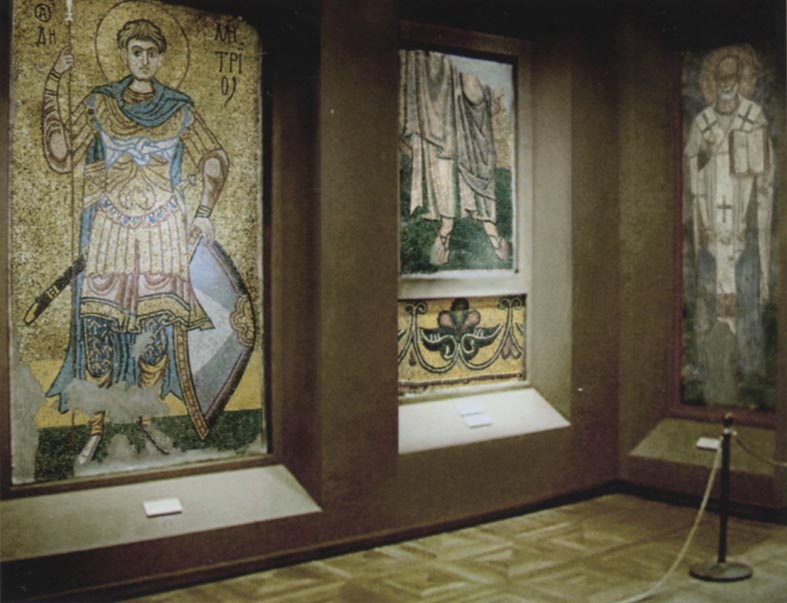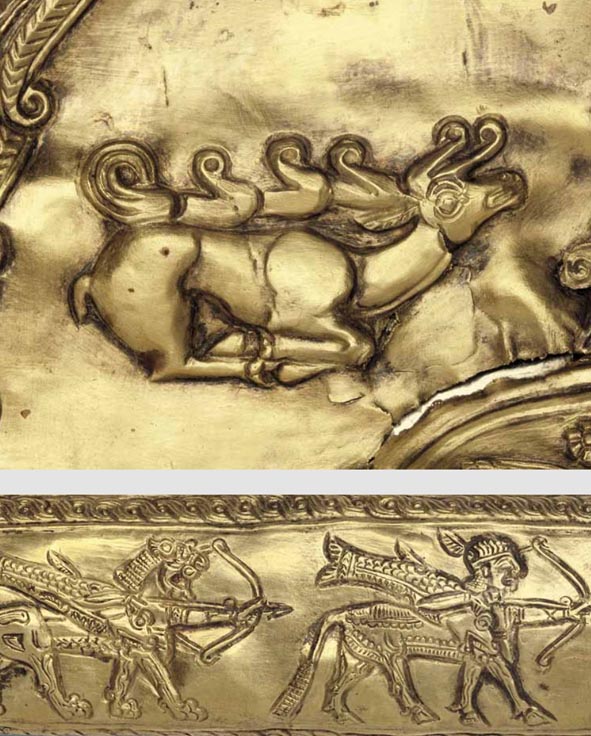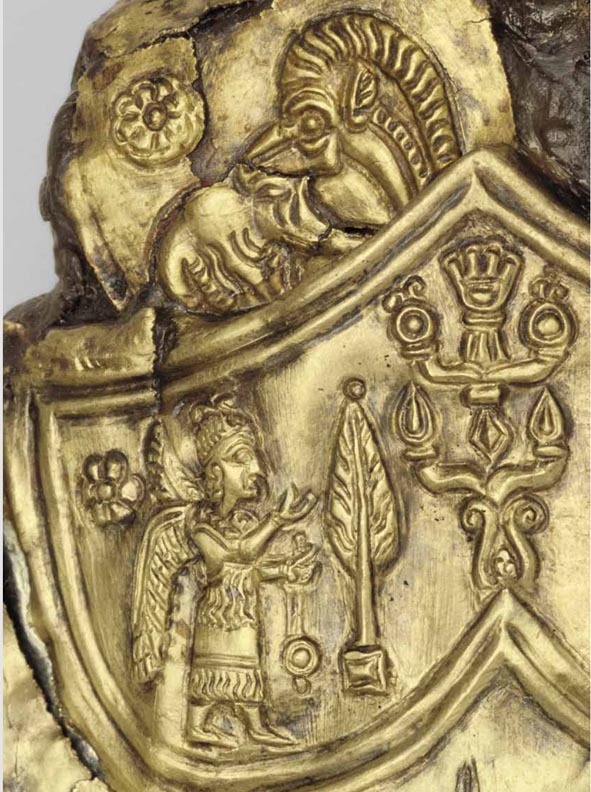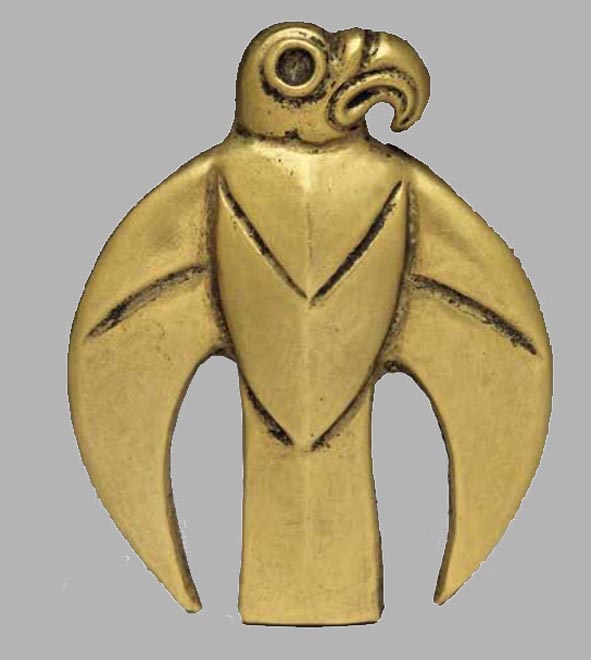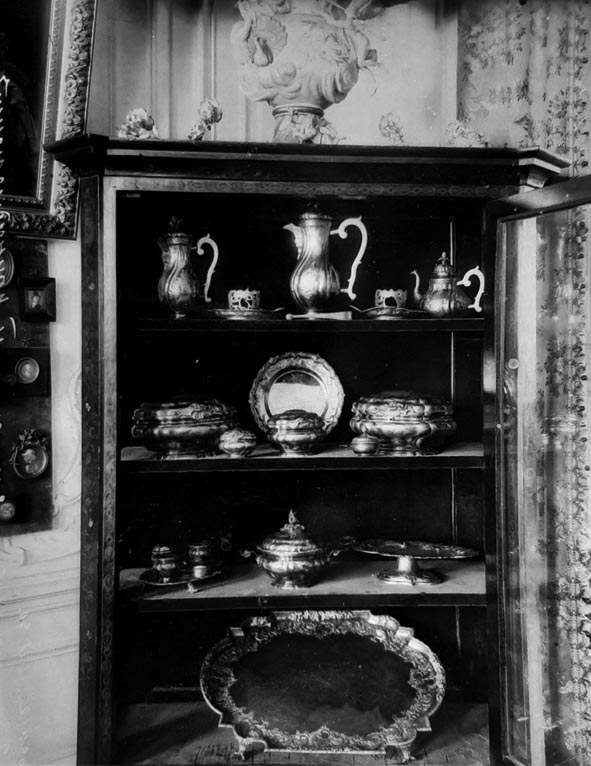«Археологічна спадщина, вкрадена Росією: інформаційно-просвітницька кампанія».
Настав час підбивати підсумки.
Тому, ми організували зустріч з командою проєкту, представництвом від Гете-інституту, дирекцією Музею Ханенків, музейниками та захисниками культурної спадщини.
Локація заходу не випадкова — Музей Ханенків, стіни якого вже вкотре змушені пустувати, а детективні історії повернення художніх цінностей якого, водночас захоплюють і надихають.
Євген Синиця та Анна Яненко представили результати проєкту, розповіли про імперські практики розграбування та варварське знищення культурної спадщини окупантами, що почалося ще з найперших досліджень археологічних пам’яток на нашій землі. А також трішки поділилися закуліссям: розповіли про неочікувані успіхи та перешкоди в реалізації проєкту.
Олена Живкова, генеральна директорка Музею, розповіла про незаконне привласнення росіянами художніх творів з колекції Музею та історію повернення, щоправда не з музеїв країни-агресора.
Головний підсумок такий: ми лише на початку боротьби за наше минуле, а завдяки підтримці Збройних сил України, наших мужніх і незламних громадян, маємо сили рухатися далі — до нашої Перемоги, усе буде Україна!
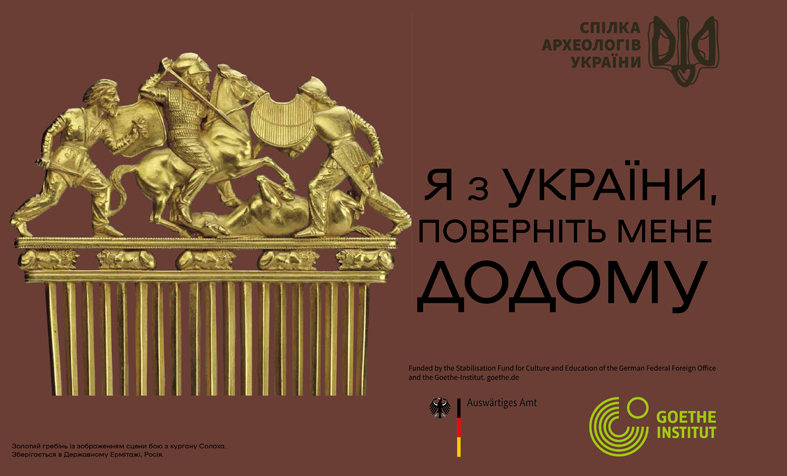
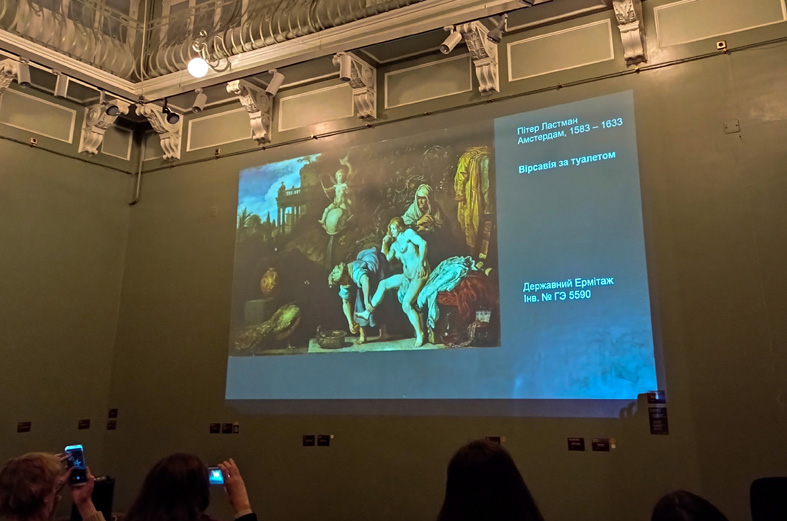
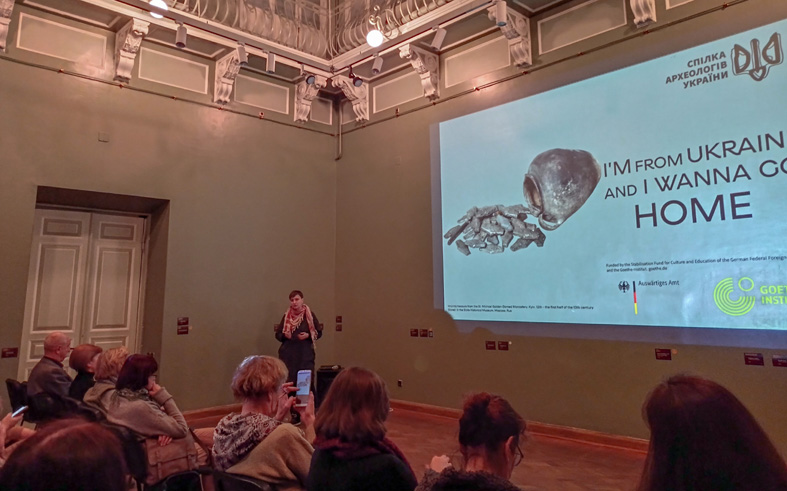
Анна Яненко, членкиня ВГО «Спілка археологів України» та авторка випуску 22 про Михайлівський Золотоверхий собор
розповідає про імперські практики грабування української культурної спадщини

Євген Синиця, голова ВГО «Спілка археологів України» представляє результати проєкту


Юлія Ваганова, директорка Національного музею мистецтв імені Богдана та Варвари Ханенків, звертається з вітальним словом
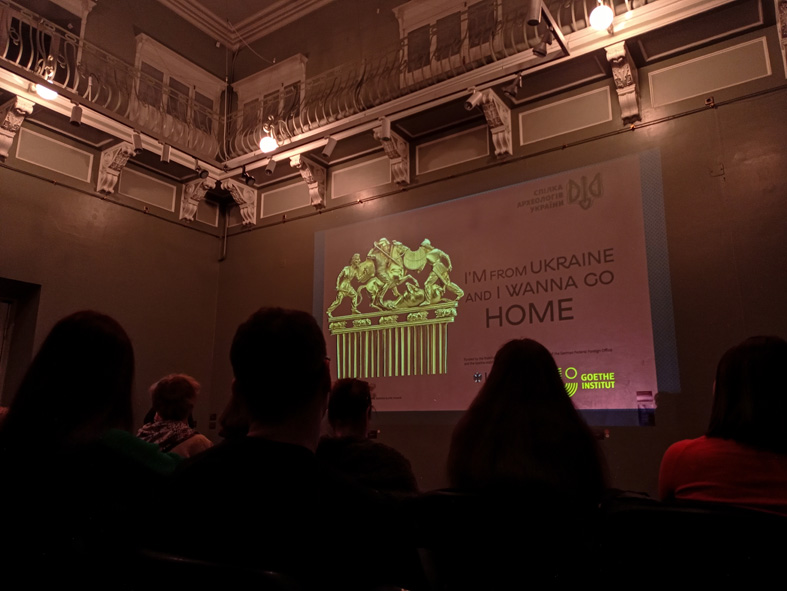
5.02.2023
Археологічна спадщина, вкрадена Росією: інформаційно-просвітницька кампанія
The archaeological heritage stolen by Russia: information and educational campaign Випуск 1
Культурна спадщина, зокрема й об’єкти матеріальної культури різних часів, відіграє фундаментальну й визначальну роль у формуванні національної ідентичності, збереженні традицій та цінностей. Питання привласнення, вивезення, викрадення, знищення українських культурних цінностей (зокрема археологічних знахідок) представниками Росії актуалізовано від початку повномасштабного вторгнення і пограбуванням низки українських музеїв (зокрема Мелітопольського). До цієї теми активно зверталися ЗМІ, реагували користувачі соцмереж тощо. Однак, звертаючи увагу на такі випадки, суспільство, здебільшого, не усвідомлює, що ці "пограбування" не окремі прикрі ситуації, а наслідки і результати системної багаторічної імперської політики Росії, спрямованої на привласнення українських культурних цінностей, переписування, а почасти й "вигадування" Росією зручної для неї історії України.
Тому протидія Росії на цьому напрямку гібридної війни є не менш важливою, ніж на реальному фронті. Дієвий спосіб такої протидії країні-терористу — реалізація інформаційно-просвітніх кампаній, а також імплементація інших елементів неформальної культурної освіти.
ВГО "Спілка археологів України" розпочинає проєкт "Археологічна спадщина, вкрадена Росією" — інформаційно-просвітницьку кампанію про "вкрадене", "знищене", "привласнене", "поцуплене", "переписане" російською імперією.
Ми привертатимемо суспільну увагу до питань системного вивезення українських історичних цінностей в Росію, висвітлюючи багатовікові імперські стратегії привласнення й плюндрування національних культур, розповідатимемо про «поцуплені» археологічні артефакти, "вкрадені" ідеї, "знищених" інтелектуалів тощо.
У кожному випуску – окрема історія: про виявлення археологічних знахідок, “механізм привласнення” Росією в дії, викрадення думок й результатів археологічних досліджень, викривлення історії, "викреслювання" людських доль тощо.
Команда проєкту "Археологічна спадщина, вкрадена Росією: інформаційно-просвітницька кампанія"
Release 1
Cultural heritage, in particular, tangible cultural properties from different periods, plays a fundamental and defining role in the formation of national identity as well as in the preservation of traditions and values. The issues of appropriation, removal, looting, and destruction of Ukrainian cultural values (including archaeological artifacts) by representatives of Russia have been mainstreamed since the beginning of the full-scale invasion and heists of a number of Ukrainian museums (for example, the Melitopol Museum). This topic has been actively discussed in mass media; it provoked the reaction of social network users, etc. However, paying attention to such cases, society, for the most part, is not aware that these “thefts” are not isolated unfortunate accidents, but the consequences and results of Russia’s systemic long-term imperial policy aimed at appropriating Ukrainian cultural values and rewriting and/or even "invention" Ukrainian history convenient to Russia.
The resistance to Russia in this direction of the hybrid war is no less critical than in the front of a real war. A practical method of countering the terrorist country is the implementation of informational and educational campaigns and other elements of informal cultural education.
The All-Ukrainian Public Association of Archaeologists NGO is launching the project "The archaeological heritage stolen by Russia”. It is an informational and educational campaign about the "stolen", "destroyed", "appropriated", "mutilated", and "rewritten" by the Russian Empire from the 18th century to nowadays.
We will draw public attention to the issues of the systematic export of Ukrainian historical treasures to Russia. We will highlight centuries-old imperial strategies of appropriation and plundering of national cultures, and we will talk about "poached" archaeological artifacts, "stolen" ideas, "destroyed" intellectuals, etc.
Each release contains a separate story about the discovery of archaeological items, the "mechanism of the appropriation" of values by Russia in action, the theft of ideas and archaeological research results, the distortion of history, the "erasing" of human lives, etc.
"The archaeological heritage stolen by Russia: information and educational campaign" project team
26.10.2022
Проєкт здійснено за підтримки Стабілізаційного фонду культури й освіти Федерального міністерства закордонних справ Німеччини та Goethe-Institut. goethe.de
The project is funded by the Stabilisation Fund for Culture and Education of the German Federal Foreign Office and the Goethe-Institut. goethe.de


Випуск 2
Привласнення Росією артефактів давньої української історії починається одночасно з першими системними розкопками в степах України — вже від другої половини XVIII ст. Однією з перших таких пам’яток став Мельгунівський курган (Лита могила).
З утворенням 1859 року в Петербурзі державної установи — Імператорської археологічної комісії (ІАК), — проведення польових досліджень (розвідок й розкопок) з метою, передовсім, збагачення колекцій старожитностей імперської метрополії набуло офіційного характеру.
Від 1889 року Комісія стала чи єдиною установою, що видавала “відкриті листи” (дозволи) на розкопки. Відповідно до зарегламентованих правил усі виявлені знахідки представлялися на розгляд Комісії, члени якої й вирішували їхню подальшу долю. Тож зібрання музеїв столиць імперії активно поповнювалися. До того ж доволі часто власне російські дослідники отримували право працювати на українських археологічних об’єктах.
Після встановлення радянської влади на теренах України, практика роботи росіян на українських пам’ятках і подальше вивезення артефактів продовжилась.
>Значно спростило й пожвавило вилучення й привласнення росіянами археологічної спадщини і давньої історії України системне нищення українства перших десятиліть Совєтів — переслідування інтелектуальних еліт, Голодомор, Великий терор, лінгвоцид тощо.
Місце репресованих кремлівською владою українських вчених часто посідали російські науковці, не гребуючи привласненням собі відкриттів, результатів досліджень, гіпотез, а інколи, й текстів попередників (детальніше дивіться виставку “Наказано не знати: українські археологи в лещатах тоталітаризму”)
Чимало артефактів — джерел для реконструкції давньої історії України — вилучили з українських музеїв й передали до Москви упродовж 1930-х рр. Деякі знахідки з колекцій українських музеїв, які нацисти вивезли в часи Другої світової війни, після повернення “дивовижним” чином знов-таки опинилися у Москві чи Ленінграді.
Після анексії Криму у 2014 році, ці ласі в археологічному сенсі території, стали об’єктом “пильної уваги” російських дослідників. Здебільшого колекції з незаконно розкопаних кримських пам’яток російські окупанти вивозять на територію країни-терориста.
Нині, під час широкомасштабного російського вторгнення, маємо документальні свідчення про вилучення (“евакуацію”) колекцій з музеїв, що знаходяться на тимчасово окупованих територіях, зокрема Криму, Херсонщини, Луганщини, Донеччини тощо.
к. і. н., зав. науковою бібліотекою ІА НАН України,
секретар Правління ВГО “Спілка археологів України”
Вікторія Колеснікова
Release 2
Russia started to appropriate artifacts of ancient Ukrainian history at the same time when the first systematic archaeological excavations began in the steppes of Ukraine, namely in the second half of the 18th century. The Melguniv kurgan (Lyta mogyla) was one of the first cases.
In 1859, a state institution the Imperial Archaeological Commission (IAC) was established in St. Petersburg. Since then, archaeological field studies (reconnaissance and excavations), aimed first at enriching the collections of antiquities of the Russian imperial metropolis, acquired an official character.
From 1889, the Commission became the institution that issued archaeological research permits or licenses (word for word “Open Letters”) to excavate. In accordance with the regulations, all discovered finds had to be presented to the Commission for consideration, whose members decided the further fate of artifacts. So the collections of the empire’s museums were actively replenished. In addition, actually Russian researchers quite often got permission to work on Ukrainian archaeological sites.
After the establishment of Soviet power in the territory of Ukraine, the practice of Russians working at Ukrainian archaeological sites and the subsequent removal of artifacts carried on. The systematic destruction of Ukrainians in the first decades of the Soviet era — the persecution of intellectual elites, the Holodomor (Great Famine), the Great Terror, lignvocide, etc. — simplified and boosted the removal and appropriation of the archaeological heritage and ancient history of Ukraine by the Russians.
The place of Ukrainian researchers repressed by the Kremlin authorities was often taken by Russian scientists, who did not feel squeamish about appropriating the discoveries, research results, hypotheses, and sometimes even the texts of their forerunners (for more information take a look at the exhibition "Ordered not to know: Ukrainian archaeologists in the jaws of totalitarianism").
Many artifacts — sources for the reconstruction of the ancient history of Ukraine — were removed from Ukrainian museums and transferred to Moscow during the 1930s.
Some items exported by the Nazis from Ukrainian museum collections during the Second World War, after the restitution in a "miraculous" way ended up in Moscow or Leningrad.
After the annexation of Crimea in 2014, these attractive archaeological territories became the focus of Russian researchers. For the most part, the collections from Crimean archaeological sites illegally excavated by the Russian occupiers were exported to the territory of Russia.
Now, during the full-scale Russian invasion, there is documentary evidence of the removal (“evacuation”) of collections from museums located within temporarily occupied territories, in particular, in Crimea, Kherson, Luhansk and Donetsk Regions.
Viktoriya Kolesnikova,
PhD in history, Head of the Scientific Library of Institute of Archaeology, the NAS of Ukraine,
Secretary of the Board of the Ukrainian Association of Archaeologists
Відкритий лист Імператорської археологічної комісії на дослідження території Овруччини (1911 р.)
із зазначенням вимоги щодо представлення найбільш цінних та цікавих предметів,
знайдених під час досліджень, на огляд імператора (з колекції Наукового архіву Інституту археології НАН України)
Open letter (permit) of the Imperial Archaeological Commission to conduct the study of the territory of Ovruch Region (1911)
containing the requirement to present the most valuable and interesting objects found during the research for the emperor's inspection
(from the Collection of the Scientific Archive of the Institute of Archeology of the National Academy of Sciences of Ukraine)
Зал Третьяковської галереї (Москва ) з мозаїками зруйнованого більшовиками Михайлівського Золотоверхого собору, вивезеними з Києва
(за Коренюк Ю. Мозаїки Михайлівського Золотоверхого собору. Каталог. Київ, 2013)
Exhibition hall of the Tretyakov Gallery in Moscow displays mosaics that had been removed from St. Michael Golden-Domed Cathedral destroyed by the Bolsheviks in Kyiv
(according to Yu. Korenyuk. Mozaics of St. Michael’s Golden-Domed Cathedral. Catalogue. Kyiv 2013)
Допис на російському інформаційному сайті про сенсаційні знахідки російських археологів в анексованому Криму, які поповнять не лише музеї Крима, а й інших регіонів Росії
(фото з матеріалу Радіо Свобода. Кримський автобан – 2020)
Post from Russian information website about the sensational finds of Russian archaeologists in the annexed Crimea, which will replenish not only the museums of Crimea,
but also of the other regions of Russia (according to “Radio Free Europe/Radio Liberty” material “Crimean Autobahn – 2020”)
Росіянин виносить награбоване з одного з Маріупольських музеїв (2022 р.) (фото з відкритих джерел)
A Russian takes out looted items from one of the Mariupol museums (2022) (photo from open sources)
31.10.2022
Випуск 3. Лита Могила: перші розкопки — перший грабунок
Вже понад 300 років ординська Московія прагне притулитися до європейської цивілізації. Вкравши разом з назвою історію Русі, хижий сусід й досі прихоплює наше культурне коріння, наповнює свої музеї археологічною спадщиною України. Власне такі яскраві старожитності, які є в нашій землі, на «болотах» відсутні. Час не змінює звички країни-загарбника. Прикладом тому є чергові нещодавні крадіжки — пограбовані росіянами колекції Мелітопольського, Маріупольського, Херсонського та інших музеїв…
А почалась ця ганебна практика ще у XVIII сторіччі з розкопок Литої Могили, що її чужинці нарекли Мельгуновським курганом. Це один з найвідоміших курганів. Його дослідження не лише поклало початок цілеспрямованим археологічним розкопкам на теренах Російської імперії, а й заклало підмурок вивчення старожитностей скіфів.
Роботи на Литій Могилі розпочали на початку вересня 1763 року з ініціативи генерал-поручика Олексія Мельгунова, засланого на південь імперії зміцнювати її нові кордони. Він був наближеним імператора Петра ІІІ, вбитого заколотниками. Тож не дивно, що Катерина ІІ, яка посіла престол по чоловікові, відіслала вельможу подалі від столиці.
Майже десятиметровий поховальний пагорб знаходився в урочищі Кучерові Байраки поблизу Єлисаветграду (тепер — Кропивницький). В теперішніх реаліях — це місцина між селами Топили та Копані Трепівської сільської ради Знам’янського району Кіровоградщини.
Родзинкою пам’ятки став скарб, що був знайдений в кам’яній скрині під верхівкою її насипу. Згадана скриня приховувала коштовні артефакти, виконані в ассиро-урартському стилі. Це залізний акінак з окутим золотом руків’ям в плакованих золотом дерев’яних піхвах, які вкриті зображеннями фантастичних тварин, срібні елементи від ассирійського палацового табурету, золота діадема, 17 масивних золотих платівок у вигляді орлів, платівки із зображеннями мавп та птахів, бронзова застібка із закінченнями у вигляді лев’ячих голівок, 40 бронзових вістрів стріл. Є всі підстави вважати, що ці предмети належать до другої половини VII ст. до н. е. і були військовими трофеями скіфів, добутими ними під час походів до Малої Азії.
Виявлення скарбу було фактично фіналом робіт започаткованих О. Мельгуновим, периферійна частина насипу Литої Могили залишалася непорушеною. Тож роботи з його дослідження поновлювалися ще двічі, наприкінці позаминулого та наприкінці минулого століть. І лише нещодавно, у 2019 році, експедиція Інституту археології НАН України поставила крапку у вивченні славетної пам’ятки.
З’ясувалося, що курган звели не скіфи, а їхні попередники на цих теренах. Початково основу поховальної споруди склали від 700 до 1000 м куб. дубових колод, привезених за 12—20 км з найближчих байраків. Купа колод, до яких додали ще й інше паливо, стала велетенським поховальним вогнищем, на якому спалили якогось-то достойника. Коштовні поховальні атрибути, що супроводжували елітного небіжчика, згоріли та розплавилися. Шматки ж оплавленої глиняної обмазки споруди, рясно траплялися в цій місцині здавна, що й відбилося в назві кургану.
Під час досліджень 2019 року археологам поталанило відшукати дві платівки з електруму (сплаву золота та срібла), що на диво збереглися у давньому полум’ї. Колись-то ці артефакти з орнаментацією притаманній культурам гальштатського кола, прикрашали стінки дерев’яної посудини. Саме вони дозволяють окреслити вірогідний час побудови Литої Могили. Лише століття, якщо не всі два, по тому скіфи, що тільки прийшли на ці терени, використали для певної культової відправи вже наявний в привабливому місці насип.
Чому саме там знаходиться курган пояснюють старі мапи. Виявляється, могилу спорудили біля найдавнішого шляху України, що в середні віки називали Чорним. Звели на ділянці, що змією в’ється вододілом між верхів’ями Інгульця та Інгулу. І не випадково за 16 км на схід від нього розташовувалося важливе в давнину Чорноліське городище. Цій давній магістралі зобов’язана своїм розташуванням і давня Ольвія, що виникла при броді-переправі через Бузький лиман. Проте, задовго до купців-греків, до городищ Середнього Дніпра цим шляхом ходили торгівельні каравани їх попередників з городища Дикий Сад (м. Миколаїв), що функціонувало за часів кіммерійців.
Втім, повернемося від досліджень ХХІ століття до “досліджень” століття ХVІІІ. Скарб з Литої Могили змінив долю опального царедворця, як змінив і назву пам’ятки. Курган отримав другу назву — Мельгуновський, а Катерина ІІ пробачила Олексію Мельгунову його колишню наближеність до Петра ІІІ.
Знахідки з Литої Могили спочатку потрапили до петербурзької Кунсткамери, звідки їх — у 1859 і 1894 рр. — передали до Ермітажу, де й досі перебуває частина цієї колекції. Позаяк, деякі речі 1932 року все ж таки повернули Україні (до музею Харкова), але ці артефакти загинули під час невдалої спроби евакуації колекцій Харківського історичного музею до Уфи в часи Другої Світової війни.
Насамкінець залишається лише зауважити, що поцуплений скарб дійсно доречно називати Мельгунівським, а самому ж кургану повернути узвичаєну українську назву — Лита Могила.
Болтрик Юрій Вікторович,
кандидат історичних наук, завідувач відділу,
Інститут археології НАН України
Release 3. Lyta Mohyla: the first excavations and the first robbery
For more than 300 years, Horde Muscovy has sought to attach to the European civilization. Having stolen the history of Kyivan Rus along with its name, the predatory neighbour still tries to appropriate our cultural roots and replenish its museums with the archaeological heritage of Ukraine. Actually, “in the swamps”, there are no such striking antiquities as those hidden in our land. The habits of the invading country have not changed with time. Another example is the recent looting of the museums in Melitopol, Mariupol, Kherson and other cities by the Russians... This disgraceful practice started back in the 18th century with the excavations in Lyta Mohyla (Cast Tumulus), which foreigners called the Melgunovsky Kurgan. This is one of the most famous burial mounds. Its research not only marked the beginning of focused archaeological excavations in the territory of the Russian Empire but also laid the foundation for the study of Scythian antiquities.
Work on the Lyta Mohyla started at the beginning of September 1763 at the initiative of Lieutenant General Oleksiy Melgunov, who was sent to the south of the empire to strengthen its new borders. He was close to Emperor Peter III, killed by rebels. Therefore, it is not surprising that Catherine II, who succeeded her husband, sent the nobleman away from the capital.
An almost ten-meter burial mound was located in the Kucherovi Bayraky tract near Yelysavetgrad (now Kropyvnytskyi City). In current realities, this is the area between Topyla and Kopani villages of the Trepiv village council in the Znamyansky district of the Kirovohrad region.
The highlight of the Site was the treasure, found in a stone cist under the top of the mound. The aforementioned cist hid precious artifacts made in the Assyrian and Urartian style. These were an iron akinake-sword with a handle covered with gold in a gold-plated wooden scabbard, decorated with images of fantastic animals; silver elements of a stool from an Assyrian palace; a gold diadem; 17 massive gold plates in the form of eagles; plates with images of monkeys and birds; a bronze clasp with endings in the form of lion heads; and 40 bronze arrowheads. There is every reason to believe that these artifacts belong to the second half of the 7th century BC. and were military trophies of the Scythians got during their campaigns in Asia Minor.
The discovery of the treasure happened in fact, at the final stage of the excavations started by Oleksiy Melgunov. The peripheral part of the Lyta Mohyla mound remained intact. Therefore, its research was renewed twice more, at the end of the last century and at the end of the century before the last. Only recently, in 2019, the expedition of the Institute of Archeology of the National Academy of Sciences of Ukraine put an end to the study of the famous site.
It turned out that the mound was built not by the Scythians but by their predecessors in these areas. Initially, 700 to 1000 m sq. of oak logs have been brought 12—20 km away from the nearest ravines to compose the basis of the burial structure. A gigantic funeral pyre of some worthy person was made of this pile of logs and other fuel. The precious funeral paraphernalia that accompanied the elite deceased burned and melted. Pieces of the fused clay coating of the funeral construction were often found in this area long since, which was reflected in the name of the mound.
During research in 2019, archaeologists were lucky enough to find two plates made of electrum (a gold and silver alloy), surprisingly preserved in the ancient pyre. Once, these artifacts with ornamentation typical of the cultures of the Hallstatt circle decorated a wooden vessel. They allow us to outline the likely time of construction of the Lyta Mohyla. Only a century, or maybe two, after that, the Scythians, who had just come to these areas, used the mound already existing in this attractive place for a certain religious ceremony.
Old maps explain why the mound is located there. It turns out that the grave was built near the oldest road in Ukraine, which in the Middle Ages was called Black Route. It was built on the site winding through the watershed between the upper reaches of the Ingulets and Ingul rivers. An important ancient Chornolis settlement was located 16 km to the east not accidentally. Ancient Olbia founded near the ford-crossing across Bug liman also owes its location to this ancient highway. However, long before the Greek merchants, the trading caravans of their predecessors from the Dykiy Sad settlement (Mykolaiv City) have travelled to the settlements of the Middle Dnipro this way since the time of the Cimmerians.
Anyway, let us go back from the research of the 21st century to the “research” of the 18th century. The treasure from the Lyta Mohyla changed the fate of the disgraced royal courtier, as well as changed the name of the Site. The mound got its second name — Melgunovsky Kurgan, and Catherine II forgave Oleksiy Melgunov for his former closeness to Peter III.
The finds from the Lyta Mohyla first were transferred to the Kunstkamera in St. Petersburg, and then to the Hermitage in 1859 and 1894. The part of this collection is still kept there. However, some items were returned to Ukraine in 1932 (to the Kharkiv Museum). These artifacts perished during the unsuccessful attempt to evacuate the collections of the Kharkiv Historical Museum to Ufa during the Second World War.
It remains only to note that it would be appropriate to call the stolen treasure Melgunivskyi treasure and to return the usual Ukrainian name of Lyta Mohyla to the burial mound itself.
Boltryk Yurii,
PhD, Head of the Department,
the Institute of Archaeology,
the National Academy of Sciences of Ukraine
Залізний меч у піхвах із золотими плакуванням. VII ст. до н. е. Місце знахідки: Лита Могила, Наддніпрянщина, Україна.
Місце збереження: музей Державний Ермітаж, Санкт-Петербург, Росія. Інв. № Дн 1763 1/19, 20
Iron sword in a gold-plated scabbard. The 7th c. BC. Place of discovery: Lyta Mohyla, Dnipro Region, Ukraine.
Place of storage: State Hermitage Museum, St. Petersburg, Russia. Inv. Nr. DN 1763 1/19, 20
|
Елементи декору на золотих обкладках піхов. VII ст. до н. е. Лита Могила, Наддніпрянщина, Україна. Місце збереження: музей Державний Ермітаж, Санкт-Петербург, Росія. Decoration elements on the golden plates of the scabbard. The 7th c. BC. Place of discovery: Lyta Mohyla, Dnipro Region, Ukraine. Place of storage: State Hermitage Museum, St. Petersburg, Russia. Inv. Nr. DN 1763 1/19, 20 |
Діадема. VIII—VII ст. до н. е. Лита Могила, Наддніпрянщина, Україна. Місце збереження: музей Державний Ермітаж, Санкт-Петербург, Росія. Інв. № Дн 1763 1/18
Diadem. The 8th—7th cc. BC. Place of discovery: Lyta Mohyla, Dnipro Region, Ukraine. Place of storage: State Hermitage Museum, St. Petersburg, Russia. Inv. Nr. DN 1763 1/18
Діадема, деталь. VIII—VII ст. до не. Лита Могила, Наддніпрянщина, Україна. Місце збереження: музей Державний Ермітаж, Санкт-Петербург, Росія
Diadem, fragment. The 8th—7th cc. BC. Place of discovery: Lyta Mohyla, Dnipro Region, Ukraine. Place of storage: State Hermitage Museum, St. Petersburg, Russia
Орнітоморфна золота платівка. VII ст. до н. е. Місце знахідки: Лита Могила, Наддніпрянщина, Україна. Місце збереження: музей Державний Ермітаж, Санкт-Петербург, Росія.
Інв. № Дн 1763 1/10
Ornithomorphic gold plate. The 7th c. BC. Place of discovery: Lyta Mohyla, Dnipro Region, Ukraine. Place of storage: State Hermitage Museum, St. Petersburg, Russia. Inv. Nr. DN 1763 1/10
Відновлений насип кургану «Лита Могила» та пам’ятний знак. с. Копані Кропивницький район, Кіровоградська область, Україна
Reconstructed Lyta Mohyla Mound and commemorative sign in Kopani village of Kropyvnythskyi district, Kirovohrad region, Ukraine
5.11.2022
Випуск 4
«Кропив’янський» («Полтавський») ритон, напевне чи не перша знахідка, що була віднайдена в Україні та потрапила до російського музею. В колишньому Імператорському, а зараз Державному Ермітажі, в Росії зберігається срібний, з позолотою ритон — посудина для споживання напоїв (чи, можливо, ритуальних узливань), у формі вигнутого рогу, який завершується зображенням передньої частини коня. Знахідку, разом з іншими речами, виявили 1746 р. в межах Кропив’янської сотні Переяславського полку. Відповідно до офіційних документів, її знайшли пастухи в піску, однак є і версія, що ритон походить з поховання у кургані, з якого добували селітру.
Ритон був вивезений російськими можновладцями до Санкт-Петербурга, й потрапив до академічної Кунсткамери. Пізніше знахідка поповнила колекцію імперського Ермітажу, де її зберігають і сьогодні під назвою «Полтавський» ритон. Першу публікацію цієї непересічної знахідки 1916 року зробив знаний український археолог, мистецтвознавець та пам’яткоохоронець Микола Макаренко (1877—1938).
Маса «Кропив’янського» ритону, виготовленого у IV ст. до н. е. найімовірніше у Фракії, складає щонайменше 902 грами.
Детальніше про знахідку: Макаренко, Н. 1916. Материалы по археологии Полтавской губернии. II. Серебряный ритон случайной находки в «Кропивянской сотне Переяславского полку». Труды Полтавской ученой архивной комиссии, вып. 14.
Юрій Пуголовок,
кандидат історичних наук,
заступник Голови правління ВГО “Спілка археологів України”
Release 4
Rhyton of Kropyvna (Poltava) is hardly the first archaeological find that was found in Ukraine and ended up in a Russian museum. The silver gilded rhyton is kept in the former Imperial, and now the State Hermitage Museum in Russia. It is a vessel for drinking made in the form of a curved horn, which ends with a horse’s front part image. The find, along with other items, was discovered in 1746 within the boundaries of the Kropyvna Sotnia of the Pereyaslav regiment. According to official documents, it was found by shepherds in the sand, but there is also a version that the rhyton comes from a burial mound, where saltpetre was mined.
Rhyton was taken by the Russian authorities to St. Petersburg, to the Academic Kunstkamera. Later, the artifact became part of the Imperial Hermitage collection, where it is still kept under the name of the Rhyton of Poltava. The first publication of this extraordinary find was made by Mykola Makarenko, the well-known Ukrainian archaeologist, art critic and heritage conservator (1877—1938).
The mass of the Rhyton of Kropyvna, probably made in Thrace, is more than 902 grams. Archaeologists date the find to the 4th century BC.
Yurii Puholovok,
PhD, deputy chairman of The All-Ukrainian Рublic Association of Archaeologists
|
«Кропив’янський» («Полтавський») ритон 4 ст. до н. е., знайдений поблизу містечка Кропивна, 1746 року. Rython of Kropyvna (Poltava), 4th c. BC, found in the surroundings of Kropyvna town, 1746. |
8.11.2022
Випуск 5. Справа «скіфського золота» в Амстердамі
Колекція експонатів з «виставки скіфського золота» перебуває в заручниках судової тяганини вже понад 8 років. На відміну від інших історій, про які розповідає кампанія «Археологічна спадщина, вкрадена Росією», ці артефакти поки що не вкрадено. Вони зберігаються у сховищі музею Алларда Пірсона в столиці Нідерландів, доки росія намагається привласнити їх через суд.
Виставку із офіційною назвою «Крим: золото й таємниці Чорного моря» спершу відкрили в Бонні 2013-го, наступного року вона переїхала в Амстердам до музею Алларда Пірсона. Там проєкт тривав з 7 лютого по 31 серпня 2014 року. Неформальну назву — «виставка скіфського золота» — ЗМІ підхопили у 2014-му, хоч насправді не всі предмети — скіфські, й не всі — золоті. До проєкту долучилися 5 інституцій: Національний музей історії України та чотири кримських музеї.
Всі 19 предметів з колекції Історичного музею успішно повернулися до Києва невдовзі по завершенню виставки.
А от доля решти експонатів після анексії півострова склалась інакше. Музей Алларда Пірсона заявив, що кримські експонати залишаються на зберіганні до визначення права власності у судовому порядку. В листопаді 2014 року російська сторона від імені кримських музеїв подала позов із вимогою повернути експонати на півострів, а на початку 2015 у судовий процес вступила держава Україна. Відтоді відбулось декілька судових слухань. Українські представники наполегливо доводять: усі ці речі є об'єктами державної частини Музейного фонду України, а виключне право розпоряджатися своїм культурним надбанням має держава, якій і мають повернути експонати. Російська сторона, формально не беручи участі в процесі, наполягає, аби експонати повернули до кримських музеїв. 26 жовтня 2021 року Апеляційний суд Амстердама ухвалив рішення на користь України. Проте вже у січні 2022 року росія, знову руками кримських музеїв, спробувала оскаржити це у Верховному суді Нідерландів. Нині відомо, що нідерландська юридична фірма відмовилась представляти російську сторону і що позивачі не надали розширені письмові пояснення у відведені терміни. І хоч це дає приводи для оптимізму, впевнитись у ньому можна буде лише після остаточної ухвали Верховного суду Нідерландів, сподіваємось — вже наступного року.
Виставкові матеріали з кримських музеїв налічують 565 предметів. Золоті артефакти та інші знахідки з археологічних комплексів ілюструють минувшину півострова від античності до раннього середньовіччя. Європейські партнери проєкту підготували й опублікували декілька каталогів виставки, надавши їй «постекспозиційного життя».
Познайомимо вас із деякими з експонатів.
Бахчисарайський історико-культурний заповідник надав для європейської виставки 215 предметів страховою вартістю 505700 євро. Серед них — багато матеріалів з некрополів сарматської доби та раннього середньовіччя. Унікальною частиною колекції є 3 китайські лакові шкатулки І ст. н. е. Вони походять з Усть-Альми, що неподалік Бахчисарая, де досліджено один з найбільших і найбагатших некрополів пізньоскіфської культури. Свого часу знахідка стала сенсацією, адже шкатулки подолали неймовірну відстань північною гілкою Шовкового шляху від Китаю до Криму. Скриньки протягом чотирьох років реставрували в Японії. Бахчисарайський заповідник передав і знахідки з інших комплексів — поховальні вінки, сформовані із вирізаних із тонкого золота листочків, прикраси античної доби, унікальні гунські коштовності, тощо.
З Керченського історико-культурного заповідника куратори відібрали для виставки 190 предметів страховою вартістю 582000 євро — насамперед, знахідки часів Боспорського царства та його столиці Пантикапея. Звідси до європейських музеїв вирушили античні барельєфи та теракоти, побутові предмети, розписний керамічний посуд, золоті прикраси часів від античності до середньовіччя. Серед них — скульптура «змієногої богині» І—ІІ ст. н. е. заввишки 124 см, що свого часу вважалась візитівкою Керченського заповідника. До пізнішого часу належать зразки спадщини кримських готів, зокрема матеріали першої половини V ст. н. е. з кургану Джург-Оба: сережки, намиста, прикраси з перегородчастою емаллю, тощо.
Національний заповідник «Херсонес Таврійський» передав на виставку 28 предметів страховою вартістю 187000 євро: значну кількість архітектурних деталей, а також епіграфічних пам’яток. Так, на 5 черепках-остраках із Херсонеса можна прочитати імена давніх херсонеситів: «Айгіномос», «Есандрос», «Еварксид, син Зенодота», «Демократеос» та «Евандридос». Серед експонатів представлено й цікавий фрагмент глиняної амфори із написом — частиною юридичного документа — торговельної угоди кінця І — ІІ ст. н. е.
Центральний музей Тавриди представив до експонування 32 предмети страховою вартістю 163925 євро. Серед знахідок — матеріали з досліджень Неаполя Скіфського — столиці Кримської Скіфії, найбільшого і найкраще дослідженого поселення пізньоскіфської культури. На кількох предметах є зображення тамги — родового або особистого знака в кочовиків Євразійського степу, народів Кавказу і Східної Європи. Тамга за часів Кримського ханства стала символом влади, а нині є одним із національних символів Криму. Культура кримських готів представлена знахідками з поховальних комплексів, наприклад — ремінною пряжкою зі срібла й заліза, оздобленою головою орла та інкрустованою склом. Вона походить з могили готської жінки VII ст. н. е., яку археологи дослідили в Лучистому неподалік Алушти.
Знайомство із матеріалами виставки вкотре засвідчує, що мультикультурний «плавильний котел» різних народів — півострів Крим — ніколи не втрачав зв’язків із континентом. Сподіваємось, що переконливі аргументи української сторони у Верховному суді Нідерландів дозволять повернути колекцію державі. Як повернеться і Крим після деокупації, до українських музеїв якого нарешті вирушить колекція «скіфського золота».
Олена Оногда
Кандидатка історичних наук, членкиня ВГО «Спілка археологів України»,
представниця Національного музею історії України у складі делегації Міністерства культури України
на засіданні Окружного суду м. Амстердам (Королівство Нідерланди) за позовом держави Україна
до Амстердамського археологічного Музею Алларда Пірсона (5 жовтня 2016 р.)
Release 5. Case with “Scythian Gold” in Amsterdam
The collection of the “Scythian Gold” Exhibition has been held hostage to court proceedings for more than eight years. Unlike other cases described in the framework of the Archaeological Heritage Stolen by Russia Campaign, these artifacts have not yet been stolen. They are kept in the Allard Pearson Museum in the Dutch capital, while Russia tries to appropriate them through the courts.
The exhibition, officially named “Crimea: Gold and Mysteries of the Black Sea”, was first opened in Bonn in 2013. The following year it moved to Amsterdam to the Allard Pearson Museum. There, the project lasted from February 7 to August 31, 2014. Its informal name — “Scythian Gold Exhibition” — was picked up by the mass media in 2014, although, actually, not all exhibited objects are Scythian, and not all of them are gold. Five institutions joined the project: the National Museum of the History of Ukraine and four Crimean museums.
All 19 items from the collection of the Historical Museum successfully returned to Kyiv shortly after the exhibition ended.
However, the fate of the rest of the exhibits was different after the annexation of the peninsula. The Allard Pearson Museum stated that the Crimean exhibits should remain in storage until ownership is determined in court.
In November 2014, the Russian side filed a lawsuit on behalf of the Crimean museums demanding the return of the exhibits to the peninsula, and in early 2015, the state of Ukraine joined the legal process. Since then, several court hearings have taken place. Ukrainian representatives persistently prove that all these artifacts belong to the state part of the Museum Fund of Ukraine. These exhibits should be returned to the State which has the exclusive right to dispose of its cultural property. The Russian side, nominally not participating in the process, insists that the exhibits should be returned to the Crimean museums. On October 26, 2021, the Amsterdam Court of Appeals ruled in favour of Ukraine. However, already in January 2022, Russia tried to challenge this in the Supreme Court of the Netherlands, again using Crimean museums. It is known that the Dutch law firm refused to represent the Russian side and that the plaintiffs did not provide extended written explanations within the allotted time. Although this gives reasons for optimism, only after the final decision of the Supreme Court of the Netherlands will it be possible to make sure of it, hopefully — already next year.
Exhibition materials from Crimean museums number 565 items. Gold artifacts and other finds from archaeological sites illustrate the past of the peninsula from antiquity to the early Middle Ages. European partners of the project prepared and published several catalogues of the exhibition, giving it a “post-expositional life”.
We will introduce you to some of the exhibits.
The Bakhchysarai Historical and Cultural Preserve provided 215 items for a total insurance value of 505700,00 Euros for the European exhibition. Different materials from the necropolises of the Sarmatian era and the early Middle Ages are among them. Three unique Chinese lacquer boxes from the 1st century AD are part of the collection. They come from Ust-Alma, near Bakhchysarai town, where one of the largest and richest necropolises of the late Scythian culture was investigated. At the time, the discovery became a sensation, because the boxes had travelled an incredible distance along the northern branch of the Silk Road from China to Crimea. They were in restoration in Japan for four years. The Bakhchysarai Preserve also provided archaeological finds from other complexes — funeral wreaths made of leaves cut from thin gold, antique jewellery, unique Hun jewels, etc.
The curators selected for the Exhibition 190 items from the collection of the Kerch Historical and Cultural Preserve, for a total insurance value of 582 000,00 Euros. First of all, these were finds of the Bosporus Kingdom time and its capital Panticapaeia. Ancient bas-reliefs and terracottas, household items, painted ceramic ware, and gold jewellery from antiquity to the Middle Ages went to European museums. Among them is a Snake-Legged Goddess statuette of the 1st—2nd century AD with a height of 124 cm, which at one time was considered a visiting card of the Kerch Preserve. Samples of the Crimean Goths’ heritage belong to later times, in particular materials from the first half of the 5th century AD from the Jurg-Oba burial mound: earrings, necklaces, ornaments with partitioned enamel, etc.
The National Preserve “Tauric Chersonese” handed over 28 objects for a total insurance value of 187000,00 Euros for the exhibition: a significant number of architectural details, as well as epigraphic monuments. Among them are five ostracas (pieces of pottery) from Chersonese containing written names of the ancient Chersonesites: “Ayginomos”, “Esandros”, “Evarxis, son of Zenodotus”, “Demokratheos” and “Evandridos”. Among the exhibits is an interesting piece of a clay amphora with an inscription — a fragment of a legal document — a trade agreement dated the late 1st — 2nd century AD.
The Central Museum of Tavrida handed over 32 items to exhibit for a total insurance value of 163925,00 Euros. Among the finds are materials from the investigation of Naples of Scythia — the capital of Crimean Scythia, the largest and best-researched hill-fort of Late Scythian culture. Several items contain an image of tamga — a family or a personal sign of the Eurasian steppe nomads, the peoples of the Caucasus and Eastern Europe. During the time of the Crimean Khanate, the tamga became a symbol of power, and today it is one of the national symbols of Crimea. The Crimean Goths’ culture is represented by finds from burial complexes, for example, a belt buckle made of silver and iron, decorated with an eagle's head and inlaid glass. It was found in the grave of a Gothic woman of the 7th century AD, investigated by archaeologists in Luchyste village near Alushta.
Archaeological materials of the exhibition prove once again that the Crimean peninsula being a multicultural “melting pot” of different peoples, has never lost its ties with the continent. We hope that the convincing arguments of the Ukrainian side in the Supreme Court of the Netherlands will foster the return of the collection to the State. Just as Crimea will return after de-occupation, the Scythian Gold collection will finally come back to its Ukrainian museums.
Olena Onohda
PhD in history, member of the Ukrainian Association of Archaeologists,
representative of the National Museum of the History of Ukraine to the delegation of the Ministry of Culture of Ukraine
at the session of the District Court of Amsterdam (Kingdom of the Netherlands) on the claim of the State of Ukraine
against the Allard Pearson Museum of Antiquities in Amsterdam (October 5, 2016)

Сережки з поховання ІІ ст. до н. е. — кінця IV ст. н. е. Усть-Альмінський некрополь. Колекція Бахчисарайського історико-культурного заповідника
Earrings from a burial of the 2nd century BC — the end of the 4th century AD. Ust-Alminsky necropolis. Collection of the Bakhchisarai Historical and Cultural Preserve
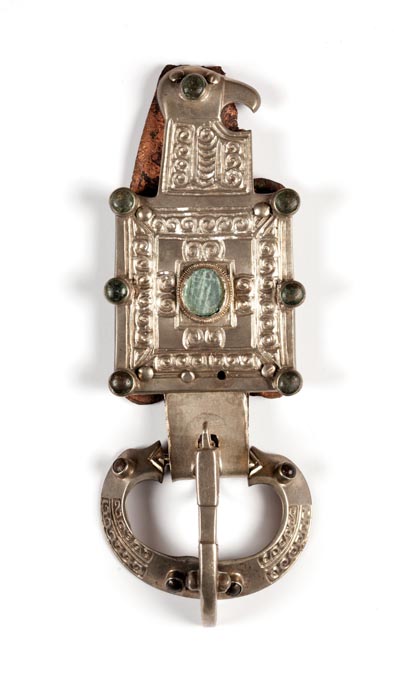
Пряжка. VII ст. н. е. Колекція Центрального музею Тавриди
Buckle. 7th century AD. Collection of the Central Museum of Tavrida

Китайська лакова шкатулка. І ст. н. е. Усть-Альмінський некрополь. Колекція Бахчисарайського історико-культурного заповідника
Chinese lacquer box. 1st century AD. Ust-Alminskyi necropolis. Collection of the Bakhchysarai Historical and Cultural Preserve
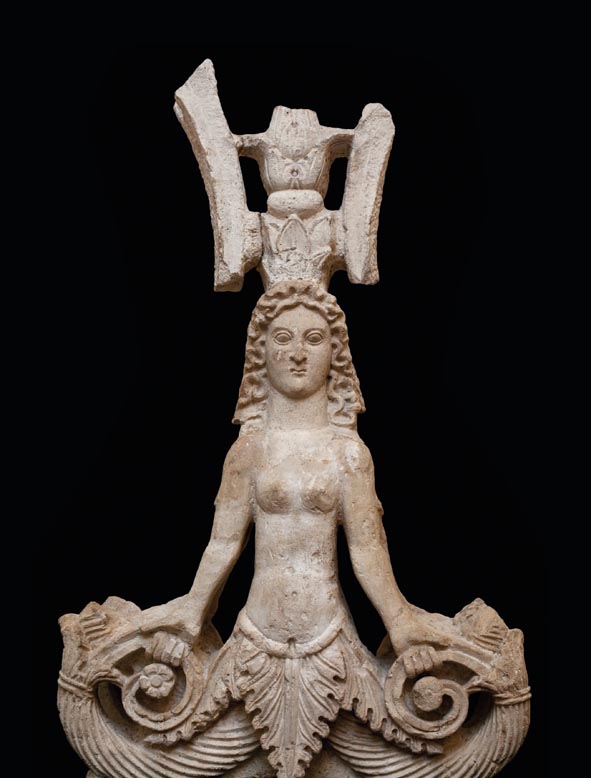
Скульптура «змієногої богині». І—ІІ ст. н. е. Колекція Керченського історико-культурного заповідника
Statuette of a Snake-Legged Goddess. 1st—2nd century AD. Collection of the Kerch Historical and Cultural Preserve
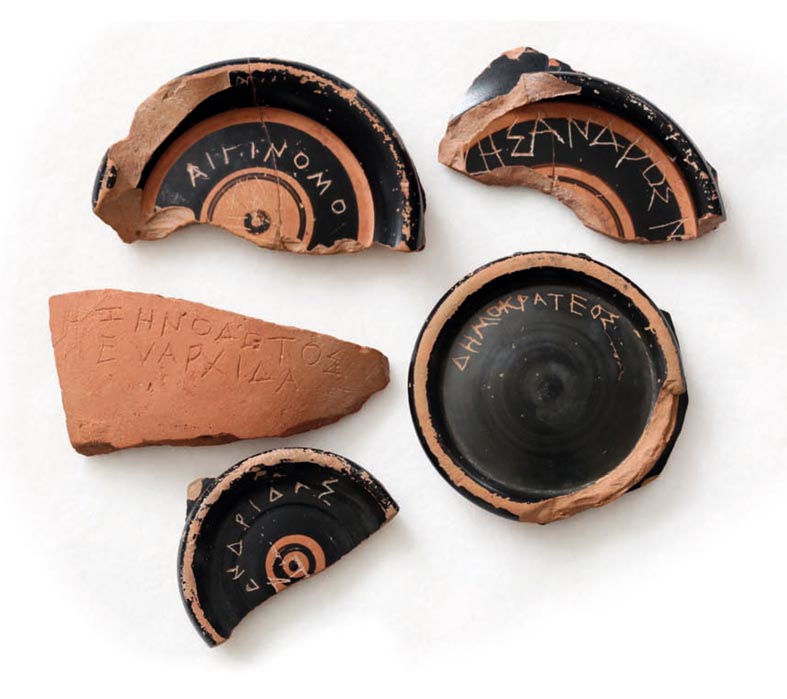
Остраки з Херсонеса. Колекція Національного заповідника «Херсонес Таврійський»
Ostracas (pieces of pottery) from Chersonesus. Collection of the National Preserve “Tauric Chersonese”
Source of illustrations: Die Krim: Goldene Insel im Schwarzen Meer: Griechen—Skythen—Goten. Bonn: LVR-LandesMuseum, 2014
20.11.2022
Випуск 6. Кам’яне мереживо. Вкрадене з Солхату
Історія грабунку кримських пам’яток Ермітажем сягає майже двохсот років: на території півострова працювала безліч археологічних експедицій з Санкт-Петербургу. Одна з найстаріших, що діє й тепер, — Старокримська археологічна експедиція державного Ермітажу. Тож не дивно що більшість знахідок, які походять із Солхату (середньовічне місто XIII—XV ст., що було столицею Кримського Юрту, тепер має назву Старий Крим), вивезені з Криму до Росії за сприяння імперських науковців.
Одним із найпоширеніших типів археологічних предметів з Солхату, привласнених Санкт-Петербургом, є різноманітні архітектурні елементи: різьбленні фрагменти споруд, надгробки, капітелі. Точна кількість знахідок, поцуплених з середньовічного Солхату, невідома. Знакові й найважливіші для репрезентації безперервного розвитку традицій місцевого населення є артефакти, якими росіяни хизувалися 2019 року на виставці «Золота Орда і Причорномор’я. Уроки Чингизидської імперії» в Казані.
Замкóвий камінь, за припущенням керівника експедиції Ермітажу в Старому Криму — Марка Крамаровського, був частиною арки медресе Солхату — найдавнішого мусульманського релігійно-просвітницького закладу на території півострова, побудованого в 1332—1332 роках коштом меценатки Інджи-Бек-Хатун. Залишки автентичного архітектурного оздоблення медресе майже не збереглися до часу археологічних досліджень, і камінь, виявлений під час розкопок наприкінці 1980-х років, є чи не єдиним свідченням запозичень з архітектури Румського султанату (Мала Азія), що розпався за два десятиліття до будівництва медресе.
Інший замкóвий камінь, віднайдений під час розкопок 1987/1990 років, походить з мавзолею кінця XІV — початку XV століття. На камені закарбовано ім’я Махмуда ібн Османа аль-Ірбілі, остання частина якого (нісба) вказує на походження архітектора з міста Ірбіль (Ербіль) в сучасному Іраку. Цікаво, що імовірний зодчий мечеті Узбека (1314 р.) — Абдул-Азіз аль-Ірбілі, судячи з нісби, також походив з давнього міста в Месопотамії, що пояснює ранні прояви сельджукської архітектури в Криму.
Якщо переміщення попередніх двох архітектурних елементів із Солхата в Санкт-Петербург вкладається в логіку радянської музейної системи, то привласнення Ермітажем різьбленого блоку, імовірно з облицювання порталу медресе першої чверті XIV століття, нагадує кримінальні хроніки. Під час розкопок кургану Кємаль-Ата в 1994—1996 роках дослідили чоловіче поховання, яке частина дослідників пов’язує із Мамаєм, перекрите двома плитами, покладеними на ребро. Однією з цих плит і була повторно використана плита з облицювання медресе. Цей різьблений камінь із малоазійським орнаментом 2018 року, вже після окупації Криму, «поступив» зі Старокримської археологічної експедиції до Ермітажу. Протягом 24 років один з небагатьох архітектурних елементів першої медресе в Солхаті не передавали до музейних колекцій, а «зберігали», що вчергове ілюструє «російську турботу» про культурну спадщину захоплених територій.
Вже згадану виставку «Золота Орда і Причорномор’я. Уроки Чингизидської імперії» без перебільшень можна назвати квінтесенцією колоніальної політики — презентацією привласненої культурної спадщини поневолених народів. Замкóві камені з медресе Солхату та мавзолею XV століття, різьблений блок з облицювання порталу медресе, капітелі — це не просто архітектурні елементи, а ілюстрація культурних зв’язків середньовічного Солхату із Месопотамією, Золотою Ордою, Анатолією (сучасна Туреччина). Тож вилучення таких предметів з території їх походження, вириває історію Криму з європейського та азійського контекстів. Натомість утворюється все більше місця для міфу про «російський Крим», який старанно поширюють для широкого загалу.
Яшний Денис,
кандидат історичних наук, провідний науковий співробітник Національного заповідника "Києво-Печерська лавра",
аналітик ГО "Кримський інститут стратегічних досліджень"
Release 6. Stone lace. Stolen from Solkhat
The history of looting Crimean monuments by the Hermitage goes back almost two hundred years: many archaeological expeditions from St. Petersburg worked on the peninsula. One of the oldest, still active, is the Staryi Krym Archaeological Expedition of the State Hermitage. Therefore, it is not surprising that most of the finds originating from Solkhat (a medieval city of the 13th—15th centuries, which was the capital of the Crimean Yurt, now called Staryi Krym) were taken from the Crimea to Russia with the assistance of imperial scientists.
Among the most common types of archaeological artifacts from Solkhat, appropriated by St. Petersburg, are various architectural elements: carved fragments of buildings, tombstones, capitals. The exact number of discoveries nicked from medieval Solkhat is unknown. The artifacts that Russians flaunted in 2019 at the exhibition “The Golden Horde and the Black Sea Region. Lessons of the Chingizid Empire” in Kazan are the most iconic and important for the representation of the continuous development of the local traditions.
According to Mark Kramarovsky, the Head of the Hermitage expedition in the Staryi Krym, the keystone was part of the arch of the Solkhat madrasa, the oldest Muslim religious and educational institution on the territory of the peninsula, constructed in 1332—1332 at the expense of the patroness Inji-Bek-Hatun.
The authentic architectural decoration of the madrasa was almost not preserved until the time of archaeological research, and the keystone discovered during excavations in the late 1980s is hardly the only evidence of borrowings from the architecture of the Rum Sultanate (Asia Minor), which fell apart two decades before the construction of the madrasa.
Another keystone, found during excavations in 1987/1990, comes from a mausoleum of the late 14th — early 15th century. The name of Mahmud ibn Osman al-Irbili is engraved on the stone. The last part of his name (nisba) indicates the origin of the architect from the city of Irbil (Erbil) in modern Iraq. It is interesting that the alleged architect of the Uzbek mosque (1314), Abdul-Aziz al-Irbili, judging by the nisba, also came from an ancient city in Mesopotamia, which explains the early manifestations of Seljuk architecture in the Crimea.
If the transfer of the previous two architectural elements from Solkhat to St. Petersburg fits into the logic of the Soviet museum system, then the appropriation by the Hermitage of a carved block, presumably from the cladding of the portal of a madrasa dated the first quarter of the 14th century, reminds criminal chronicles. During the excavations of the Kemal-Ata burial mound in 1994—1996, a male burial that some researchers associate with Mamai was investigated. Two slabs placed on the edge covered the burial. One of them was a reused slab from the madrasa cladding. In 2018, already after the occupation of Crimea, this carved stone with Asia Minor ornament “came” to the Hermitage from the Staryi Krym Archaeological Expedition. For 24 years, one of the few architectural elements of the first madrasa in Solkhat was not transferred to museum collections, but “preserved”, which once again illustrates “Russian care” for the cultural heritage of the occupied territories.
The already mentioned exhibition “The Golden Horde and the Black Sea Region. Lessons of the Chingizid Empire” without exaggeration can be called the quintessence of colonial policy — a presentation of the cultural heritage appropriated from enslaved peoples. Keystones from the Solkhat madrasa and mausoleum of the 15th century, a carved block from the cladding of the madrasa portal, and capitals are not just architectural elements, but an illustration of the cultural ties between medieval Solkhat and Mesopotamia, the Golden Horde, and Anatolia (modern Turkey). Therefore, the removal of such artifacts from the territory of their origin cut out the history of Crimea from the European and Asian contexts. Instead, the myth of “Russian Crimea” takes up more and more space, being diligently disseminated to the public.
Denys Yashnyi,
PhD, research fellow of National Preserve "Kyiv-Pechersk Lavra",
analist of the NGO "Crimean institute of strategic studies"
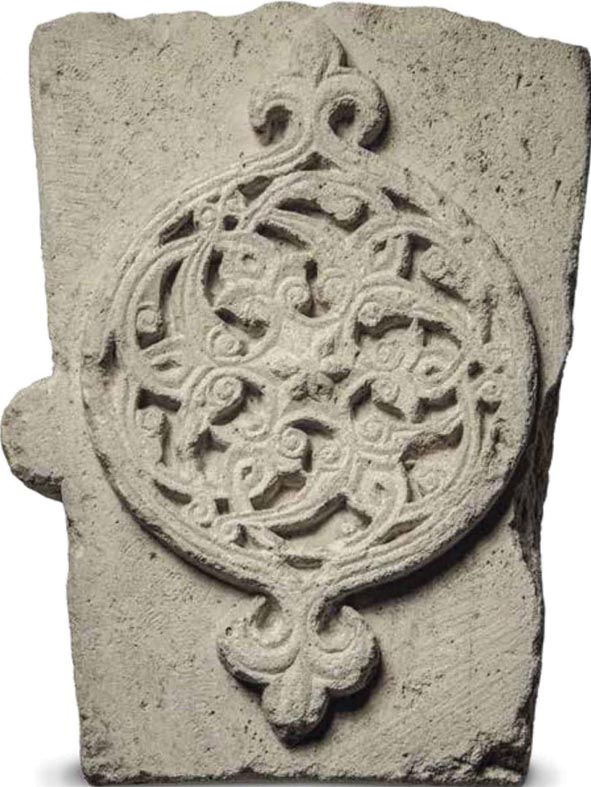
Замкóвий камінь. Золота Орда. Крим. Солхат. З розкопок мавзолею кінця XІV —
початку XV ст. (1987/1990 рр.) «Державний Ермітаж» інв. № Сол-157
Keystone. Golden Horde. Crimea. Solkhat. From the excavations of the mausoleum of the late 14th —
early 15th (1987/1990) State Hermitage inv. Nr. Sol-157
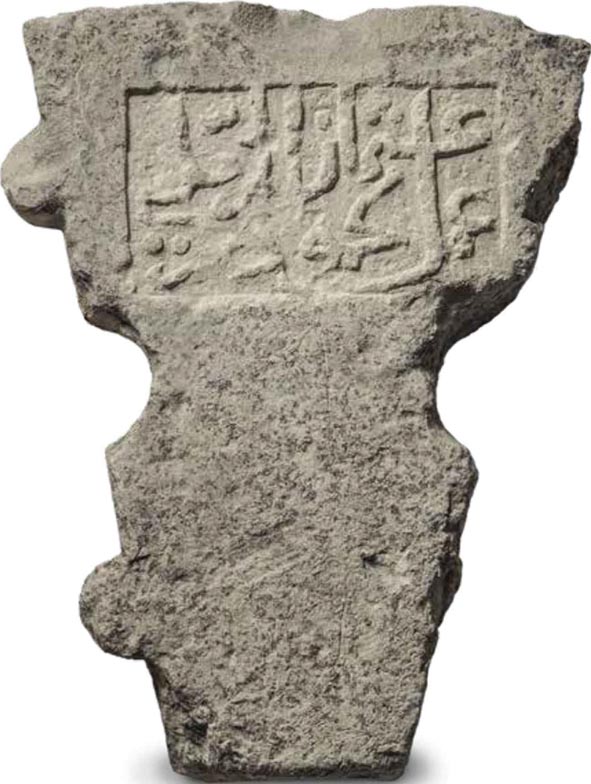
Замкóвий камінь з ім’ям Османа. Золота Орда. Крим. Солхат. З розкопок медресе XІV ст. (1980-і рр.) «Державний Ермітаж» інв. № Сол-156
Keystone with engraved name of Osman. Golden Horde. Crimea. Solkhat. From the excavations of the madrasa of the 14th century (the 1980s)
State Hermitage inv. Nr. Sol-156

Різний блок. Золота Орда. Крим. Солхат. З розкопок кургану Кемаль-Ата (1994—1996 рр.)
«Державний Ермітаж» інв. № Сол-168
Carved stone block. Golden Horde. Crimea. Solkhat. From the excavations of the Kemal-Ata burial mound
(1994—1996) State Hermitage inv. Nr. Sol-168
Source of illustrations:
Золотая Орда и Причерноморье: уроки Чингисидской империи: каталог выставки, [2 апреля — 6 октября 2019 г., Казань] / авт. вступ. ст. М. Г. Крамаровский.
Golden Horde and Black Sea Region: Lessons of Chingizid Empire: exhibition catalogue, [April 2 — October 6, 2019, Kazan] / Mark Kramarovsky, author of the introductory article
25.11.2022
Випуск 7. Вітова могила
У 1888 році український археолог Іван Зарецький дослідив курган Вітова могила, неподалік Опішні, в долині р. Мерла, де виявив багате воїнське поховання рубежу VI—V ст. до н. е. Земляний насип цієї поховальної споруди вирізнявся розмірами на тлі інших курганів в околиці. Поховання супроводжувалося значною кількістю інвентарю, що вказувало на високий соціальний статус похованого.
Серед знахідок — предмети озброєння, у тому числі сагайдак з берести, обтягнутий хутром й прикрашений композицією із золотих бляшок, виконаних у скіфському звіриному стилі. Центральне місце посідала велика кругла опукла бронзова бляха, вкрита золотом. По верхньому краю сагайдака були нашиті одинадцять золотих бляшок у вигляді фігурок пантер з петельками на обороті, по низу — шість золотих бляшок у вигляді фігурок гірських козлів у галопі, з повернутими назад головами. По краю напівкруглого дна сагайдака містилося одинадцять золотих бляшок у вигляді орлиних головок із загнутим дзьобом, а чотири його кута оздобили маленькими круглими опуклими золотими бляшками-розетками. У сагайдаку виявили понад 200 бронзових наконечників стріл. У похованні також зафіксували деталі кінської вузди та інші предмети.
Проведені Іваном Зарецьким розкопки повністю вичерпали його фінансові ресурси та підірвали дослідницькі прагнення науковця. Він вдався до пошуку додаткових грошей деінде. Скориставшись скрутою українського вченого, Московське археологічне товариство нав’язало Іванові Зарецькому кредит, умовою погашення якого стало придбання Російським історичним музеєм у Москві звіту та всієї колекції знахідок майже за безцінь. У підсумку, речі з його розкопок й досі зберігаються у Державному історичному музеї, а документація розпрошена по різними архівним установам Росії.
Юрій Пуголовок,
кандидат історичних наук, заступник Голови правління ВГО “Спілка археологів України”
Release 7. Vitova Mohyla
In 1888, the Ukrainian archaeologist Ivan Zaretsky investigated the burial mound of Vitova Mohyla, located near Opishna, in the valley of the Merla River. A rich military burial dated around the turn of the 6th—5th century BC was discovered in it. The dimensions of the earthen mound of this burial structure distinguish it from other mounds in the vicinity. The burial contained a significant number of inventory, which indicated the high social status of the buried person.
Among the finds were weapons, including a saadak (quiver) made of birch bark and covered with fur. It was decorated with gold plaques composition made in the Scythian animalistic style. A large round convex bronze plate covered with gold was placed at the center. On the upper edge of the quiver were sewn eleven gold plaques in the form of figures of panthers with hooks on the reverse. Six gold plaques in the form of figures of mountain goats in a gallop, with their heads, turned back were sewn on the bottom. Along the edge of the semicircular bottom of the quiver were placed eleven gold plaques in the form of eagle heads with bent beaks, and at its four corners were small round convex gold rosette plaques. More than 200 bronze arrowheads were found in the quiver. Fragments of a horse bridle and other items were also discovered in the burial.
The excavations conducted by Ivan Zaretsky completely exhausted his financial resources and undermined the scientist's research aspirations. He tried to search for additional funding elsewhere. Taking advantage of the Ukrainian scientist's predicament, the Moscow Archaeological Society imposed a loan on Ivan Zaretsky. The loan terms were the purchase of the report and the entire collection of finds by the Russian Historical Museum in Moscow for almost nothing. As a result, artifacts from his excavations are still kept in the State Historical Museum, and the documentation is scattered among various Russian archival institutions.
Yurii Puholovok,
PhD, deputy chairman of The All-Ukrainian Рublic Association of Archaeologists
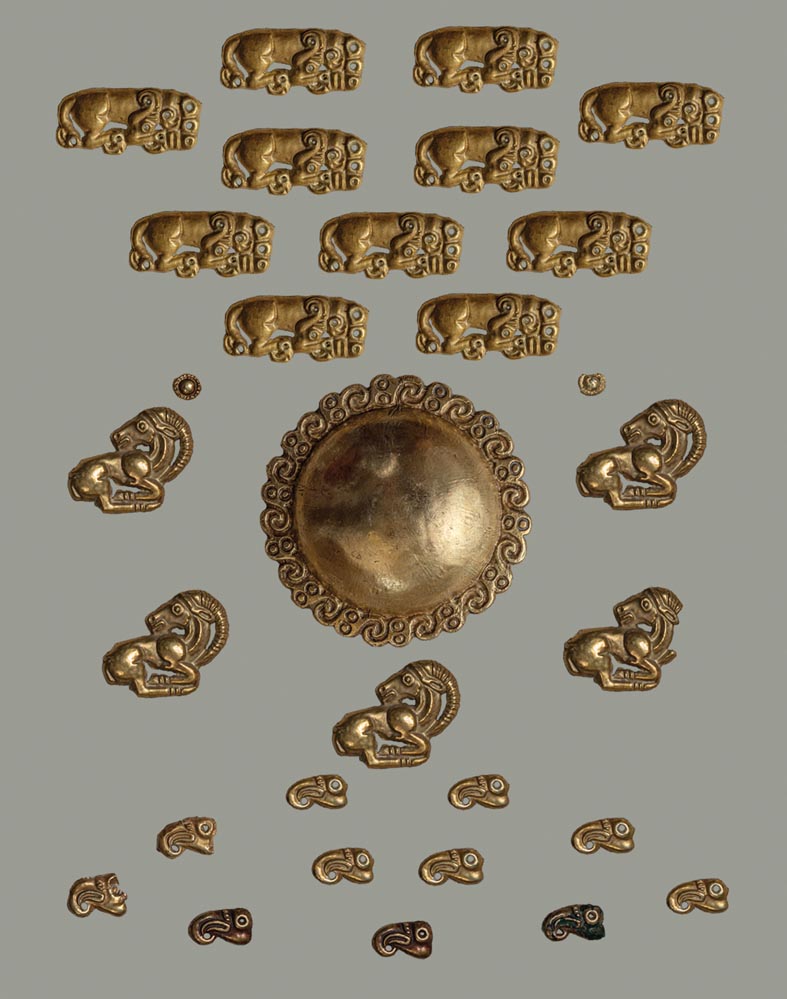
Знахідки з кургану Вітова могила, VI—V ст. до н .е. Зберігаються у Державному історичному музеї, Москва, Росія
Archaeological finds from the Vitova Mohyla burial mound, 6th—5th century BC. Stored in the State Historical Museum, Moscow, Russia
27.11.2022
Випуск 8. Радянська влада і грабунок культурної спадщини Кочубеїв у Диканьці
Селище Диканька (тепер Полтавський район Полтавської області) відоме чи не на весь світ завдяки твору Миколи Гоголя. Окрасою Диканьки був маєток знаного та заможного козацько-дворянського роду Кочубеїв. Від кінця XVII століття цей маєток був місцем акумулювання різноманітних історико-культурних цінностей меморіального та мистецького характеру. У XІХ столітті колекції збагатилися і археологічними знахідками, оскільки власники активно долучилися до збирання та дослідження пам’яток давніх епох. Як свідчив у спогадах директор Полтавського музею Валентин Ніколаєв, котрий бачив приголомшуючі артефакти, що залишилися після від’їзду власників за кордон 1918 року, «приміщення палацу було буквально набите в окремих кімнатах картинами, старовинною бронзою, килимами, гобеленами, цінним фаянсом, фарфором і склом, старовинною зброєю і т. д. Величезну цінність мала прекрасна бібліотека…».
Зауважимо, що освічені жителі Диканьки, яких у селищі було чимало, та службовці місцевої економії не дозволили грабунку кочубеївської власності в 1917—1918 роках. Колегія з управління маєтками, до складу якої увійшли і представники від селянства, ретельно охороняла залишене Кочубеями майно. «А ні прутика, а ні гвинтика селяне не зачепили» Все уціліло, окрім кількох пістолетів та шабель. Працювала навіть палацова електростанція.
Але більшовицькі зайди не могли залишити таких багатств Україні. Спочатку навесні 1918 року «Перша совітська бригада або 8 полк» перевіз до Полтави три скрині срібних виробів (близько 480 кілограм, 670 предметів), які згодом відправили до Москви, й цінні артефакти зникли безслідно. Очевидно, що реквізиція відбувалася насильницьким шляхом. Відповідно, коли за «других совітів» (квітень 1919 року) до палацу з метою опису предметів старовини та відбору експонатів для Полтавського музею приїхали його співробітники археолог Михайло Рудинський і природознавець-пам’яткознавець Валентин Ніколаєв, їх хоч і допустили до колекцій, але тривалий час не погоджувалися на вивіз відібраних старожитностей і навіть погрожували вчинити самосуд над приїжджими. Місцеві селяни та службовці економії стверджували, що будь-яке вилучення є незаконним, адже «князь їм говорив, що рано чи пізно все його майно повинно відійти селянам і вони мають турбуватися про його охорону». Лише коли полтавські музейники посприяли створенню музею Диканьки в кількох кімнатах першого поверху палацу, диканці дозволили і допомогли вивезти найцінніші картини, ікони, зразки посуду, бронзи, зброї, книг, родинний архів. Почасти ці предмети й донині залишаються в Україні, але чимала їх частина зрештою була вивезена до РФ.
Певний час після приїзду полтавців новостворений диканський музей та пивоварний завод, як згадував активних учасник тих подій Яків Орисенко, охороняли «добровольці і слабі старики Диканського загону Авраменка М.». Але через підпал палац з висококоштовними речами перетворився на руїни. Існує кілька версій щодо того, хто зробив цей злочин. Найпоширенішу версію озвучив у спогадах Валентин Ніколаєв. Суть її така — осіннього дня з лісу виїхав загін озброєних вершників і став табором навколо палацу. Потім ці вершники сіли на коней, а через годину палац запалав. Диканці називали цих людей партизанами, а Валентин Ніколаєв уточнив, що це була «шайка грабіжників, що називали себе народними партизанами, котрі не тільки розтягнули ряд предметів, а й спалили весь палац і службові приміщення. Багато книг було кинуто в став».
Зі спогадів безпосереднього учасника цих подій, мешканця Решетилівки Прохора Білоконя, відомо, що вандали входили до загону Якова Огія (уродженця Кобеляцького повіту, члена УПСР (боротьбисти)). Незадовго перед подіями в Диканьці цей загін отримав директиву від членів Зафронтового бюро, підпорядкованого Центральному комітету Комуністичної партії більшовиків України, діючи в тилах денікінців дискредитувати їх, зривати мобілізацію, руйнувати мости та зв’язок. Уранці 13 жовтня цей загін, озлоблений після поразки під Полтавою, як писав один із його бійців Прохор Білокінь, «погромивши пивний завод, електростанцію, мельницю… спалив і дворець двоповерховий в 105 комнат». Таким чином, все що більшовики не вивезли з Диканьки, було за їхніми настановами спалено безповоротно.
Останній акт вандалізму, зумовлений відповідною політикою московського уряду, стався вже щодо останків Кочубеїв, в тому числі одного з перших в російській імперії археологів-нумізматів Василя Вікторовича. У 1932—1933 роках диканськими «активістами» було розкрито саркофаги в склепі Миколаївської церкви і забрано звідти вироби з дорогоцінних металів.
Описи пограбування та плюндрування палацу Кочубеїв століття тому напрочуд нагадують поточні новини з тимчасово окупованих територій нашої держави. Викрадення та вивезення музейних колекцій, бездумне винищення всього, що вивезти не вдалося. За сто років нічого не змінилося в «методах» ставлення до українського культурного спадку з боку східних зайд.
Анатолій Щербань,
доктор культурології, завідувач кафедри історії, музеєзнавства та пам'яткознавства Харківської державної академії культури
Release 8. Soviet government and the looting of the Kochubeys Family’s cultural property in Dykanka
The village of Dykanka (nowadays the Poltava district of the Poltava region) is known almost all over the world thanks to the work of Mykola Gogol. The estate of the well-known and wealthy Cossack-noble Kochubeys family was the decoration of Dykanka. Since the end of the 17th century, this estate has been a place of accumulation of various historical and cultural values of memorial and artistic importance. In the 19th century, the owners actively participated in collecting artworks and researching the sites of ancient eras and enriched their collections with archaeological finds. Valentyn Nikolaiev, the director of the Poltava Museum, described in his memoirs stunning artifacts that remained in the estate after the departure of the owners abroad in 1918: “a number of rooms in the palace were literally stuffed with paintings, ancient bronzes, carpets, tapestries, valuable faience, porcelain and glass, ancient weapons, etc. A wonderful library was of great value...”.
It should be noted that educated inhabitants of Dykanka, of whom there were many in the village, and employees of the local economy did not allow the looting of Kochubeys property in 1917—1918. The estate management board, which included representatives from the peasantry, carefully guarded the property left by the Kochubeys. “The peasants didn't touch a stick or a cog”. Everything survived, except for a few pistols and sabres. Even the palace power station was running.
Nevertheless, the Bolshevik invaders could not leave such treasures in Ukraine. First, in the spring of 1918, the “First Soviet Brigade or 8th Regiment” transported three boxes of silverware (670 items weighing about 480 kilograms,) to Poltava. Later, the valuable artifacts were sent to Moscow and disappeared without a trace. It is obvious that the requisition was carried out by force. Accordingly, during the “second Soviet period” (April 1919) the employees of the Poltava Museum, the archaeologist Mykhailo Rudynskyi and the naturalist and heritage expert Valentyn Nikolaiev, came to the palace to describe antiquities and select exhibits for the Museum. Although they were admitted to the collections, for a long time they did not agree to the removal of the selected antiquities and even threatened to lynch newcomers. Local peasants and economy officials claimed that any seizure was illegal, because “the prince told them that sooner or later all his property should go to the peasants so they should care about its protection”. Only when the Poltava museum workers contributed to the creation of the Dykanka Museum in several rooms on the ground floor of the palace, the Dykanka’s inhabitants allowed and helped to take out the most valuable paintings, icons, samples of dishes, bronzes, weapons, books, and the family archive. Some of these items remain in Ukraine to this day, but a significant part of them was eventually exported to the Russian Federation.
As recounted by Yakiv Orysenko, an active participant in those events, some time after the arrival of the Poltava citizens, the newly created Dykanka museum and brewery were guarded by “volunteers and weak old men of the Dykanka detachment led by M. Avramenko”. Due to arson, the palace with valuable things turned into ruins. There are several versions of who committed this crime. The most widespread version was mentioned by Valentyn Nikolaiev in his memoirs. On an autumn day, a detachment of armed horsemen left the forest and camped around the palace. Then these riders got on their horses, and an hour later the palace caught fire. The villagers called these people partisans, and Valentyn Nikolaiev clarified that it was “a gang of robbers, who called themselves national partisans. They not only looted a number of items, but also burned the entire palace and service premises. Many books were thrown into the pond”.
From the memories of Prokhor Bilokin, a resident of Reshetylivka and the immediate participant in the events, it is known that the vandals were from the detachment of Yakiv Ohii (a native of Kobelyatsky district, a member of the Ukrainian Party of Socialist Revolutionaries). Shortly before the events in Dykanka, this detachment received a directive from the members of the Front Office, subordinate to the Central Committee of the Communist Party of the Bolsheviks of Ukraine, to act in the rear of the Denikinites in order to discredit them, disrupt mobilization, destroy bridges and communications. As one of the detachment’s soldiers Prokhor Bilokin wrote, on the morning of October 13, the detachment, angry after the defeat near Poltava, “having destroyed a brewery, a power station, and a mill... also burned down the two-story palace with 105 rooms”. Thus, everything that the Bolsheviks did not take out of Dykanka was irreversibly burned according to their instructions.
The latest act of vandalism arising from the policy of the Moscow government was carried out against the remains of the Kochubeys, in particular Vasyl Viktorovych, one of the first archeologist-numismatists in the Russian Empire. In 1932—1933, “activists” from Dykanka opened the sarcophagi in the crypt of St. Nicholas Church and took away items made of precious metals.
Descriptions of the robbery and looting of the Kochubeys’ palace a century ago are surprisingly reminiscent of current news from the temporarily occupied territories of our country. Stealing and removal of museum collections, and thoughtless wiping out of everything that could not be removed. For a hundred years, nothing has changed in the “methods” of treating Ukrainian cultural heritage on behalf of the Eastern invaders.
Anatoly Shcherban,
Doctor of Culturology, Head of the Department of History, Museum Studies and Monument Studies of the Kharkiv State Academy of Culture
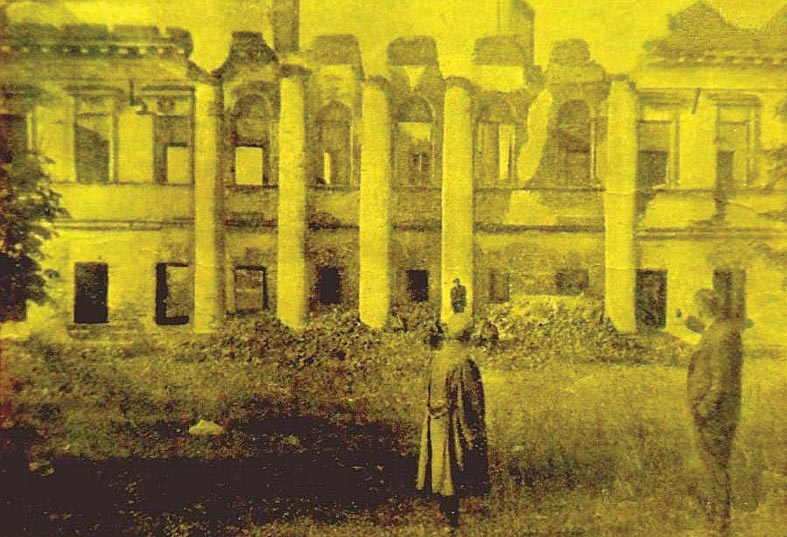
Диканька. Спалений палац Кочубеїв. Фото 1924 року
Dykanka. The burnt palace of the Kochubeys Family. Photo of 1924
Джерело | Source: https://www.wikiwand.com/uk
Вироби із золота та срібла XVII—XVIII cтоліть, що 1914 року зберігалися в диканському палаці Кочубеїв. Оригінали фото віднайдено та опубліковано Володимиром Захаровим. Фотограф Я. Штейнберг. 1914 р.
Gold and silver artworks of the 17th—18th centuries, kept in the Dykanka Palace of the Kochubeys Family in 1914. The original images were found and published by Volodymyr Zakharov. Photo credit Yakov Steinberg. 1914

Музейна кімната. Джерело Фото із журналу «Столица и усадьба» (№ 66, 1916 рік)
Museum room. Photo from the magazine “Capital and Manor” (No. 66, 1916)
30.11.2022
Випуск 9. Незавершена реституція
У взаємовідносинах між Україною та Росією відомо не надто багато прикладів результативної реституції. До цього часу наймасштабнішою за об’ємом залишається передача культурних цінностей з музеїв РСФРР до України, що відбулася 1932 року за результатами роботи та рішенням Паритетної комісії. Серед інших колекцій, в Україну з Державного Ермітажу передали деякі матеріали шести скіфських курганів, розкопаних у дореволюційний час, а саме — Литої Могили (Мельгуновський скарб; див. детальніше: http://vgosau.kiev.ua/novyny/proekty/1289-vypusk-3), Олександрополя, Шульгівки, Чмиревої Могили, Іллінецького та Першого Мордвинівського курганів. Але 31 січня 1932 р. українським представникам повністю повернули матеріали лише трьох курганів. Ще з трьох курганів — Олександрополя, Литої та Чмиревої могил — частина предметів, звісно ж найвидовищніших, була “тимчасово” залишена в Ермітажі для виготовлення гальванокопій.
Зокрема, з Литої Могили росіяни залишили знаменитий меч у піхвах із золотою обкладкою, золоту діадему, одну з 17 блях-пташок та пластину із зображенням мавпи та кількох птахів, срібні деталі притронного табурету, цвяхи та бронзові наконечники стріл, усього 17 предметів.
Із Чмиревої Могили для виготовлення гальванокопій відібрали за списком 25 предметів, з розкопок 1898 р. і 1909 р. Це бронзові, срібні та золоті предмети кінської оздоби, золоті пластинки — прикраси одягу, бронзове навершя (розкопки 1898 р.), намисто, прикраси, предмети побуту (розкопки 1909 р.). Крім цього, в Ермітажі за невідомих причин зосталися два предмети — кубок та черпачок, зі срібного «сервізу» Чмиревої Могили, що налічував 10 посудин, хоча до переліку предметів, що тимчасово залишаються для виготовлення гальванокопій, їх не внесли. Нарешті, в Ермітажі залишили і втулку одного із бронзових навершь, переданих до України.
Найрепрезентативнішою, серед затриманих для виготовлення гальванокопій, була колекція з Олександропільського кургану, що налічувала 80 предметів. Це навершя (9 екз.) та вирізні пластини (2 екз.), посуд та окремі його деталі (5 екз.), прикраси та деталі одягу — намисто та пронизки (15 екз.), нашивні пластинки-аплікації (21 екз.), підвіски та фрагменти прикрас (14 екз.), деталі кінської оздоби (15 екз.).
Зберігається в Ермітажі і частина предметів з Першого Мордвинівського кургану, колекцію якого росіяни повинні були передати повністю. Справа в тому, що під час передачі археологічних колекцій у 1926 р. з Державної академії історії матеріальної культури (ДАІМК, колишня імператорська археологічна комісія) до Ермітажу, частину предметів з Першого Мордвинівського кургану помилково атрибутували як знахідки з Кубані, й надали відповідні номери інвентарної групи «Ку». Це непорозуміння виправили вже після 1932 р. і розпізнані предмети перевели до групи «Дн» з порядковими номерами колекції Першого Мордвинівського кургану — Дн 1914 1/44—50. Цю колекцію склали дерев'яна посудина з двома ручками-упорами та фрагменти інших дерев'яних предметів — уламки циліндричної піксиди, виточеного стрижня (веретена?), коробочки та дощечок, а також кістяні пластинки з циркульним орнаментом і дві золоті трубочки-пронизки. Крім цього, встановлене походження з Першого Мордвинівського кургану срібного ритону, переданого в Ермітаж з ДАІМК разом з кубанськими колекціями в 1926 р.
Усі згадані предмети росіяни залишили в колекції Ермітажу і активно залучають до різних напрямків музейної роботи — експонують в постійній експозиції (зокрема — в залах Золотої та Діамантової комор), хизуються знахідками з території України на численних виїзних закордонних виставках, прикрашають привласненими історико-культурними цінностями різноманітні видання художніх альбомів та каталогів. Однак видається, що термін у 90 років є цілком достатнім для виготовлення якісних гальванокопій 122 предметів і ці знахідки, згідно з узгодженими правовими рішеннями, час уже повернути їх законному власнику — Музейному фонду України. Отже, директорові Ермітажу М. Б. Піотровському, очільникові протягом декількох останніх десятиліть, і, як нещодавно виявилося — палкому прихильнику спеціальних культурних операцій, — варто було б замислитися над проведенням однієї із таких операцій з повернення зазначених музейних предметів в Україну.
Леонід Бабенко,
старший науковий співробітник Харківського історичного музею імені М. Ф. Сумцова
Release 9. Incomplete restitution
There have been few examples of successful restitution in the relationship between Ukraine and Russia. Until now, the largest transfer of cultural values from the museums of the RSFSR to Ukraine took place in 1932 following the work and the decision of the Parity Commission. Among other collections, some materials from six Scythian burial mounds excavated in pre-revolutionary times were transmitted to Ukraine by the State Hermitage. Namely, there were artifacts from Lyta Mohyla (Melgunovsky treasure) (more details at the following link: http://vgosau.kiev.ua/novyny/proekty/1289-vypusk-3), Olexandropol, Shulgivka, Chmyreva Mohyla, Illinetsky and First Mordvynivsky burial mounds. However, on January 31, 1932, only the materials of the three kurgans were completely returned to the Ukrainian representatives. Part of the artifacts, of course, the most spectacular ones, from the other three burial mounds — Olexandropol, Lyta and Chmyreva Mohylas — were “temporarily” left in the Hermitage for making their galvanic copies.
In particular, the Russians retained the famous sword in a scabbard with a gold cover, a gold diadem, one of 17 plaques in the shape of birds and a plate with the image of a monkey and several birds, silver fragments of a throne stool, nails and bronze arrowheads — 17 items in total.
25 artifacts from the Chmyreva Mohyla, found during the excavations of 1898 and 1909, were selected according to the list, to create their galvanic copies. These were bronze, silver, and gold items of horse ornaments, gold plates — clothing ornaments, a bronze pole-top (excavations of 1898), a necklace, ornaments, and household items (excavations of 1909). In addition, for unknown reasons, two objects remained in the Hermitage — a cup and a ladle of the silver service found in the Chmyreva Mohyla, which consisted of ten pieces, although they were not included in the list of artifacts temporarily kept to make their galvanic copies. Finally, the socket of one of the bronze pole-tops, transmitted to Ukraine, was also left in the Hermitage.
The collection from the Olexandropol burial mound, which consisted of 80 objects, was the most representative among those kept for the production of galvanic copies. These were pole-tops (9 pieces) and cut-out plates (2 pieces), tableware and its separate parts (5 pieces), jewellery and details of clothing — necklaces and tubular beads (15 pieces), embroidered appliqué plates (21 pieces), pendants and fragments of jewellery (14 pieces), details of horse ornaments (15 pieces).
Part of the items from the First Mordvynivsky burial mound, the entire collection of which was supposed to be returned by the Russians, are also kept in the Hermitage. The fact is that during the transfer of archaeological collections in 1926 from the State Academy of the History of Material Culture (the former Imperial Archaeological Commission) to the Hermitage, part of the artifacts from the First Mordvynivsky burial mound were mistakenly attributed as the finds from the Kuban, and the corresponding numbers of the “Ku” inventory group were assigned to them. This misunderstanding was corrected already after 1932, and the identified objects were transferred to the “Dn” group with the respective serial numbers of the First Mordvynivsky Kurgan collection — Dn 1914 1/44—50. This collection consisted of a wooden vessel with two lug handles as well as fragments of other wooden objects — pieces of a cylindrical pyxide, a turned rod (spindle?), a little box and planches, as well as bone plates with a circular ornament and two gold tubular beads. In addition, it has been identified the provenance of the silver rhyton from the First Mordvynivsky Kurgan, transmitted to the Hermitage from the State Academy of the History of Material Culture together with the Kuban collections in 1926.
The Russians retained all the mentioned items in the Hermitage collection and used them in various areas of museum activities. The artifacts are displayed in permanent exhibitions (in particular, in the halls of the Golden and Diamond Chambers). The finds from the territory of Ukraine are shown off at numerous foreign exhibitions. The appropriated historical and cultural values adorn various publications in art albums and catalogues. However, it seems that the term of 90 years is sufficient for the production of high-quality galvanic copies of 122 artworks. It is time to return these finds to their rightful owner — the Museum Fund of Ukraine in compliance with approved legal decisions. So, the director of the Hermitage, Mikhail Piotrovsky, who has led the Museum for the past several decades and, as it turned out recently, is an ardent supporter of special cultural operations, should think about conducting one of such operations to return the mentioned museum items to Ukraine.
Leonid Babenko,
Senior Researcher in Mykola Sumtsov Kharkiv Historical Museum

Предмети з Литої Могили (Мельгуновський курган), залишені в Державному Ермітажі для виготовлення гальванокопій: діадема (Дн 1763 1/18), бляха-птах (Дн 1763 1/10), наконечник ніжки притронного табурета (Дн 1763 1/23), пластина із зображенням мавпи та кількох птахів (Дн 1763 1/21), меч у піхвах із золотою обкладкою (Дн 1763 1/23)
Artifacts from the Lyta Mohyla (Melgunovsky Burial Mound), retained in the State Hermitage for the production of galvanic copies: diadem (Dn 1763 1/18), plaque in the shape of bird (Dn 1763 1/10), tip of the leg of the throne stool (Dn 1763 1/23), plate with the images of monkey and several birds (Dn 1763 1/21), a sword in a scabbard with a gold cover (Dn 1763 1/23)

Предмети з Олександропольського кургану, залишені в Державному Ермітажі для виготовлення гальванокопій: навершя (Дн 1851 1/1, 2, 15, 17; 1853/3, 5, 6), оббивка дерев’яного посуду (Дн 1853 1/53), бляха у вигляді лева (Дн 1851—1856 1/32), ажурні пластини (Дн 1856 1/16, 17)
Artifacts from the Olexandropol Burial Mound, retained in the State Hermitage for the production of galvanic copies: pole-top (Dn 1851 1/1, 2, 15, 17; 1853/3, 5, 6), plaques of wooden dishes (Dn 1853 1/53), plaque in the shape of lion (Dn 1851—1856 1/32), openwork plates (Dn 1856 1/16, 17)

Предмети залишені в Державному Ермітажі для виготовлення гальванокопій та не передані через помилки обліку: Чмирева Могила: навершя (Дн 1898 1/328), втулка навершя (Дн 1898 1/331), пластинчасті аплікації (Дн 1898 1/290, 291, 293), кубок (Дн1909 1/9) та черпачок (Дн1909 1/10); Перший Мордвинівський курган: дерев’яна посудина (Дн 1914 1/44), уламки дерев’яної піксіди (Дн 1914 1/45) та дерев’яного веретена (Дн 1914 1/46), срібний ритон / ріг (КуП 1926 1/158)
Artifacts retained in the State Hermitage for the production of galvanic copies and not transferred due to registration mistakes: Chmyreva Mohyla: pommel (Dn 1898 1/328), socket of the pole-top (Dn 1898 1/331), plate applications (Dn 1898 1/290, 291, 293), cup (Dn 1909 1/9) and ladle (Dn 1909 1/10); the First Mordvynivsky Burial Mound: wooden vessel (Dn 1914 1/44), fragments of a wooden pyxide (Dn 1914 1/45) and a wooden spindle (Dn 1914 1/46), silver rhyton/horn (KuP 1926 1/ 158)
05.12.2022
Випуск 10. Івахниківський скарб, кінець VIІІ — початок ІХ ст.
Скарб знайдено під час оранки у 1905 році, поблизу с. Івахники Полтавської губернії (сучасне с. Яхники, Миргородський р-н, Полтавська обл., Україна). Він складався зі срібних та бронзових прикрас, а також великої кількості скляних намистин. До складу скарбу входить набір жіночих прикрас, що характерний для сіверянського племінного союзу. Це шість шийних гривень з круглих кручених срібних дротів, що мають замки на кінцях, дві срібні орнаментовані пластинчасті фібули-застібки ромбоподібної форми, два срібних персня салтівського типу, дві мідні трапецієподібні підвіски, чотири мідні бубонці, та майже 1000 скляних синіх, зелених, жовтих намистин різної форми.
Речі зі скарбу за невідомих обставин потрапили до Імператорської Археологічної комісії, а звідти вже в Історичний музей у Москві. Скарб є досить відомим серед археологів- медієвістів, а першу його публікацію здійснив знаний український археолог, мистецтвознавець і пам’яткоохоронець Микола Макаренко (1877—1938). Описуючи речі зі скарбу, Микола Макаренко зазначав, що частина речей була втрачена, однак встановити, що то були за знахідки в нього можливості не було. Зараз Івахниківський скарб, як і більшість знахідок вивезених з України, досі залишається у Державному історичному музеї в Москві.
Юрій Пуголовок,
кандидат історичних наук, заступник Голови правління ВГО “Спілка археологів України”
Release 10. Ivakhnyky treasure, late 8th — early 9th century
The treasure was discovered during ploughing in 1905, near the village Ivakhnyky in Poltava province (present-day Yakhnyky village, Myrhorod district, Poltava region, Ukraine). The treasure contained women's silver and bronze jewellery, as well as a large number of glass necklaces. A complete set of Siverioans women's jewellery was found in this treasure. The set includes six torks made of round twisted silver wires with clasps on the ends, two silver ornamented rhomboid-shaped plate fibula clasps, two silver rings of Saltiv type, two copper trapezoidal pendants, four copper jingle bells, and about 1000 blue, green, and yellow glass beads of various forms.
Things from the treasure under unknown circumstances got to the Imperial Archaeological Commission, and from there to the Historical Museum in Moscow. The treasure is well known among medieval archaeologists. Mykola Makarenko, the well-known Ukrainian archaeologist, art historian and heritage specialist (1877—1938), published this treasure. Describing the items from the treasure, Mykola Makarenko noted that some items were lost. However, he did not have the opportunity to establish what the finds were. Now the Ivakhnyky treasure, like most of the finds stolen from Ukraine, is still stored in the State Historical Museum in Moscow.
Yurii Puholovok,
PhD, deputy chairman of The All-Ukrainian Рublic Association of Archaeologists

Предмети з Івахниківського скарбу кінця VIІІ — початку ІХ ст. Зберігаються у Державному історичному музеї, Москва, Росія
Artifacts from the Ivakhnyky treasure, late 8th — early 9th century. Stored in the State Historical Museum, Moscow, Russia
07.12.2022
Випуск 11. Скарби кургану Солоха — крадіжка з «Причорномор’я»
Одним із найвідоміших царських скіфських курганів України є Солоха (розташований у Запорізькій області). Цей курган мав грандіозний насип заввишки 18 м та діаметром 110 м. Саме тут знайдено унікальні зразки греко-скіфської торевтики кінця V — початку IV ст. до н. е. (торевтика — мистецтво рельєфної обробки художніх виробів з металу).
Однак сьогодні ви не побачите ці речі в українських музеях, бо вони прикрашають колекції Державного Ермітажу.
Багатьом відомий золотий гребінь зі сценою бою двох піших воїнів із вершником. Проте мало хто знає, що знайшли його на українських землях, адже у більшості каталогів авторства російських дослідників, місцем його походження вказане «Північне Причорномор’я» або ж «Придніпров’я», без згадок про Україну.
Утім гребінь — не єдина вражаюча знахідка з кургану Солоха. Тут також знайдений унікальний меч у піхвах, окутих золотом, чудова срібна чаша із зображенням сцени фантастичного полювання, унікальне срібне окуття горита із зображенням епічної битви, золота фіала і багато інших неповторних речей.
Відкритий лист та фінансування на розкопки кургану Солоха у 1912—1913 рр. отримав професор Санкт-Петербурзького університету Ніколай Веселовський (1848—1918). Загалом він розкопав безліч скіфських пам’яток, не зважаючи на обґрунтовану критику методики досліджень «сліпими траншеями», висловлену сучасниками дослідника. Окрім Солохи на території України він досліджував курган Огуз (у 1891—1894 рр.), Чмиреву Могилу (у 1909—1910 рр.) тощо.
За правилами надавача відкритого листа (Імператорської археологічної комісії) усі найцікавіші знахідки мали бути представлені на розгляд комісії та особисто імператора, що й вирішували до якого музею їх спрямувати. Звісно, що все найцікавіше, у тому числі і знахідки з кургану Солоха, росіяни залишали у столиці імперії.
Курган Солоха містив два поховання. Центральну могилу кургану Солоха пограбували ще в давнину, однак і у ній збереглися деякі предмети поховального інвентарю.
Впускна (бічна) могила кургану, не порушена грабіжниками, містила поховання «царя» у супроводі трьох осіб та п'ятьох коней. Царське поховання супроводжував надзвичайно багатий набір інвентарю, вже згаданого вище, а також бронзовий шолом, глиняні грецькі амфори, ритон, бронзові литі котли тощо. Цікавими були і знахідки золотих платівок, розташування яких уздовж ніг свідчило, що вони були елементами, нашитими на штани небіжчика.
Дослідження кургану Солоха, на відміну від багатьох інших курганів, опубліковані. У книзі 1987 року «Курган Солоха. Публикация одной коллекции» російська науковиця Анастасія Манцевич намагалася розібратися у суперечливих свідченнях різних дослідників, зокрема Алєксєя Бобринського та Алєксандра Спіцина, які брали участь у розкопках. Однак згадок про те, що курган Солоха розташовувався на території України (Української РСР на час публікації книги), немає і в цій публікації, вказано лише «Північне Причорномор’я» та «землі села Велика Знам’янка (колишній Мелітопольський повіт Таврійської губернії)».
Недбалість розкопок Н. Веселовського засвідчував і знаний український археолог Микола Макаренко (розстріляний совітською владою 1938 р., детальніше про долю М. Макаренка тут: uinp.gov.ua), який оглядав незасипані розкопи, що лишились від кургану Солоха наступного після досліджень 1914 року: «Категорично запевняю, що ані коридор, ані могила (камера) не відповідають прикладеним до звіту малюнкам. Останні зроблені очевидно на око, причому око не вхопило ані форм, ані пропорцій».
Тож напевно, що Н. Веселовського цікавили передусім унікальні речі, якими можна було поповнити імперську скарбницю, а не ретельна фіксація процесу досліджень.
Оксана Ліфантій,
кандидатка історичних наук, провідна наукова співробітниця Скарбниці Національного музею історії України
Release 11. Treasures of the Solokha burial mound — theft from the Black Sea Region
One of the most famous royal Scythian burial mounds in Ukraine is Solokha kurgan (located in the Zaporizhzhia region). The eathen mound of Solokha kurgan is 18 m high and 110 m in diameter. It is here that unique examples of Greco-Scythian torevtics of the late 5th — early 4th century BC were found. (Torevtics is the art of relief processing of metal artworks).
Nevertheless, today you will not see these items in Ukrainian museums, because they adorn the collections of the State Hermitage.
A golden comb depicting a battle scene of two foot warriors with a horseman is well known. However, few people know that it was found in Ukrainian lands, because in most catalogues authored by Russian researchers, its place of origin is indicated as the «Northern Black Sea Region» or «Dnipro Region», without mentioning Ukraine.
The comb is not the sole astounding discovery from the Solokha burial mound. A unique gold-sheathed sword, a lovely silver bowl featuring a fantasy hunting scene, unique silver plaques of gorytus depicting an epic battle, a golden phiale and many other unique items were found there.
Nikolai Veselovskyi (1848—1918), a professor at St. Petersburg University, got an open letter and funding for the excavation of the Solokha kurgan in 1912—1913. In general, he excavated many Scythian monuments, regardless of the justified criticism by his contemporaries towards the «blind trenching» research methodology that he applied. In addition to the Solokha burial mound, he explored the Oguz burial mound (in 1891—1894), Chmyreva Mohyla (in 1909—1910), and other kurgans on the territory of Ukraine.
According to the open letter (issued by the Imperial Archaeological Commission), all the most interesting discoveries were to be submitted for consideration to the Commission and the emperor himself, who decided to which museum they should be sent. Of course, the Russians left all the most interesting things, including the finds from the Solokha burial mound, in the capital of the empire.
The Solokha kurgan contained two burials. The central grave of the Solokha burial mound was looted in ancient times but some items of funerary equipment survived in it.
The entrance (side) grave of the mound, which was not disturbed by robbers, contained the burial of the «king» accompanied by three persons and five horses. The royal burial had an extremely rich set of inventory. Besides the above-mentioned artifacts, there were found a bronze helmet, clay Greek amphorae, a rhyton, bronze cast cauldrons, etc. Other interesting finds were gold plates placed along the legs, which means that they were elements sewn onto the trousers of the deceased.
Studies of the Solokha burial mound, unlike many other burial mounds, have been published. In the book «Solokha Kurgan. Publication of a Collection» of 1987, the Russian scientist Anastasia Mantsevich tried to understand the conflicting evidence of various researchers, in particular, Aleksey Bobrynskyi and Aleksandr Spitsyn, who participated in the excavations. However, there is no reference to the fact that the Solokha burial mound was located in the territory of Ukraine (Ukrainian SSR at the time of the publication of this book). Only the «Northern Black Sea Region» and «Velyka Znamyanka village (former Melitopol district of the Tavria province) are mentioned».
The carelessness of Nikolai Veselovsky's excavations was also witnessed by the well-known Ukrainian archaeologist Mykola Makarenko (shot by the Soviet authorities in 1938, more details about the fate of Mykola Makarenko can be found at the following link: uinp.gov.ua). He inspected the unfilled trenches left from the Solokha burial mound after the research in 1914: «I state categorically that neither the corridor nor the grave (chamber) does not correspond to the drawings attached to the report. The latter was obviously made by eye, and the eye did not catch either the forms or the proportions».
Undoubtedly, Nikolay Veselovskyi was primarily interested in unique finds that could be used to replenish the imperial treasury, and not in the careful recording of the research process.
Oksana Lifantiy,
PhD, leading researcher of the Treasury of the National Museum of the History of Ukraine
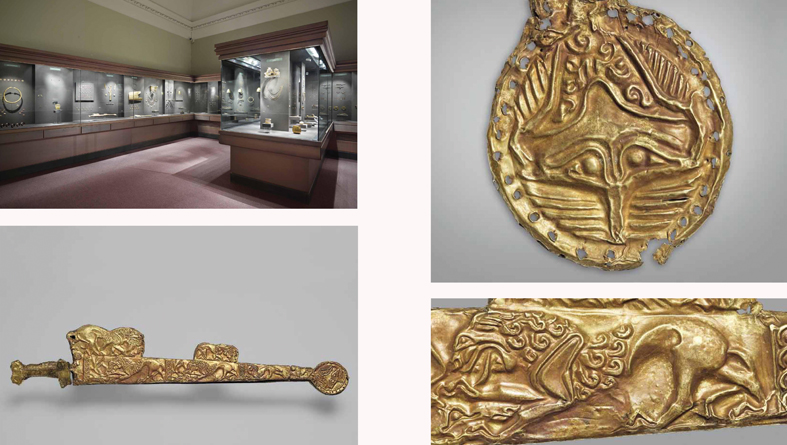
Меч у церемоніальних піхвах з кургану Солоха, що поблизу с. Велика Знам’янка Запорізької області, Україна. Початок IV ст. до н. е. Фото залу Державного Ермітажу, де експонується меч, разом із іншими відомими предметами з кургану
Sword in a ceremonial scabbard from the Solokha burial mound near Velyka Znamyanka village, Zaporizhzhia region, Ukraine. Early 4th century BC. Photo of the exhibition hall of the State Hermitage, where the sword is displayed, along with other famous artifacts from the burial mound
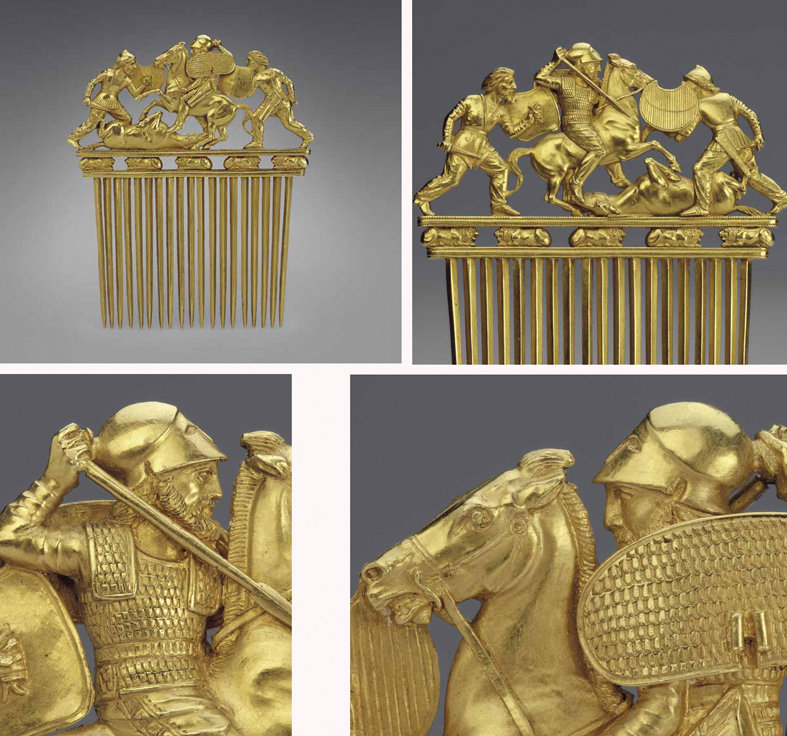
Золотий гребінь із зображенням сцени бою з кургану Солоха, що поблизу с. Велика Знам’янка Запорізької області, Україна. Кінець V — початок IV ст. до н. е. Зберігається в Державному Ермітажі, Росія
Golden comb depicting a battle scene from the Solokha burial mound near Velyka Znamyanka village, Zaporizhzhia region, Ukraine. Late 5th — early 4th century BC. Stored in the State Hermitage, Russia
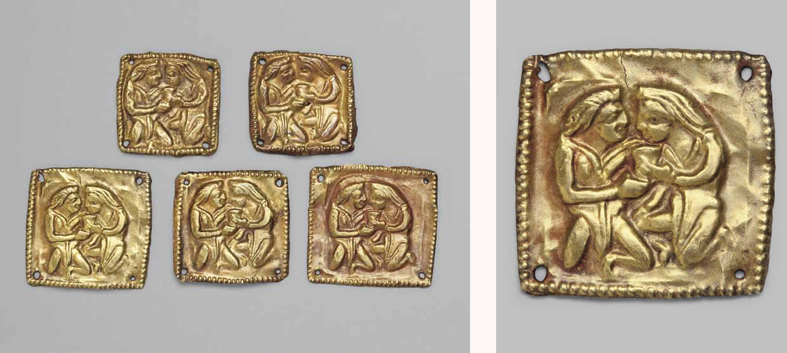
Золоті пластинки-аплікації вбрання із ймовірним зображенням скріплення кровної клятви. Знайдені у кургані Солоха, що поблизу с. Велика Знам’янка Запорізької області, Україна. Початок IV ст. до н. е. Зберігаються в Державному Ермітажі, Росія
Gold plate-appliqués of clothing with a probable image of the making a blood oath. Found in the Solokha burial mound near Velyka Znamyanka village, Zaporizhzhia region, Ukraine. Early 4th century BC. Stored in the State Hermitage, Russia
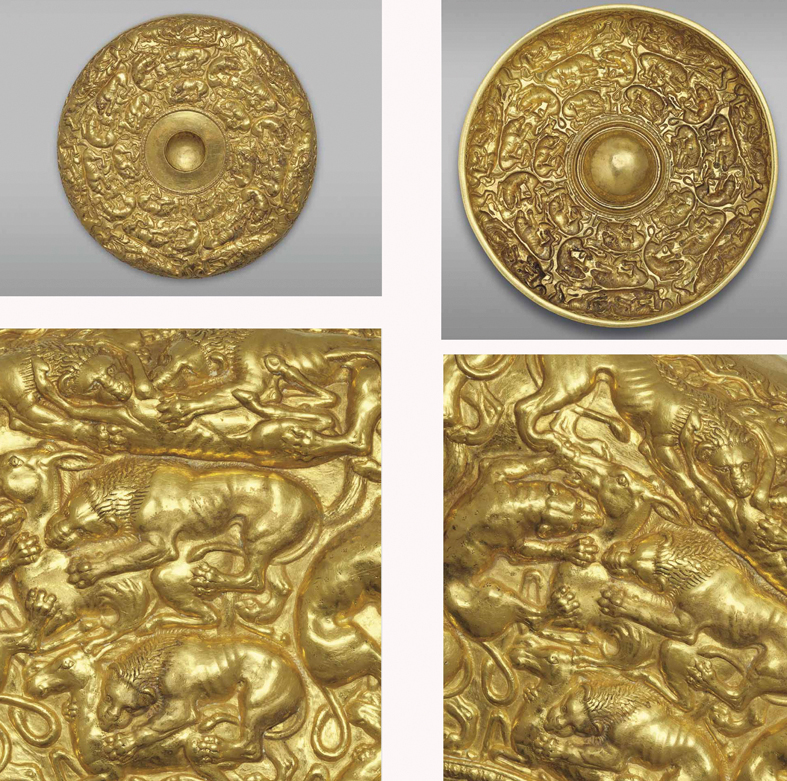
Золота фіала із рельєфними зображеннями нападу хижаків на копитних тварин. Знайдена в кургані Солоха, що поблизу с. Велика Знам’янка Запорізької області, Україна. Кінець V — початок IV ст. до н. е. Зберігається в Державному Ермітажі, Росія
Golden phiale with relief images of predators attacking ungulates. Found in the Solokha burial mound, near Velyka Znamyanka village, Zaporizhzhia region, Ukraine. Late 5th — early 4th century BC. Stored in the State Hermitage, Russia

Срібна з позолотою чаша із зображенням міфічного полювання з кургану Солоха, що поблизу с. Велика Знам’янка Запорізької області, Україна. Початок IV ст. до н. е. Зберігається в Державному Ермітажі, Росія
Silver and gilded bowl with the image of a mythical hunt from the Solokha burial mound near Velyka Znamyanka village, Zaporizhzhia region, Ukraine. Early 4th century BC. Stored in the State Hermitage, Russia
10.12.2022
Випуск 12. Михалківські скарби, VIII—VII ст. до н. е.
Зберігаються в Росії, найімовірніше, у Москві.
У 1878 та 1897 роках біля с. Михалків Борщівського повіту на Тернопільщині виявили два золоті скарби загальною вагою понад 7 кг. Михалківські скарби стали перлиною археологічної колекції Музею Дідушицьких у Львові. До їхньої купівлі спричинився багаторічний кустош музею Владислав Зонтак, при сприянні голови повітової ради Борщова Мечислав Дунін-Борковського, перший скарб «менш-більш в цілості потрапив до музею Дідушицьких у Львові».
Історію відкриття першого Михалківського скарбу описав львівський дослідник старожитностей Антін Петрушевич (1821—1913), зокрема, відзначив, що внаслідок липневих дощів стався сильний зсув ґрунту і місцевий пастух першим побачив «жовту мідь». Насправді, літнього дня 1878 року дві дівчинки пасли корову і декілька овець на пасовищі «Передолина», що знаходилось на правому березі ріки Нічлава навпроти села. Після сильної зливи дівчатка побачили прикраси. Самі не наважились їх чіпати і покликали свою матір. Здивована жінка-вдова прийшла з доньками до того місця і натрапила у розмитій глині на справжній скарб золотих речей. Розгрібаючи мокру від дощу глину, знаходила все нові і нові речі, все це складала до подолу, зібравши шість речей, пішла до лихваря. Потім мати пастушок звернулася до графа Мечислава Борковського із сусіднього містечка Мельниця. Тоді ж і з’ясували, що це не мідь, а золото. Дізнавшись про це, мешканці села пішли на місце зсуву шукати золоті речі. Владі вдалося відібрати основну кількість речей скарбу, але невідомо, яка частина з них безслідно зникла.
У Львові знаходились: дві орнаментовані діадеми-корони, рельєфна чаша, шийна гривна, фібули, серед яких кілька зооморфних, браслети, фалари, нашивні прикраси, намистини. Вага «львівської» частини скарбу становила понад 3 кг. Друга велика частина скарбу від 1895 р. зберігалася у Природничому Музеї у Відні, а поодинокі предмети — в музеях Будапешта, Кракова, Берліна.
На початку 1891 р. під час відвідин Львова з михалківськими знахідками ознайомився знаний український археолог Володимир Антонович, згодом вчений писав про це у листах та щоденнику, опублікованому Катериною Мельник. В одному з листів він згадував цікаву деталь: власник музею заборонив служникові демонструвати загадковий скарб. Однак хранителя, німця Владислава Зонтака, «вдалося задовольнити... він украдкою від господаря показав мені скарб... Якби Ви знали, яка це пишність — у всіх бачених мною музеях нічого подібного я не бачив. Ну, описувати скарб не буду, бо, показуючи, Зонтаг узяв із мене слово честі, що описувати не буду, — розповідати не заборонив, значить при зустрічі розповім».
Через двадцять років, у травні 1897 р. на тому ж місці було знайдено ще один сховок золота. За 27 метрів від першого скарбу лопата копачів наткнулася на щось тверде у землі — це був тріснутий горщик, повний золотих речей. Було встановлено, що і одна, і друга знахідки — то частини цілісного скарбу, який лежав у землі століттями.
Знахідки зі скарбу датовано VIII—VII ст. до н. е. Деякі дослідники навіть схилялися до думки, що Михалківський скарб — не що інше, як «священне золото» агафірсів, про яких писав Геродот. Керамічний посуд, у якому зберігався другий Михалківський скарб, дав підстави стверджувати, що це золото належало до культури фракійського гальштату.
Найбільша публікація, присвячена скарбу, вийшла з під пера відомого археолога, працівника музею Дідушицьких Кароля Гадачека у 1904 р. Він не лише зібрав відомі раніше дані про пам’ятку, а й сам 1900 р. за фінансової підтримки Тадеуша Дідушицького, відвідав місцевість з метою археологічного обстеження.
Львівську частину скарбів у 1900 р. задля безпеки було вкладено в Іпотечний банк у Львові. Михалківський скарб не має рівних собі за цінністю серед подібних скарбів у всьому Карпато-Дунайському басейні. Знайдені предмети, як стверджують науковці й історики, належали вождям племені або ж жрецям і використовувались для ритуальних церемоній.
Однак у Львові не вдалося вберегти цю безцінну колекцію. У 1940 р., після окупації совєтами Львова, «львівську» частини скарбу вивезли зі Львова до Москви. Цю інформацію подає Ярослав Пастернак на сторінках «Археології України» (1961). Підтвердження цьому є й у приватному листуванні, що зберігається у відділі археології Інституту українознавства ім. І. Крип’якевича НАН України. Директор Ермітажу Борис Піотровський у листі до Ігоря Свєшнікова (від 2 вересня 1964 р.) фактично підтверджує, що скарб знаходиться у росії. Борис Піотровський хвалився Ігорю Свєшнікову, що мав змогу тримати в руках михалківські знахідки у Держфондах СРСР. Сучасний польський дослідник Габрієль Бжек висловив думку, що зараз скарб зберігається у Петербурзі.
Наталя Булик, кандидатка історичних наук, завідувачка відділу археології Інституту українознавства ім. І. Крип’якевича НАН України
Release 12. Mykhalkiv treasures, 8th—7th century BC
Stored in Russia, most likely in Moscow.
In 1878 and 1897, near the Mykhalkiv village of Borshchiv district in the Ternopil region, two gold treasures were discovered with a total weight of more than 7 kg. The Mykhalkiv treasures became the gem of the archaeological collection of the Didushytsky Museum in Lviv. The long-standing curator of the museum, Vladyslav Zontak, contributed to their purchase, with the assistance of the head of the Borschiv County Council, Mechyslaw Dunin-Borkovsky. The first treasure more or less intact found its way into the Didushytsky museum.
Antin Petrushevich, the researcher of antiquities from Lviv (1821—1913), described the story of the discovery of the first Mykhalkiv treasure. In particular, he noted that the local shepherd was the first to see «yellow copper» owing to the strong landslide caused by July rains. In reality, on a summer day in 1878, two girls were herding a cow and several sheep on the Peredolyna pasture, located on the right bank of the Nichlava River opposite the village. After heavy rainfall, the girls saw the jewellery. They did not dare to touch treasure and called their mother. A surprised widow woman went with her daughters to that place and came across gold things in the washed-out clay. Raking the rain-soaked clay, she found more and more new things and put them into the hem. Having collected six things, she went to the moneylender. Then the mother of the shepherds turned to Count Mechyslaw Borkowski from the nearby town of Melnytsia. They found out that it was not copper but gold. On hearing this, the villagers went to the landslide place to look for gold things. The authorities managed to seize the bulk of the treasure's items but it is not known how many of them disappeared without a trace.
Two ornamented diadems-crowns, a relief bowl, a neck hryvnia, fibulae, including several zoomorphic ones, bracelets, phaleras (brasses), embroidered ornaments, and beads were kept in Lviv. The weight of the «Lviv» part of the treasure was more than 3 kg. The second large part of the treasure has been kept in the Natural History Museum in Vienna since 1895, and its separate objects — in the museums of Budapest, Krakow, and Berlin.
At the beginning of 1891, during his visit to Lviv, the well-known Ukrainian archaeologist Volodymyr Antonovych got acquainted with Mykhalkiv finds. Later the scientist wrote about it in letters and a diary published by Kateryna Melnyk. In one of the letters, he mentioned an interesting detail: the owner of the museum forbade the employee to show the mysterious treasure. However, he managed «to satisfy…» the keeper of the collection, German Vladyslav Zontak, and «...he secretly from the owner showed me the treasure... If you only knew how magnificent it was — I have never seen anything similar in other museums. Well, I won't describe the treasure, because, while showing it, Zontak took my word of honour that I won't describe it — but he didn't forbid me to speak, so I will tell you about it when we meet».
Twenty years later, in May 1897, another cache of gold was found at the same place. At a distance of 27 meters from the first treasure, the diggers' shovel came across something solid in the ground — a cracked pot full of gold objects. It was defined that both the first and second finds were parts of a whole treasure that has been lying in the ground for centuries.
The discoveries date to the 8th—7th century BC. Some researchers were of the opinion that the Mykhalkiv treasure was nothing less than the sacred gold of the Agaphirs, mentioned by Herodotus. The ceramic vessel containing the second Mykhalkiv treasure gave reasons to state that this gold belonged to the culture of the Thracian Hallstatt.
The well-known archaeologist Karol Hadacek, an employee of the Didushytsky museum, wrote the largest publication dedicated to the treasure in 1904. He not only collected the already known data about the monument but also conducted the archaeological survey of the area in 1900 with the financial support of Tadeusz Didushytsky.
In 1900, the Lviv part of the treasures was deposited in the Mortgage Bank in Lviv for safety. The Mykhalkiv treasure has no equal value among similar treasures in the entire Carpathian and Danube basin.
According to scientists and historians, the discovered artifacts belonged to the tribal leader or priests and were used for ritual ceremonies.
However, they failed to preserve this priceless collection in Lviv. In 1940, after the occupation of Lviv by the Soviets, the «Lviv» part of the treasure was transferred to Moscow. Yaroslav Pasternak mentioned it on the pages of the Archeology of Ukraine edition (1961). This information was confirmed in private correspondence kept in the archaeology department of the Ivan Krypyakevych Institute of Ukrainian Studies of the National Academy of Sciences of Ukraine. Borys Piotrovsky, the director of the Hermitage, in his letter to Igor Sveshnikov (dated September 2, 1964) actually confirms that the treasure was in Russia. Borys Piotrovsky boasted to Igor Sveshnikov that he had the opportunity to hold in hands Mykhalkiv finds in the State Funds of the USSR. Contemporary Polish researcher Gabriel Bzek expressed the opinion that the treasure is now stored in St. Petersburg.
Natalia Bulyk,
PhD, Head of the Archeology Department of Ivan Krypyakevych Institute of Ukrainian Studies of the National Academy of Sciences of Ukraine
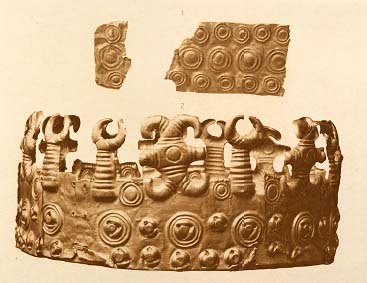
Золота діадема з першого Михалківського скарбу
Golden diadem from the first Mykhalkiv treasure

Чотирилисткова розетка з декором. Перший Михалківський скарб
Four-leaf rosette with decoration. The first Mykhalkiv treasure
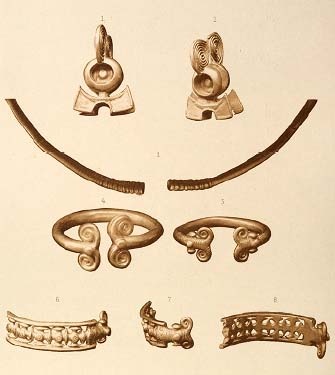
Фрагменти нашийної гривни та наручні браслети. Перший Михалківський скарб
Elements of neck hryvnia and wrist bracelets. The first Mykhalkiv treasure
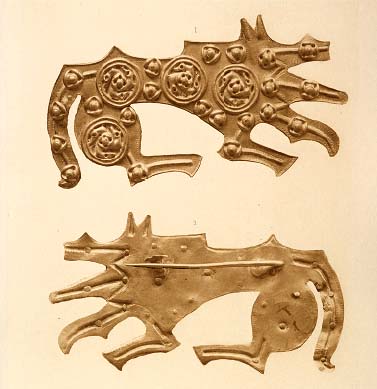
Зооморфна фібула. Перший Михалківський скарб
Zoomorphic fibula. The first Mykhalkiv treasure
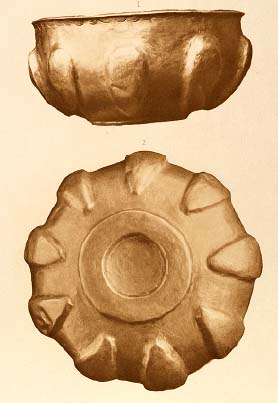
Золота посудинка з першого Михалківського скарбу
Gold small vessel from the first Mykhalkiv treasure
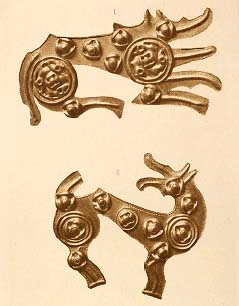
Зооморфні фібули. Перший Михалківський скарб
Zoomorphic fibulae. The first Mykhalkiv treasure
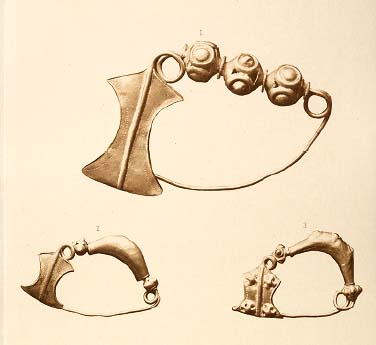
Фібули. Перший Михалківський скарб
Fibulae. The first Mykhalkiv treasure
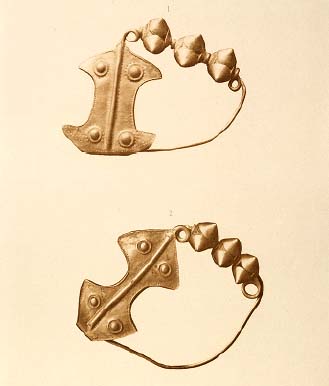
Фібули. Перший Михалківський скарб
Fibulae. The first Mykhalkiv treasure
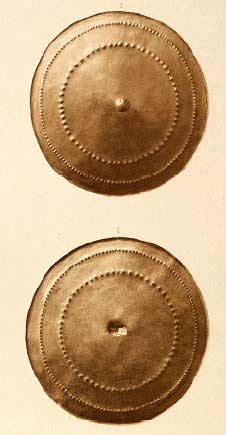
Золотий фалар з орнаментом. Перший Михалківський скарб
Golden phalera with ornament. The first Mykhalkiv treasure
Ілюстрації за | The illustrations credit is: Гадачек | Hadachek, 1904
12.12.2022
Випуск 13. Вкрадені прикраси — золоті сережки VI ст. до н. е. з Ольвійського некрополя
Систематичні розкопки на території Ольвії (Миколаївська область, Україна) та її некрополя проводились від 1901 року під керівництвом археолога Бориса Фармаковського, який за цей час лише на некрополі міста відкрив близько тисячі різночасових поховань.
Від початку двадцятого століття і до жовтневого перевороту найцінніші ольвійські знахідки, зазвичай, забирали до найбільших музеїв Російської імперії — у Москві та Санкт-Петербурзі. Деякі знахідки масового характеру все ж потрапляли до музеїв в Одесі (заснований 1825 р.) та Миколаєві (1913 р.), співробітники яких зберігали та досліджували артефакти, виявлені під час розкопок на території Північного Причорномор’я. Вивезення найатрактивніших знахідок формально регламентувалося «Відкритим листом», що надавав право метрополії обирати найкращі (а фактично найкоштовніші) предмети для своїх музеїв (детальніше — читайте у випуску 2). У випадку з Ольвією, від 1909 року весь матеріал без винятку поступав до Ермітажу. Серед безлічі античних предметів з території Ольвії, Пантікапею, Херсонесу та інших античних полісів Північного Причорномор'я, росіяни вивезли й золоті сережки VI ст. до н. е. з Ольвійського некрополя.
Прикраси було виявлено в одній з могил (№ 100) Ольвійського некрополя архаїчного часу під час археологічних розкопок 1913 року під керівництвом Бориса Фармаковського. Вірогідно, що поховання належало одній із заможних мешканок поліса. Могила містила залишки дерев'яного саркофага з кістяними обкладками та окраскою.
По обидві сторони від голови знайшли вушні прикраси, по одній з кожної сторони. Разом з сережками виявили багатий поховальний інвентар — золотий перстень, золоте намисто, кілька золотих бляшок, бронзове дзеркало, алебастровий алабастр та керамічний посуд. Комплекс датували третьою чвертю VI ст. до н. е.
Вивезені золоті сережки мають доволі просту форму та порівняно нескладну обробку. Однак якість виконання рельєфу в техніці зерні дозволяє віднести їх до кращих ранніх творів ювелірного мистецтва. Ці парні прикраси одягали поверх вуха так, щоб велика частина знаходилась попід вухом. Тож сережки складаються з двох основних частин — золотого дроту з фігурним навершям (що проходив за вухом та кріпився зверху), та рельєфного золотого щитка округлої форми. Щиток має посередині фігурне зображення голови лева у фас з відкритою пащею. Голова лева виготовлена настільки майстерно, що ми маємо змогу роздивитися очі, ніс, вуса, гриву та висунутий язик тварини. Маленькі деталі виготовлені у техніці паяння зерні.
Сережки (під польовим номером 0.1913.444), разом зі всім археологічним комплексом потрапили до колекції Державного Ермітажу у Санкт-Петербурзі (Росія). Російський музей наразі не експонує ці знахідки, тож вірогідно вони перебувають у фондах музею. Зауважимо, що до Ермітажу вивезли як мінімум п’ять подібних парних прикрас одного типу, знайдених на Ольвійському некрополі архаїчного часу. Слід зазначити, що зараз неможливо відстежити конкретне місцезнаходження певних предметів (в тому числі й сережок), адже «відкрита наукова база» музею має лише невелику кількість предметів у вільному доступі. У цій базі немає навіть позначки про походження предметів з Ольвії, що наводить на думку, що ця інформація приховується навмисно. Проте, дякуючи багатьом попереднім науковим публікаціям (переважно радянських часів) ми маємо докази того, що велика кількість матеріалів з Ольвії, у тому числі золоті сережки, про які йдеться у дописі, зберігаються саме там.
Ірина Чечуліна,
доктор філософії, науковий співробітник відділу античної археології, ІА НАН України
Release 13. Stolen jewellery — gold earrings of the 6th century BC from the Necropolis of Olbia
Systematic excavations on the territory of Olbia (Mykolaiv region, Ukraine) and its necropolis has been conducted since 1901 under the guidance of archaeologist Borys Farmakovsky, who during this time discovered about a thousand burials of different periods just in the necropolis of the city.
From the beginning of the 20th century until the October Revolution the most valuable Olbian discoveries were usually taken to the largest museums of the Russian Empire located in Moscow and St. Petersburg. Some of the most common finds of a mass nature still ended up in museums of Odessa (founded in 1825) and Mykolaiv (founded in 1913), whose employees preserved and researched artifacts discovered during excavations on the territory of the North Black Sea region. Removal of the most attractive finds was formally regulated by the «Open Letter», which gave the right to the metropolis to choose the best (and in fact the most valuable) items for its museums (for more details see release 2).
In the case of Olbia, since 1909, all the material without exception has entered the Hermitage. Among the many antique items from the territory of Olbia, Panticapae, Chersonesus and other ancient cities of the North Black Sea region, the Russians also exported gold earrings of the 6th century BC discovered in the Necropolis of Olbia.
Jewellery was found in one of the graves (No. 100) of the archaic necropolis of Olbia during archaeological excavations in 1913 led by Borys Farmakovsky. It is likely that the burial belonged to one of the wealthy residents of the polis. The grave contained the remains of a wood sarcophagus with bone plates and paintings.
Ear ornaments were found on both sides of the head. Apart from the earrings, rich burial equipment was discovered that consisted of:
— a gold ring, gold necklace, several gold plaques, bronze mirror, alabaster alabastron and ceramic dishes. The complex was dated the third quarter of the 6th century BC.
The exported gold earrings have a rather simple shape and relatively simple processing. However, the quality of the relief made in the granulation technique allows us to classify them among the best early works of jewellery art. These pairs of jewellery were worn over the ear so that a large part overlapped under the ear. So earrings consisted of two main parts — a gold wire with a shaped top (which passed behind the ear and was attached from above), and an embossed golden round shield. In the middle of the shield, there is a figure image of a lion's head front view with an open mouth. Lion's head is performed so skillfully that we can see the eyes, nose, whiskers, mane and protruding tongue of the animal. Small parts are made in granulation soldering techniques.
Earrings (under field number 0.1913.444), together with the whole archaeological complex entered the collection of the State Hermitage in St. Petersburg (Russia). The Russian Museum currently does not exhibit these finds, so they are probably kept in the museum fund collections. It should be noted that at least five similar paired ornaments of the same type, found at the archaic Necropolis of Olbia were taken to the Hermitage. Currently, it is impossible to trace the exact location of certain items (including earrings), because the «open access scientific database» of the museum provides free access only to a limited number of items. This database does not even contain information about the Olbian origin of the artifacts. Obviously, such information is being withheld on purpose. However, thanks to many previous scientific publications (mainly in Soviet time) we have evidence that a large number of materials from Olbia, including the gold earrings mentioned in this release, are kept right there.
Iryna Chechulina,
Dr., Department of ancient archaeology, Institute of Archaeology of National Academy of Science of Ukraine

Золоті сережки VI ст. до н. е. з Ольвійського некрополя
Golden earrings of the 6th century BC from Necropolis of Olbia
Джерело | Source: spbtourkit.ru
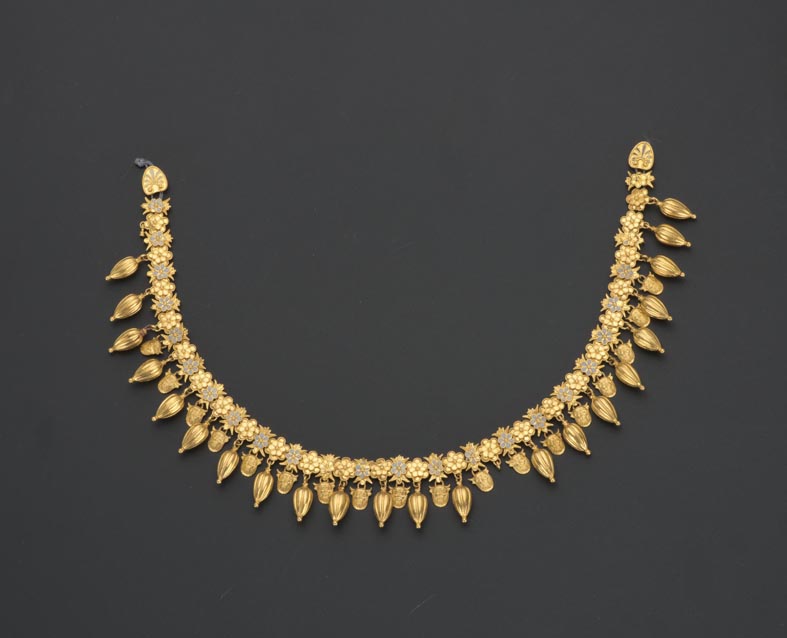
Намисто із сорока восьми пронизок з Пантікапею (кінець V — початок IV ст. до н. е.)
Necklace of forty-eight tubular beads from Panticapae (late 5th — early 4th century BC)
Джерело | Source: open catalogue of the State Hermitage Museum

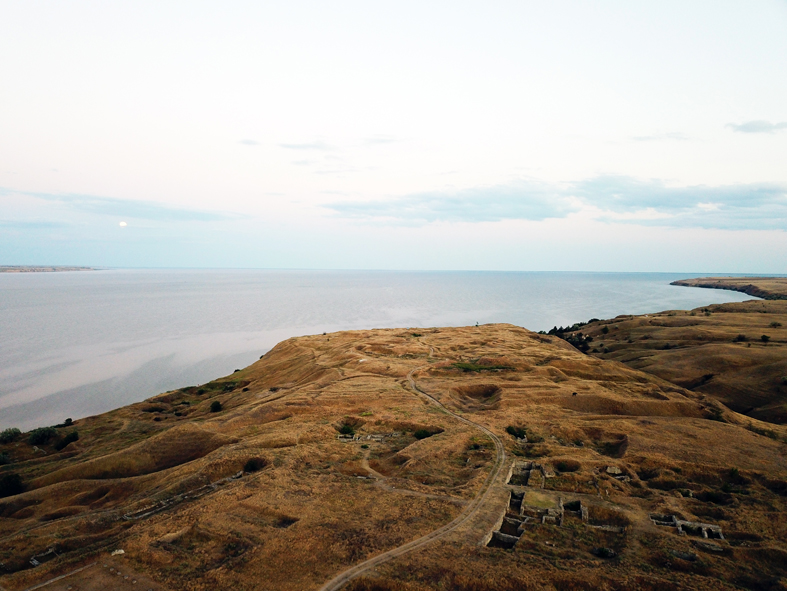
Вигляд на Ольвійський поліс
View of the Olbia polis
Фото | Photo: Юрія Пуголовка | Yuri Pugolovok
15.12.2022
Випуск 14. Викрадена історія “чорних клобуків”
Поросся — це лісостепова частина Київщини. Діброви та байрачні ліси тут поєднуються із степовими ділянками. Найбільші з таких “внутрішніх” степків — Перепетівське поле (Білоцерківський степок) та Кагарлицький степок. За князівських часів сюди з Великого степу потрапляють різні племена кочівників, яких київські літописці називали “чорні клобуки” або ж “свої погані”. Останнє підкреслювало, що в більшості ці кочівники залишалися язичниками. Окремі роди кочівників жили поряд з осілим населенням — “поршанами”. Обов’язком “чорних клобуків” Поросся, як і їхніх родичів з лівобережжя було насамперед боронити південні підступи до княжого Києва від частих набігів степовиків-половців. Про перебування “чорних клобуків” на Південній Київщині, у ХІ—ХІІІ ст. свідчать не лише письмові звістки літописів князівського часу, а й численні кургани, розкидані між річками Рось та Стугна.
На жаль, в українських музеях археологічних знахідок, що засвідчують існування «чорних клобуків» Поросся, майже немає. Левову їх частину вивезли до імперських музеїв Росії наприкінці ХІХ ст.
Від 1888 року Ніколай Єфімовіч Бранденбург, імперський військовий та історик, розпочав розкопки курганів та збір старожитностей на території тодішніх південних губерній Росії. Ця діяльність була пов’язана з комплектуванням фондів “Артилерийского исторического Музея” (м. Санкт-Петербург).
Для цього якнайкраще надавалися курганні поховання представників “героїчної доби” (доби бронзи та раннього залізного віку), оскільки практично всі вони містили зброю як поховальний інвентар. Ці матеріальні свідчення військової історії і цікавили дослідника у першу чергу. Тож не дивно, що яскраві поховальні старожитності “чорних клобуків” постраждали від такого цілеспрямованого пошуку чи не найбільше. Ніколай Бранденбург активно взявся за розкопування курганів на території Київщини. Так в степовій частині Поросся — Кагарлицькому степку, — на потреби “Артилерийского исторического Музея” він “спустошив” близько 300 курганів.
Предмети з цих поховань склали колекцію з кількох сотень артефактів. 1932 року “колекцію Бранденбурга” (до якої входили як зазначені предмети, так і предмети з поховань доби бронзи та раннього залізного віку з території теперішньої Черкащини) передали з Артилерійського історичного Музею до Державного Ермітажу, де вона зберігається дотепер. Від 2017 року частиною колекції (зокрема, залізною маскою та кольчугою з с. Липовець) росіяни хизуються у постійній експозиції “Європа в епоху Великого переселення народів та ранньому середньовіччі”, розміщеній у Кутузовському коридорі Зимового палацу Ермітажа. Місцем знахідок предметів з території України російські музейники й досі вказують як “Россия”, “Приднепровье”, “Малоросия”.
Тож чималу частину матеріальних слідів цілої історичної народності, яка мешкала на території сучасної України, Російська імперія вилучила з національної скарбниці держави, з історії ж України росіяни вирвали важливі сторінки про дієве співіснування кочівницької та осілої цивілізацій та стійкості до зовнішніх загроз.
Артем Борисов,
кандидат історичних наук, науковий співробітник ІА НАН України, голова Київського обласного відокремленого регіонального підрозділу
Release 14. Black Hoods’ Stolen History
Porossiya is a forest-steppe part of the Kyiv region. Oakwoods and ravine forests are combined with steppes. Perepetivske Pole (Bilotserkivsky Steppe) and Kagarlytsky Steppe are the largest in this area. During the princely times, various tribes of nomads came here from the Great Steppe. Kyiv chroniclers called them Black Hoods or Our Pagans, emphasizing that most of these nomads remained pagans. Separate nomadic families lived next to the settled population called Porshany. The primary duty of the Black Hoods of Porossiya, as well as their relatives from the Dnipro River Left Bank, was to defend the southern approaches to princely Kyiv against frequent raids of the Polovtsy. Not only the written records of the princely time chronicles but also the numerous burial mounds scattered between the Ros and Stugna Rivers indicate the presence of the Black Hoods in the Southern Kyiv region in the 11th—13th century.
Unfortunately, in Ukrainian museums, there are few archaeological finds that testify to the existence of the Black Hoods of the Porossiya. The lion's share of them was taken to the imperial museums of Russia at the end of the 19th century.
In 1888, Nikolai Brandenburg, an imperial military and historian, initiated the excavations of burial mounds and collection of antiquities in the territory of the then southern provinces of Russia. This activity aimed to supplement the fund collection of the Artillery Historical Museum in St. Petersburg.
Burial mounds of representatives of the Heroic Age (Bronze Age and Early Iron Age) suited the best for this aim since almost all of them contained weapons as burial equipment. This material evidence of military history interested the researcher in the first place. Therefore, it is not surprising that the bright funerary antiquities of the Black Hoods mostly suffered from such a purposeful search.
Nikolai Brandenburg actively began to excavate burial mounds in the territory of the Kyiv region. For example, in the steppe part of Porossiya — the Kagarlytsky Steppe — he "ravaged" about 300 kurgans for the needs of the Artillery Historical Museum. Items from these burials made up a collection of several hundred artifacts.
In 1932, the Brandenburg’s Collection (which included both the mentioned items and artifacts from Bronze Age and Early Iron Age burials in the territory of present-day Cherkasy region) was transferred from the Artillery Historical Museum to the State Hermitage, where it is stored to this day. Since 2017, Russians have been flaunting displaying part of the collection (in particular, an iron mask and chain mail from Lypovets village) in the permanent exhibition “Europe in the Great Migration and the Early Middle Ages”, located in the Kutuzov Corridor of the Winter Palace of the Hermitage. Russian museologists still indicate Russia, Dnipro region or Malorossia as the places of discovery of the items from the territory of Ukraine.
Therefore, the Russian Empire removed from the national treasury a significant part of the material traces of an entire historical nation that lived on the territory of modern Ukraine. The Russians also took essential pages out of the history of Ukraine on the effective coexistence of nomadic and settled civilizations and resilience to external threats.
Artem Borisov,
PhD, researcher of the Institute of Archaeology of the National Academy of Sciences of Ukraine, head of the Kyiv region separate regional unit
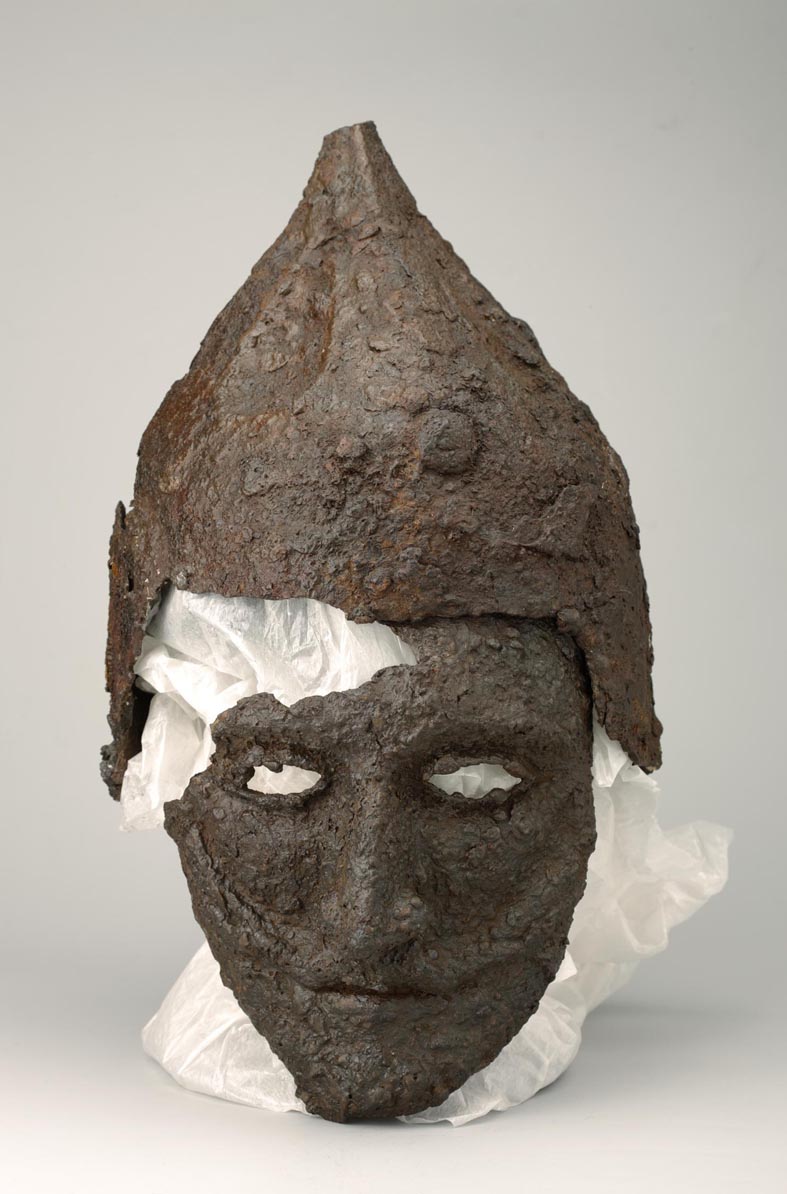
Шолом та залізна маска. ХІІ — початок ХІІІ ст. Курган біля с.Липовець, Київщина, (зараз Обухівський р-н), Україна. Розкопки 1892 р. О. Н. Макаревича. Місце зберігання: музей Державний Ермітаж, Санкт-Петербург, Росія. Інв. № 904-2, 904-12. (зображення з сайту Державного Ермітажу)
Helmet and iron mask. 12th — early 13th century. Burial mound near Lypovets village, Kyiv region (present Obukhiv district), Ukraine. Excavations of 1892 conducted by O. Makarevych. Place of storage: State Hermitage Museum, St. Petersburg, Russia. Inv. Nr. 904-2, 904-12 (image taken from the State Hermitage website)
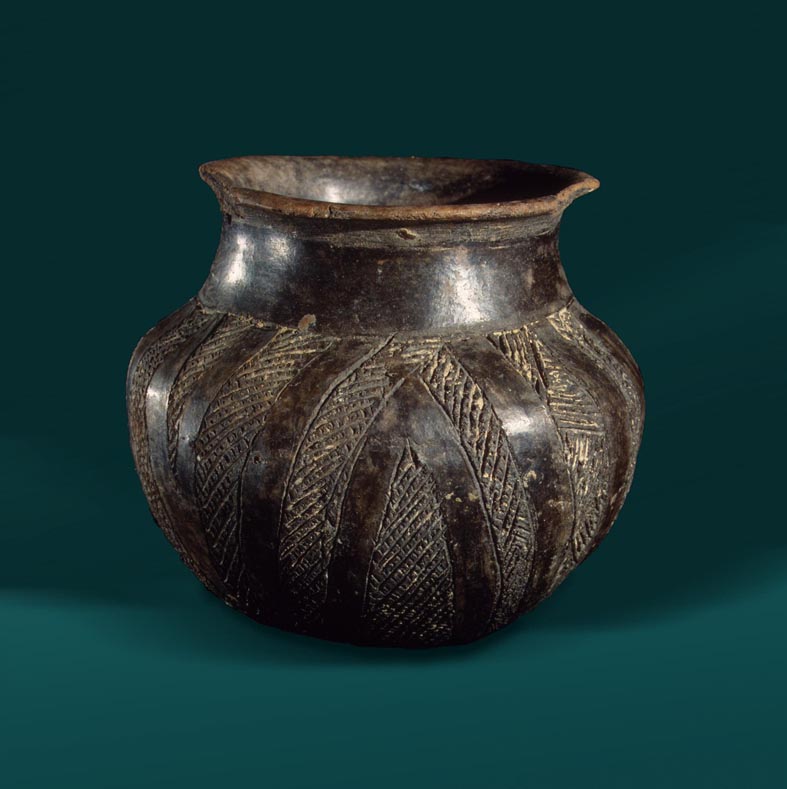
Круглодонна посудина. Ранній залізний вік. Курган 455, с. Макіївка Черкащина, (зараз Черкаський р-н), Україна. Розкопки Н. Є. Бранденбурга. Місце зберігання: музей Державний Ермітаж, Санкт-Петербург, Росія. Інв. № Дн.1932-55/2 (зображення з сайту Державного Ермітажу)
Round-bottomed vessel. Early Iron Age. Burial Mound 455, Makiivka village, Cherkasy region (present Cherkasy district), Ukraine. Excavations conducted by N. Brandenburg. Place of storage: State Hermitage Museum, St. Petersburg, Russia. Inv. Nr. Dn. 1932-55/2 (image taken from the State Hermitage website)

Вигляд “Кутузовский коридор” Державного Ермітажу. 2017 р. (зображення з сайту Державного Ермітажу)
Kutuzov Corridor of the State Hermitage Museum. 2017 (image taken from the State Hermitage website)
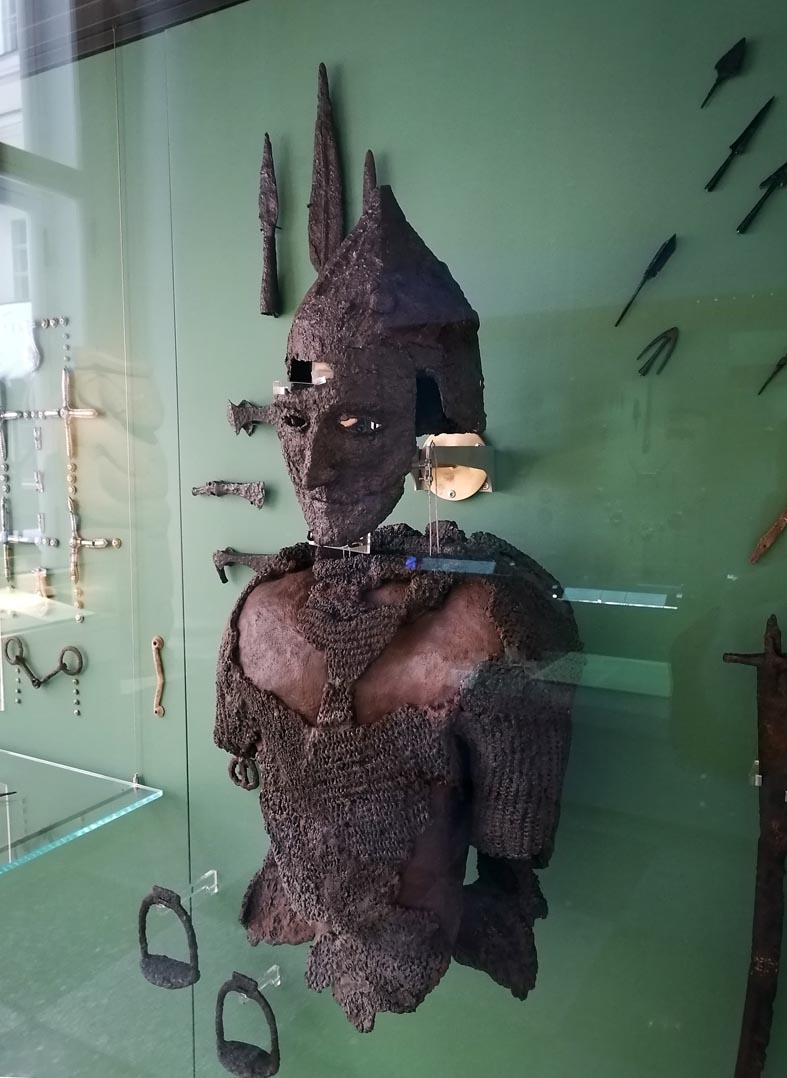
Вітрина з предметами кургану біля с. Липовець на Київщині. Державного Ермітаж. 2017 р. (зображення з Вікіпедії)
Showcase with items from the burial mound near Lypovets village in the Kyiv region. State Hermitage. 2017 (image taken from Wikipedia)

Карта розташування курганів розкопаних Н. Є. Бранденбургом в Пороссі (підготовлена автором)
Map of the location of the burial mounds excavated by N. Brandenburg in Porossiya (prepared by the author)
18.12.2022
Випуск 15. Скарб монет ХІ—ХІІІ ст. із Хотина
У 1889 році на території м. Хотин (тоді повітовий центр Бессарабської губернії) під час обробітку орендованої землі міщанин Архип Озарчук знайшов великий скарб срібних монет. За посередництва Російської імператорської академії наук і бессарабського віце-губернатора скарб передали до Ермітажу, де помилково назвали «Аккерманським». Хранитель Мюнцкабінету імперського музею відразу оцінив рідкісну знахідку як перший відомий йому скарб брактеатів. Від ХІХ ст. звичною практикою для Ермітажу був продаж музейних предметів, зокрема й вилучених з регіонів знахідок, за кордон. Тож екземпляри монет кращої збереженості з Хотинського скарбу росіяни продали німцям — в зібрання Берлінського мюнцкабінету та Нижньосаксонського крайового музею в Ганновері.
Загалом до складу скарбу входило від 1000 до 1600 монет. Понад 900 цілих і фрагментованих екземплярів і зараз знаходяться у зібранні Ермітажу.
Попри офіційні звернення до керівництва Ермітажу, росіяни систематично відмовляли українським науковцям бодай ознайомитися з цією колекцією середньовічних монет із Хотина.
З-поміж монет ідентифіковано 888 брактеатів, два денарії та один напівбрактеат. Брактеати — срібні монети, карбовані на тонкому кружку металу лише з одного боку (верхнім штемпелем на м’якій поверхні), через що зображення на аверсі виходило опуклим, а на реверсі — увігнутим. Вони мали діаметр до 40—45 мм і вагу близько 1 г. Мистецько виконані брактеати з Хотинського скарбу карбовані імператорами Священної Римської імперії, а також низкою світських і духовних вельмож на монетних дворах Тюрингії, Саксонії, Гарцу, Магдебурга, Гессена, Каринтії та Богемії. Найдавнішою монетою в скарбі є двохсторонній денарій угорського короля Соломона (1063—1074), а найпізнішими — мейсенські брактеати 30—50-х років ХІІІ ст. Більшість брактеатів з колекції, карбованих в 1190—1220-х роках на німецьких землях, призначалися майже виключно для місцевого обігу, тож за цими межами є вкрай рідкісними. Ці монети оцінювали за вагою срібла. Тому деякі монети складені кілька разів чи фрагментовані, а вартість всього скарбу могла прирівнюватися до ціни приблизно 3 коней або ж до десятка корів.
Ці монети, із німецьких земель через Угорщину, зокрема Трансильванію, потрапили на землі Галицько-Волинського князівства і можуть відображати шлях з Угорщини до Києва й далі до волзьких булгар. Припускають, що скарб заховав у 1217—1218 роках один із учасників п’ятого хрестового походу, очолюваного угорським королем Ендре ІІ. Очевидно, Хотинський депозит пов’язаний із перипетіями боротьби короля Данила проти угорських загарбників та боярської опозиції у 1230 році. Його заховали біля давньої і важливої переправи через р. Дністер, яка спершу прикривалася городищем із дерев’яно-земляними укріпленнями, а з другої половини ХІІІ ст. — кам’яним замком.
Хотинська знахідка — унікальний і єдиний скарб європейських монет XIII ст. на території Русі. Він є матеріальним підтвердженням європейських зв’язків давньоруської держави. Перебування значної його частини у російському «полоні» вириває ці сторінки з нашої історії.
Микола Ільків,
кандидат історичних наук, голова Чернівецького регіонального підрозділу ВГО «Спілка археологів України», асистент кафедри всесвітньої історії Чернівецького національного університету імені Юрія Федьковича
Release 15. Khotyn Treasure of coins of the 11th—13th century
In 1889, the burgher Arkhyp Ozarchuk found a large treasure of silver coins when he cultivated the leased land in the territory of the city of Khotyn (the then district center of the Bessarabian province). Through the mediation of the Russian Imperial Academy of Sciences and the Bessarabian vice-governor, the treasure was transferred to the Hermitage, where it was mistakenly named Akkerman treasure. The custodian of the Münzkabinet of the imperial museum immediately assessed the rare find as the first treasure of bracteates known to him. Since the 19th century, it has been the Hermitage’s common practice to sell museum items abroad, including finds exported from the regions. Therefore, the Russians sold the better-preserved coins from the Khotyn hoard to the Germans, namely to the collection of the Berlin Münzkabinet and the Lower Saxony State Museum in Hanover.
In total, the treasure included 1,000 to 1,600 coins. More than 900 whole and fragmented specimens still remain in the collection of the Hermitage.
Despite official appeals to the Hermitage management, the Russians systematically refused Ukrainian scientists even to get acquainted with this collection of medieval coins from Khotyn.
Among the coins, 888 bracteates, two denarii, and one half-bracteate have been identified. Bracteates represent silver coins minted on a thin circle of metal on only one side (with an upper stamp on a soft surface), due to which the image on the obverse turned out to be convex, and on the reverse — concave. They had a diameter of up to 40—45 mm and a weight of about 1 g. Artistically executed bracteates from the Khotyn treasure were minted by the emperors of the Holy Roman Empire, as well as by a number of secular and spiritual nobles at the mints of Thuringia, Saxony, Harz, Magdeburg, Hesse, Carinthia, and Bohemia. The oldest coin in the hoard is the double-sided denarius of the Hungarian King Solomon (1063—1074), and the latest ones are the Meissen bracteates of the 30s—50s of the 13th century. Most of the bracteates from the collection, minted in the 1190s—1220s in German lands, were intended almost exclusively for local circulation, so they are extremely rare to be found outside of these borders.
These coins were valued by the weight of silver. Therefore, some coins were folded several times or fragmented. The value of the entire treasure could be equal to the price of approximately three horses or a dozen cows. These coins got to the Galicia-Volyn principality from the German lands through Hungary, in particular Transylvania, and can reflect the way of Bulgars from Hungary to Kyiv and further to the Volga. It is assumed that the treasure was hidden in 1217—1218 by one of the participants of the fifth crusade led by the Hungarian king Endre II. Obviously, the Khotyn deposit is connected with the vicissitudes of King Danylo's struggle against Hungarian invaders and boyar opposition in 1230. It was hidden near the old important crossing over the Dniester River, which was first protected by a hillfort with wooden and earthen fortifications, and since the second half of the 13th century by a stone castle.
The Khotyn discovery is a unique treasure of European coins of the 13th century in the territory of Kyivan Rus’. It is a material confirmation of the European ties of the Kyivan Rus’ state. The fact that its significant part is in Russian “captivity” tears these pages out of our history.
Mykola Ilkiv,
PhD in history, Head of the Chernivtsi Regional Division of the Ukrainian Archaeologists Union, assistant professor of the Department of World History of the Yuriy Fedkovych Chernivtsi National University
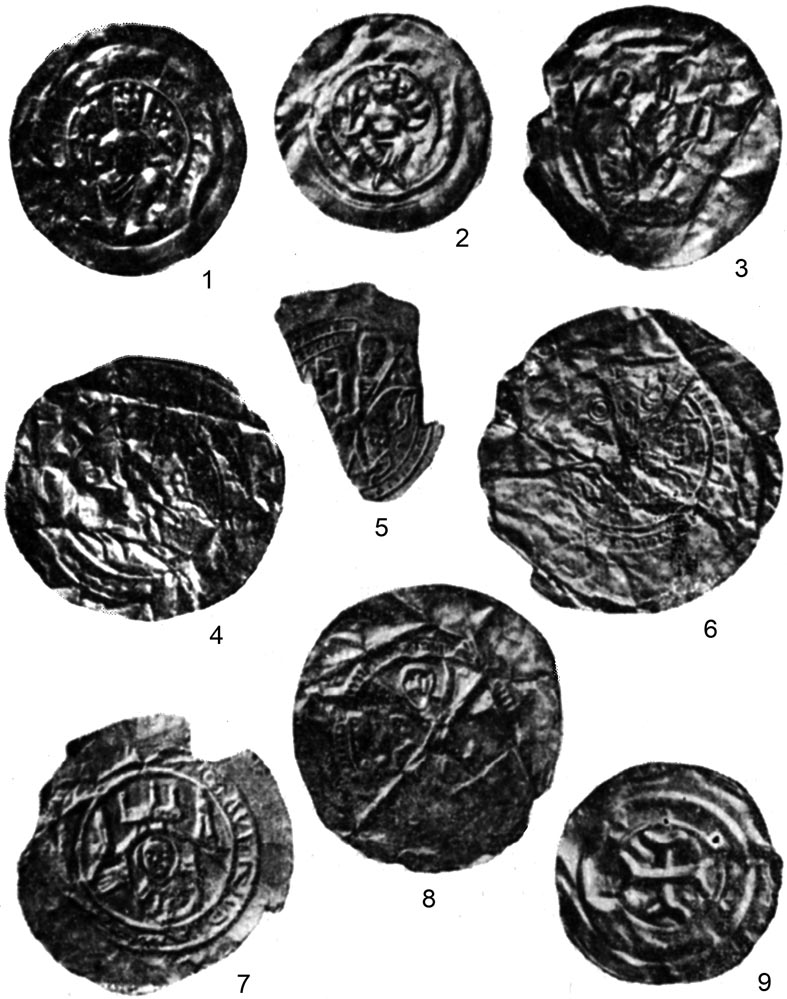
Монети Хотинського скарбу: 1, 2 — Альтенбург, імператор Фрідріх І (1152—1190) і його наступники (до 1210 р.); 3 — Ерфурт, Христіан І (1160—1161, 1165—1183); 4 — Мансфельд, Бурхард І (1184—1229); 5 — Тюрингія, Людвіг ІІІ (1172—1190); 6 — Тюрингія, Герман І (1190—1217); 7 — Галле, Альберт (1205—1232); 8 — Ешвеге, Гертруда (бл. 1180—1188); 9 — Пегау, Зігфрід (1185—1224) (Державний Ермітаж, за Потин 1963)
Coins of the Khotyn treasure: 1, 2 — Altenburg, Emperor Frederick I (1152—1190) and his successors (until 1210); 3 — Erfurt, Christian I (1160—1161, 1165—1183); 4 — Mansfeld, Burhard I (1184—1229); 5 — Thuringia, Ludwig III (1172—1190); 6 — Thuringia, German I (1190—1217); 7 — Halle, Albert (1205—1232); 8 — Eschwege, Gertrude (c. 1180—1188); 9 — Pegau, Siegfried (1185—1224) (State Hermitage, according to Potyn 1963)

Брактеат Вальтера III (1176—1196), графа Арнштайна, монетний двір Хетштедт і Гардольфа фон Харбке (1193—1201) (?), єпископство Хальберштадт (Державний Ермітаж, за Чернышов 2021)
Bracteate of Walter III (1176—1196), Count Arnstein, Mint of Hetstedt and Hardolph von Harbke (1193—1201) (?), Bishopric of Halberstadt (State Hermitage, according to Chernyshov 2021)
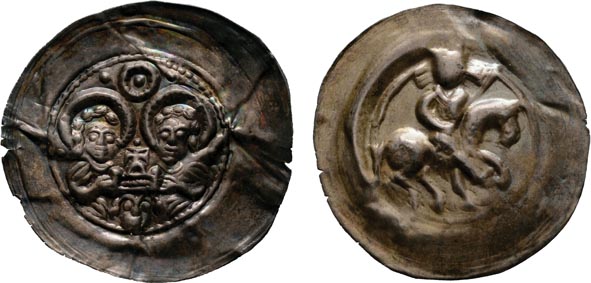
Брактеати Гослару (із зображенням поясних портретів святих Симона та Юди з німбами, які тримають корону, монетний двір Гослар (діаметр — 31—32 мм; вага — 0,79 г) й Оттона І, землі Вельфів, з 1235 р. герцогство Брауншвейг і Люнебург, монетний двір Геттінген (діаметр — 30,5—31 мм; вага — 0,765 г; Нижньосаксонський крайовий музей у Ганновері)
Bracteates of Goslar (depicting a half-length portrait of Saints Simon and Jude with halos holding crowns, Goslar Mint (diameter — 31—32 mm; weight — 0.79 g)) and Otto I, Land of the Welf, from 1235 Duchy of Braunschweig and Lüneburg, Göttingen mint (diameter — 30.5—31 mm; weight — 0.765 g; Lower Saxon State Museum Hanover)
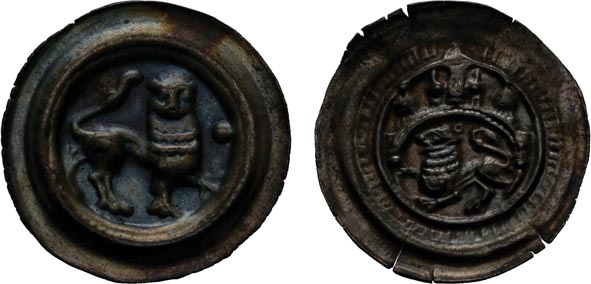
Брактеати Генріха ІІІ, землі Вельфів, герцогство Саксонія, монетний двір Люнебург (діаметр — 20,5—23,5 мм; вага — 0,535—0,54 г; Нижньосаксонський крайовий музей у Ганновері)
Bracteates of Henry III, Welf lands, Duchy of Saxony, Lüneburg mint (diameter — 20.5—23.5 mm; weight — 0.535—0.54 g; Lower Saxon State Museum in Hanover)

Брактеати Фрідріха II, Фогт фон Ольдеслебен (бл. 1189—1217), графство Бейхлінген, монетний двір Бад-Франкенхаузен (діаметр — 45 мм; вага — 0,89 г; Нижньосаксонський крайовий музей у Ганновері) й Оттона ІV, Мюльхаузен / Тюрінгія, Священна Римська імперія, монетний двір Мюльхаузен / Тюрінгія (діаметр — 45,5—46 мм; вага — 0,73 г; Нижньосаксонський крайовий музей у Ганновері)
Bracteates of Frederick II, Vogt von Oldesleben (ca. 1189—1217), Beichlingen County, Bad Frankenhausen Mint (diameter — 45 mm; weight — 0.89 g; Lower Saxon State Museum in Hanover) and Otto IV, Mühlhausen / Thuringia, Holy Roman Empire, Mühlhausen / Thuringia mint (diameter — 45.5—46 mm; weight — 0.73 g; Lower Saxon State Museum in Hanover)

Брактеати Оттона ІV, землі Вельфів, Священна Римська імперія, монетний двір Вольфенбюттель, Брауншвейг (діаметр — 26—27 мм; вага — 0,765—0,81 г; Нижньосаксонський крайовий музей у Ганновері)
Bracteates of Otto IV, Welfs lands, Holy Roman Empire, Wolfenbüttel mint, Braunschweig (diameter — 26—27 mm; weight — 0.765—0.81 g; Lower Saxon State Museum in Hanover)
22.12.2022
Випуск 16. Гетьманські гармати в полоні російських музеїв
За століття колоніальної залежності українських земель від Москви, росіяни вивезли до метрополії безліч історико-культурних цінностей. Якщо поява археологічних знахідок у російських музеях зумовлена курганною лихоманкою та пошуком золотих скарбів, то речі мистецької цінності, здебільшого, росіяни привласнили наприкінці гетьманування Івана Мазепи (початок 18 ст.) через планомірний варварський грабунок українських міст.
Серед речей, що їх вкрали російські «вельможі», особливе місце посідають козацькі гармати — видатні зразки українського барокового людвисарства. Зокрема, це стосується творів українських майстрів з Глухова — Йосифа та Карпа Балашевичів. Нині відомо близько десяти творів цих майстрів-людвисарів, що виготовлені на замовлення гетьмана Івана Мазепи та гадяцького полковника Михайла Бороховича. Левова частка цих пам'яток ливарництва зберігається у музейних установах Санкт-Петербурга (Центральний військово-морський музей, Російський Державний Ермітаж, Воєнно-історичний музей артилерії, інженерних військ і військ зв’язку) та у Москві (Російський державний історико-культурний музей-заповідник «Московський Кремль»).
Так російська імперія привласнила бронзову довгоствольну 16-фунтову гармату «Лев».
Карп Йосифович Балашевич відлив її 1705 року у Глухові на замовлення Івана Мазепи й рясно оздобив бароковими орнаментами та геральдичними знаками Гетьмана. Як і інші українські гармати та клейноди мазепинської доби, ці вироби московити захопили, коли громили українські міста у 1708—1709 роках. Після цих подій з України було вивезено не лише генеральну артилерію, а й більшу частину сотенної. Частину гармат великого калібру було знищено в Батурині. Всю запорозьку артилерію було конфісковано після штурму Січі 14 травня 1709 р. За повідомленням сучасника тих подій, ганноверського дипломата Фрідріха Вебера «Московський генерал Мєньшиков приніс Україні всі страхіття помсти та війни. Всіх приятелів Мазепи безчесно катовано. Україна залита кров’ю, зруйнована грабунками і виявляє скрізь страшну картину варварства переможців». Варварство переможців яскраво виявилося, зокрема, у діяльності «московського генерала Мєньшикова» який знищив і розграбував у Батурині бібліотеку гетьмана та величезну колекцію творів мистецтва та зброї.
Надалі, вкрадені в Гетьмана та української старшини речі, склали основу приватної збірки Мєньшикова його резиденції у Санкт-Петербурзі. Згодом, ці речі, серед яких були безцінні артефакти української історії, почасти потрапили до Ермітажу, частково до інших музеїв Росії і стали фундаментом, на якому розвивалася музейна справа імперії.
Вже за часів радянської влади, на хвилі вдаваної боротьби з імперським минулим, уряд Української СРР 1929 року звернувся до Російської СФРР з вимогою повернути в підрадянську Україну низку мистецьких історико-культурних цінностей, вивезених свого часу царськими урядниками у Москву та Санкт-Петербург. Однак навіть попри домовленості Паритетної комісії у 1930 році, чимало старожитностей пов’язаних з Україною та її історією, росіяни так і не повернули. Це стосується і виробів українських майстрів-людвисарів з Глухова, які досі зберігаються в російських музейних установах.
Юрій Пуголовок,
кандидат історичних наук, заступник Голови правління ВГО “Спілка археологів України”
Release 16. Hetman cannons in captivity of Russian museums
During the centuries of colonial dependence of the Ukrainian lands on Moscow, the Russians removed many historical and cultural values to the metropolis. The appearance of archaeological finds in Russian museums is a result of the burial mound excavation rush and the search for gold treasures. On the other side, the Russians appropriated the artworks for the most part, at the end of the Ivan Mazepa hetmanship (the early 18th century) through systematic barbarian looting of Ukrainian cities.
Among the items stolen by the Russian “nobles”, Cossack cannons hold a special place as outstanding examples of Ukrainian baroque foundry. In particular, this concerns the works of Ukrainian masters from Glukhov — Yosyf and Karp Balashevych. At present, about ten works of these foundry masters are known, made by order of Hetman Ivan Mazepa and Gadyach colonel Mykhailo Borohovych. The lion's share of these works of foundry art are kept in museum institutions in St. Petersburg (the Central Naval Museum, the Russian State Hermitage, the Military-Historical Museum of Artillery, Engineer Troops and Signal Troops) and in Moscow (the Moscow Kremlin State Museum-Preserve of History and Culture).
Thus, the Russian Empire appropriated the bronze long-barreled 16-pounder Lev (Lion) cannon.
Karp Balashevych cast it in 1705 in Glukhiv by order of Ivan Mazepa and richly decorated it with baroque ornaments and heraldic signs of the Hetman. Like other Ukrainian cannons and kleynods of the Mazepa era, these works were captured by Muscovites when they smashed Ukrainian towns in 1708-1709. After these events, not only the general but also most of the sotnia artillery was exported from Ukraine. Some of the large-caliber guns were destroyed in Baturin. All Zaporozhian artillery was confiscated after the storming of Sich on May 14, 1709. According to a contemporary of those events, Hanoverian diplomat Friedrich Weber, “Moscow General Menshikov brought to Ukraine all the horrors of revenge and war. All of Mazepa's friends were dishonorably tortured. Ukraine is drenched in blood, destroyed by looting, and shows everywhere a terrible picture of the barbarism of the victors”. The barbarism of the victors was clearly manifested, in particular, in the actions of the “Moscow general Menshikov”, who destroyed and looted the hetman's library and a huge collection of works of art and weapons in Baturin.
Later, the things stolen from the Hetman and the Ukrainian foreman formed the basis of Menshikov's private collection at his residence in St. Petersburg. Subsequently, these things, which included priceless artifacts of Ukrainian history, part went to the Hermitage, and partly to other museums of Russia and became the backbone for the development of the museum affair of the empire.
Already during the time of Soviet power, in the wake of the pretended struggle with the imperial past, the government of the Ukrainian SSR in 1929 appealed to the Russian SFRY with the demand to return to the sub-Soviet Ukraine a number of artistic, historical, and cultural values, which had been taken by tsarist officials to Moscow and St. Petersburg. However, even despite the agreement of the Parity Commission in 1930, the Russians didn’t return many antiquities related to Ukraine and its history. That includes the works of Ukrainian foundry masters from Glukhiv, which are still kept in Russian museum institutions.
Yuriy Pugolovok,
PhD in History, Deputy Chairman of the Board of the Ukrainian Association of Archaeologists
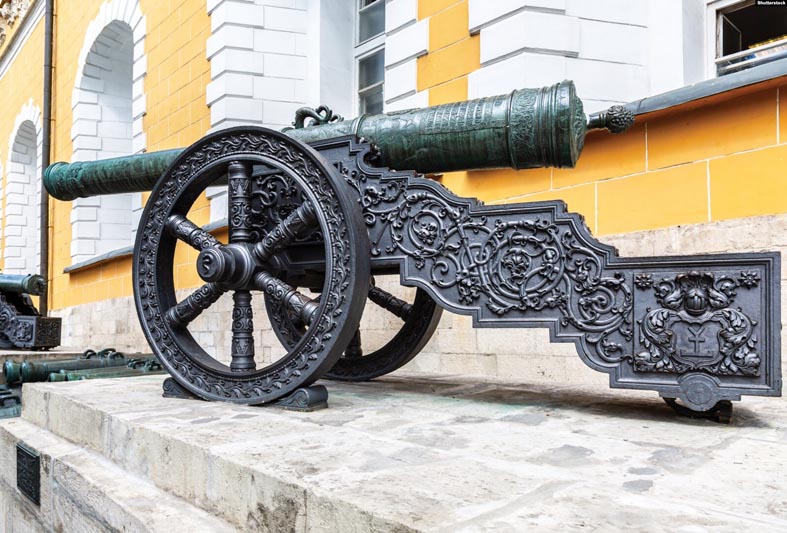
Бронзова довгоствольна гармата «Лев» (1705 рік), роботи майстра Карпа Балашевича. Зберігається в Російському державному історико-культурному музеї-заповіднику «Московський Кремль»
Bronze long-barreled Lev (Lion) cannon (1705), the work of master Karp Balashevych. Stored in the Moscow Kremlin State Museum-Preserve of History and Culture
Джерело | Source: radiosvoboda.org
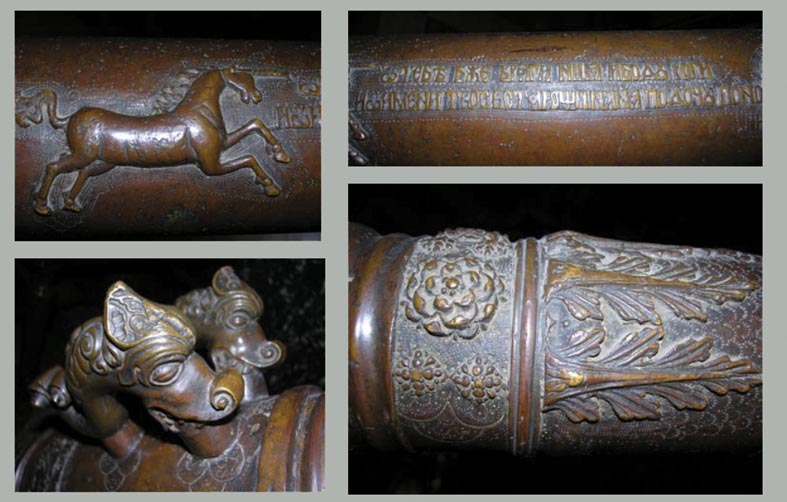
Фрагменти ствола гармати полтавського полковника П. Герцика (1692 р.), роботи майстра Йосифа Балашевича. Зберігається у Воєнно-морському музеї Санкт-Петербурга
Fragments of the cannon barrel of the Poltava colonel Pavlo Hertsyk (1692), the work of master Yosyf Balashevych. Stored in the Naval Museum of St. Petersburg
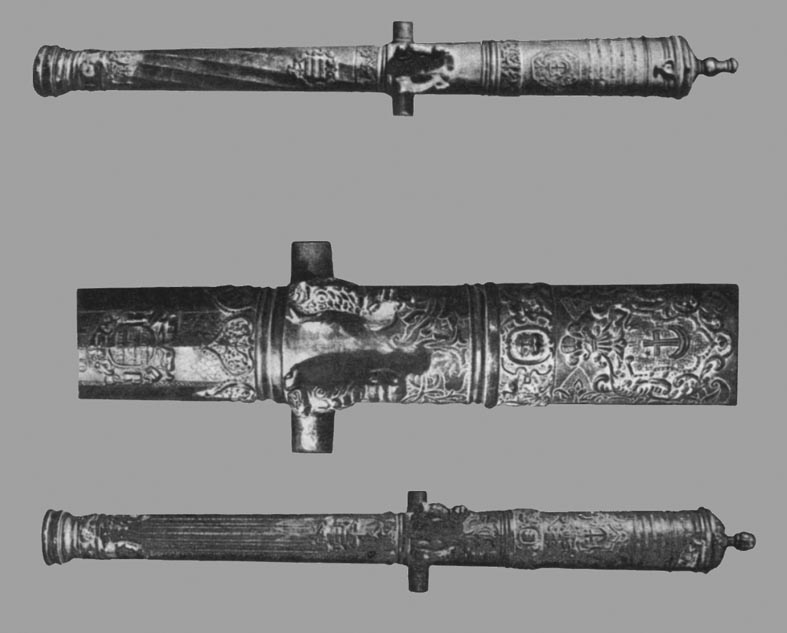
Гармати гадяцького полковника М. Бороховича (1693, 1697 р.), роботи майстра Йосифа Балашевича. Зберігається в Російському Державному Ермітажі, Санкт-Петербург
Guns of Gadyach colonel Mykhailo Borohovych (1693, 1697), the work of master Yosyf Balashevych. Stored in the Russian State Hermitage, St. Petersburg

Бронзова мортира Генеральної артилерії Івана Мазепи (1698 р), роботи майстра Карпа Балашевича. Зберігається в Артилерійському музеї Санкт-Петербурга
Bronze mortar of the General Artillery of Ivan Mazepa (1698), the work of master Karp Balashevych. Stored in the Artillery Museum of St. Petersburg
Джерело, решта | Source, rest: Мальченко, О. 2007. Художнє лиття гармат у Гетьманщині за часів правління Івана Мазепи. Київ: Інститут української археографії та джерелознавства НАНУ
26.12.2022
Випуск 17. Сасанідське срібло з Луганщини
Історія виявлення та подальшої долі двох срібних сасанідських посудин з території сучасної Луганщини дуже стисла і не містить жодних важливих деталей. Відомо лише, що врешті решт знахідки опинилися у Державному Ермітажі.
Сенмурв і «дерево життя». У 1823 році поблизу с. Павлівки Старобільського повіту Слобідсько-Української губернії (тепер — с. Павлівка Старобільського району Луганської області) під час оранки невеликого кургану місцеві селяни «випадково» знайшли комплекс речей: срібний з позолотою глек для вина із зображенням міфічного божества Сенмурва, дві срібні чаші та дерев’яне сідло.
Срібний вузькогорлий глек для вина має злив у вигляді качиного дзьоба, вишукано вигнуті ручку й ніжку. На тулубі посудини методами карбування та різьблення виконано два овальних медальйони із зображеннями Сенмурва (собако-птаха) зі здійнятими крилами, висунутими уперед лапами з пазурами та пащею, з якої звисає довгий тонкий язик. Зображення Сенмурва розділені стилізованим деревом життя.
Знайдені речі тривалий час зберігав місцевий поміщик Т. Лайко. А у лютому 1896 р. срібний глек для вина потрапив на фотографування до Імператорської археологічної комісії вже з приватної колекції великого князя Олексія Олександровича, знаного колекціонера предметів старовини. Доля інших знахідок невідома.
Бутель із зображенням жінок, що танцюють. У 1872 р. біля слободи Лимарівка того самого Старобільського повіту (тепер — с. Лимарівка Старобільського району Луганської області) знайшли срібний глек із зображенням чотирьох танцюючих жінок. Образи жінок зображено в арках, встановлених на кручених стовпчиках. Кожна танцівниця одягнена у напівпрозорий хітон та тримає у руках власний атрибут: птах і посудина з плодами; птах і гілка з плодом гранату; птах і сістр (ударний музичний інструмент); чаша з гранатами і плід. Срібний глек тривалий час перебував у приватній колекції Строганових, а пізніше потрапив до Ермітажу.
Місцем знахідки обох срібних посудин, що й до сьогодні знаходяться у російському музеї, зазначені населені пункти Старобільського повіту без жодних вказівок на те, що це територія сучасної України. Обидві знахідки є виробами перських майстрів часів правління в Ірані династії Сасанідів (III—VII ст.). Тож потрапити на землі теперішньої України ці вироби могли або внаслідок торговельних операцій, або ж як власність мігрантів-кочівників. Ці вишукані зразки декоративно-ужиткового мистецтва Іранської держави часів династії Сасанідів — дуже рідкісні знахідки для наших теренів. Зауважимо, що окрім двох посудин з Луганщини, росіяни вивезли до Державного Ермітажу також іранські речі зі знаного Перещепинського скарбу (територія сучасної Полтавщини) та срібну чашу з південної Волині (с. Хоняки, тепер — Хмельниччина). З цією чашею пов’язана майже детективна історія про те, як завдяки маніпуляціям і хитрощам тодішнього керівництва Ермітажу, артефакт виманили з фондів Державного музею мистецтва (сьогодні Музей Ханенків). Детальніше про цю та інші історії вивезення предметів східної колекції музею тут: historians.in.ua
Олександр Принь,
кандидат історичних наук, провідний науковий співробітник Мистецького Арсеналу
Сергій Теліженко,
кандидат історичних наук, старший науковий співробітник, Інститут археології НАН України; Луганський регіональний підрозділ ВГО «Спілка археологів України»
Release 17. Sasanian silver from Luhansk region
The history of the discovery and further destiny of two silver Sasanian vessels from the territory of the modern Luhansk region is very brief and does not contain any important details. It is only known that the finds ended up in the State Hermitage.
Senmurv and the "Tree of life". In 1823 near the Pavlivka village of the Starobil district of the Sloboda Ukraine province (the present village of Pavlivka of the Starobil district of the Luhansk region) while plowing a small burial mound, local villagers "accidentally" found a set of items: a silver and gilded wine jug with the image of the mythical deity Senmurv, two silver bowls, and a wooden saddle.
A silver narrow-necked wine jug had a duckbill spout and an elegantly curved handle and stem. Two oval embossed and carved medallions decorate the body of the vessel. They depict Senmurv (dog-bird deity) with raised wings, outstretched clawed paws, and a mouth with a protruding tongue. Sentmurv's images are separated by a stylized tree of life.
The found artifacts were kept by the local landowner T. Laiko for a long time. And in February 1896, the Imperial Archaeological Commission photographed a silver wine jug already from the private collection of Grand Prince Oleksiy Olexandrovych, a well-known collector of antiquities. The fate of other finds is unknown.
A bottle with the image of dancing women. In 1872, a silver jar with the images of four dancing women was found near the village of Lymarivka in the same Starobil district (now the village of Lymarivka, Starobil district, Luhansk region). Images of women are depicted in arches mounted on twisted columns. Each dancer is dressed in a translucent chiton and holds her own attribute: a bird and a vessel with fruits; a bird and a branch with a pomegranate fruit; a bird and a sistrum (percussion musical instrument); a bowl with pomegranates and a fruit. The silver jar was kept in the Stroganovs’ private collection and later went to the Hermitage.
The place of discovery of both silver vessels, which are still stored in the Russian museum, are listed as settlements of the Starobil district without any indication that this is the territory of modern Ukraine. Both finds were made by Persian masters during the reign of the Sassanid dynasty in Iran (the 3rd—7th centuries). Therefore, these artifacts could get to the lands of present-day Ukraine either as a result of trading or as the property of migrant nomads. These exquisite examples of decorative and applied art of the Iranian state under the Sassanid dynasty are sporadic finds in our territory. It should be noted that in addition to the mentioned vessels from the Luhansk region, the Russians also took to the State Hermitage Iranian items from the well-known Pereshchepinsky treasure (territory of modern Poltava region) and a silver cup from southern Volyn (Khonyaki village, now Khmelnytsk region). Almost a detective story is connected with this bowl when the then management of the Hermitage by manipulating and tricking the State Museum of Art (now the Khanenko Museum) into giving them the artifact. You can find more details about this and other stories of the removal of items from the museum's oriental collection at the following link: historians.in.ua
Oleksandr Pryn,
PhD in history, leading researcher of Mystetskyi Arsenal
Serhii Telizhenko,
PhD in history, senior researcher, the Institute of Archeology of the National Academy of Sciences of Ukraine; Luhansk regional branch of the Ukrainian Association of Archaeologists
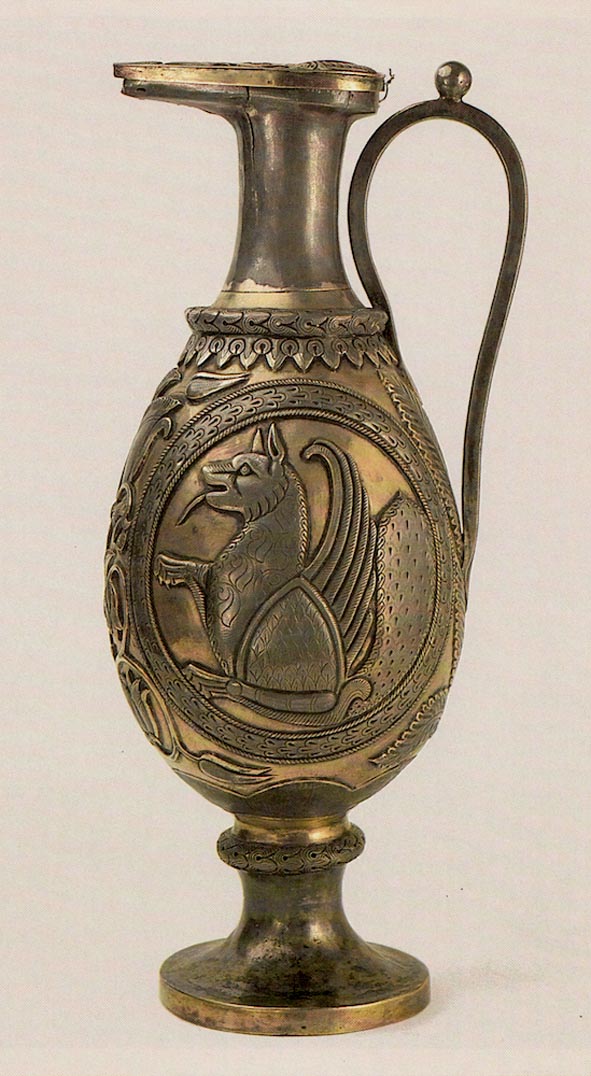
Срібний глек із зображенням Сенмурва і дерева життя
Silver Sasanian vessel: Senmurv and the "Tree of life"
Джерело | Source: Zoroastrianism in History and Imagination. Brunei Gallery in London, United Kingdom www.meer.com

Зображення "дерева життя" на срібному глекові
"Tree of life" on the vessel
Джерело | Source: Тревер, К. В., Луконин, В. Г. 1987. Сасанидское серебро. Собрание государственного Эрмитажа.

Зображення срібного глека зі сторінки Hermitage Museum Sassanid Metal Bowls
A pictute of the silver vessel from site of Hermitage Museum Sassanid Metal Bowls
Джерело | Source: users.stlcc.edu

Джерело | Source: eurasiansilver.com
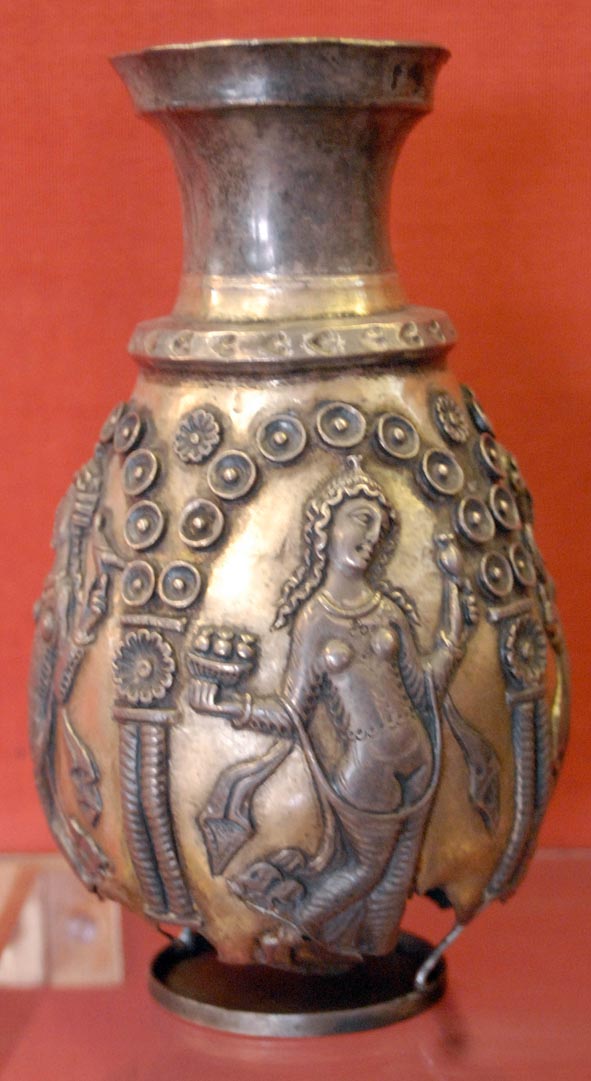
Бутель із зображенням жінок, що танцюють
A bottle with the image of dancing women
Джерело | Source: Hermitage Museum Sassanid Metal Bowls users.stlcc.edu

Джерело | Source: Тревер, К. В., Луконин, В. Г. 1987. Сасанидское серебро. Собрание государственного Эрмитажа.

Походження фото невідоме | The origin of the photo is unknown
4.01.2023
Випуск 18. Інженерні дива, або як Ермітаж гончарний водовід з Солхата вивіз
Масове вивезення археологічних знахідок з кримських пам’яток, яке розпочав Державний Ермітаж ще у ХІХ столітті, було й є частиною колоніальної політики, спрямованої на вилучення матеріальної складової минулого з контексту його побутування. Здавалося б, перепоною цьому грабунку мало стати набуття Україною незалежності 1991 року і розділення музейних фондів та академічних інституцій. Але “Геть від Москви!” не стало гаслом молодої української археології, залежність якої від імперських “академічних центрів” формувалась протягом майже двох століть.
Одна з ознак цієї токсичної колоніальної залежності — продовження розкопок на території незалежної України експедиціями російських дослідників, зокрема експедицією Марка Крамаровського в Солхаті (Старому Криму). Обов’язковою вимогою — передавати знахідки до кримських музеїв як частини музейної мережі України — російські археологи відверто нехтували. Унікальні артефакти з розкопок накопичували на базі Старокримської археологічної експедиції Державного Ермітажу в Криму, й тишком вивозили до російського імперського музейного центру. Таким чином вже після 1991 року з поцуплених артефактів росіяни сформували представницьку колекцію зі Старого Криму.
Окупація Криму 2014 року розв’язала російським крадіям-археологам руки — вивезення знахідок з Солхату до Державного Ермітажу набуло розмаху.
Одними з ключових маркерів технологічного розвитку та зв’язків Криму із Середземномор’ям є збережені елементи системи водопостачання середньовічного міста: керамічні труби, розподільчі і поворотні блоки. Стала традиція формування міського середовища в Криму, зокрема інфраструктури, налічувала понад тисячу років і мала свій початок в античних полісах. В центральних містах Російської Імперії централізовані водогони почнуть з’являтися лише на 450 років пізніше, ніж Кримському улусі Золотої Орди, який російською історіографією буде всіляко зображатися “диким регіоном”. При цьому залишки водогонів XIV століття було розкопано не лише в тодішній столиці — Солхаті, але й в Кафі, Гезлеві, Солдайї, в тому числі експедиціями Ермітажу.
Під час незаконних розкопок під орудою російських археологів у 2016 році в північно-східній частині городища Солхат виявили фрагмент середньовічного водоводу завдовжки майже 20 метрів, окремі секції якого, були в стані “близькому до ідеального”. Марк Крамаровський, враховуючи глибину залягання водогону (2 метри від сучасної денної поверхні), припустив, що воду в цій частині городища відбирали за допомогою чигира (механізм для піднімання води, у вигляді колеса із розташованими на ньому черпаками) із використанням сили тяглової худоби. Окрім труб, росіяни розкопали “технологічний блок”, який дозволяв змінювати напрямок водогону під кутом. Втім, жодної спроби консервації і музеєфікації виявленого водогону “in situ” (тобто на місці), грабіжники з російської метрополії не здійснили, а 6 фрагментів і “технологічний блок” вивезли до Санкт-Петербурга.
Цими ж фрагментами середньовічного водогону, вилученими під час незаконних археологічних розкопок в тимчасово окупованому Криму 2016 року і нелегально включеними до колекції Ермітажу, росіяни хизувалися на виставці “Золота Орда і Причорномор’я. Уроки Чингизидської імперії”, що проходила у Казані.
Тож вкотре Росія безкарно вкрала й привласнила собі безцінні археологічні джерела, що засвідчують сталий цивілізаційний розвиток на теренах сучасної України.
Денис Яшний,
кандидат історичних наук, провідний науковий співробітник Національного заповідника “Києво-Печерська лавра”, аналітик ГО “Кримський інститут стратегічних досліджень”
Release 18. Engineering marvels, or how the Hermitage took out the clay aqueduct from Solkhat
The State Hermitage initiated the mass removal of archaeological finds from Crimean sites as long ago as the 19th century in line with the colonial policy aimed at removing the material component of the past from the context of its existence. It would seem that Ukraine’s independence in 1991 and the separation of museum funds and academic institutions should have prevented this looting. But “Keep away from Moscow!” did not become the slogan of young Ukrainian archaeology, whose dependence on imperial “academic centers” was formed for almost two centuries.
One of the signs of this toxic colonial dependence is that expeditions of Russian researchers continued to excavate on the territory of independent Ukraine, notably Mark Kramarovsky’s expedition in Solkhat (Staryi Krym). Russian archaeologists openly neglected the mandatory requirement to transfer finds to Crimean museums as part of the museum network of Ukraine. Unique artifacts discovered during excavations were accumulated at the base of the Staryi Krym Archaeological Expedition of the State Hermitage in Crimea. They were transported underhand to the Russian Imperial Museum Center. Thus, after 1991, the Russians formed a representative collection of the Staryi Krym composed of collected artifacts.
The occupation of Crimea in 2014 gave a free hand to Russian thieves-archaeologists. The removal of finds from Solkhat to the State Hermitage gained momentum.
One of the key indicators of the technological development and connections of Crimea with the Mediterranean Sea are the preserved elements of the water supply system of the medieval city: clay pipes, distribution and rotary units. The established tradition of the urban environment formation in Crimea, particularly infrastructure planning, is more than a thousand years old and goes back to the ancient polis. Public water supply appeared in the central cities of the Russian Empire 450 years later than in the Crimean ulus of the Golden Horde, which Russian historiography will represent as an “uncivilized region” in every possible way. At the same time, along with other expeditions, the Hermitage expeditions excavated the remains of aqueducts of the 14th century not only in the then capital — Solkhat, but also in Kafi, Gezlev, and Soldaiya. During illegal excavations conducted by Russian archaeologists in 2016, in the northeastern part of the Solkhat hill-fort, a fragment of a medieval aqueduct almost 20 meters long was discovered. Its separate sections were in close to perfect condition. The depth of the aqueduct was two meters from the present daylight surface. Mark Kramarovskyi assumed that the water in this part of the hillfort was extracted with the help of a water wheel (a mechanism for the water drawing, in the form of a wheel with dippers) using the physical force of draft cattle. In addition to the pipes, the Russians dug up a “process unit” that allowed changing the direction of the water line at an angle. However, the robbers from the Russian metropolis did not attempt to conserve and museify the discovered water pipe “in situ”. They took six fragments and a “process unit” to St. Petersburg.
Russians flaunted the same fragments of the medieval water supply, removed during illegal archaeological excavations in the temporarily occupied Crimea in 2016 and illegally included in the Hermitage collection, at the “Golden Horde and the Black Sea. Lessons of the Chingizid Empire” Exhibition in Kazan.
So, once again, with impunity, Russia has stolen and appropriated invaluable archaeological evidence of the steady development of civilization on the territory of modern Ukraine.
Denys Yashnyi,
PhD in history, leading research worker of the National Preserve “Kyiv-Pechersk Lavra”, analyst of the Crimean Institute for Strategic Studies NGO

Кам’яний блок “розводки” водогону з розкопок Солхата 2016 р. «Державний Ермітаж» інв. № Сол-186
Stone block of the water supply distribution. From Solkhat excavations in 2016. State Hermitage inv. Nr. Sol-186
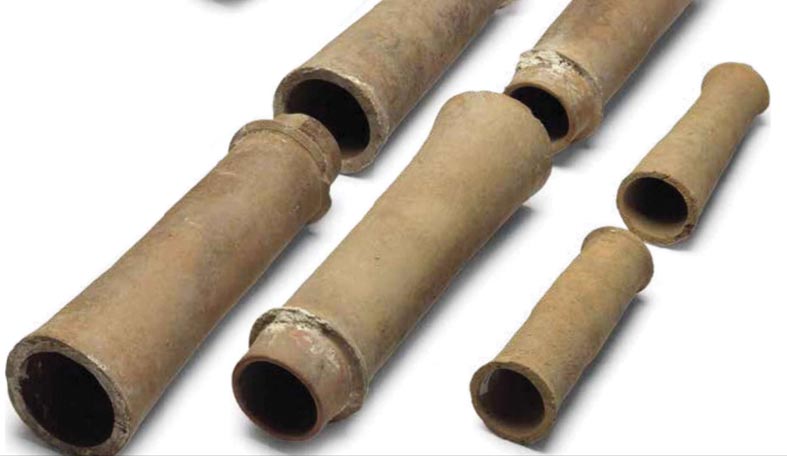
Шість секцій глиняного водогону з розкопок Солхата 2016 р. «Державний Ермітаж» інв. № Сол-170—175
Six sections of clay aqueduct. From Solkhat excavations in 2016. State Hermitage inv. Nr. Sol-170—175
Золотая Орда и Причерноморье: уроки Чингисидской империи: каталог выставки [2 апреля — 6 октября 2019 г., Казань] / авт. вступ. ст. М. Г. Крамаровский, кат. № 275, 277.
Golden Horde and the Black Sea: lessons from the Chingizid Empire: Exhibition catalogue [April 2 — October 6, 2019, Kazan] / author’s introduction art by Mark Kramarovsky, cat. Nr. 275, 277.
7.01.2023
Випуск 20. Чоловічок із Чорної могили
Славетну Чорну могилу, насип якої до сьогодні височіє у Чернігові, можна без перебільшення назвати найвизначнішим з розкопаних давньоруських курганів. Цей курган чи не єдиний, який можна класифікувати як князівський. Датовано комплекс широко — другою половиною Х ст., — і належить до часу, який дав нам найяскравіші комплекси періоду ранньої Русі (див. випуск 19).
Археологічні дослідження, проведені тут у 1872—1873 рр., виявили складний поховальний обряд за типом кремації на місці і дуже багато знахідок, що містилися на двох рівнях. Більша частина — безпосередньо на кострищі, але деякі речі спеціально поклали окремо, на вищому рівні, коли кострище вже засипали землею і насип кургану сягнув половини його сучасної висоти. Серед цих предметів була й невеличка фігурка з мідного сплаву. Через значну кількість окислів, що вкривали її поверхню, було складно розгледіти деталізовані риси. Єдине, що тоді зрозуміли — цей чоловічок сидить з підібганими ногами, а руки знаходяться перед грудьми.
Ініціатор і автор розкопок російський імперський археолог Дмитро Самоквасов описав її як «божка, який сидить навшпиньки, з руками на грудях». В дужках він додав — «(Будда?)». Чоловічка з Чорної могили, як і переважну більшість виявлених під час дослідження кургану знахідок, Д. Самоквасов вивіз до Москви, де вони перебувають й до сьогодні у складі колекцій Державного історичного музею.
Антропоморфну знахідку спочатку почистили до такого стану, щоб зрозуміти, що це дійсно фігурка чоловіка, який тримає свою довгу бороду у правій руці, а лівою стискає якийсь предмет, який було незворотньо втрачено. І що сидить він дійсно зі складеними ногами, а голова його лиса.
Лише півтора століття потому фігурку остаточно дочистили і побачили чимало деталей. Виявилося, що перехрещені ноги чоловічка — босі; вдягнений на нього каптан — короткий; одяг — багато декорований; фігурка підперезана довгим, теж густо декорованим поясом, зав’язаним на кінцях вузлами; а на шиї чоловічка — ланцюг або кручена гривна. Сама ж фігурка містить рештки позолоти, тож у своєму первісному вигляді виблискувала коштовним металом.
На території України така фігурка є єдиною та унікальною знахідкою і має неабияке значення для історії та культури Русі. Усі аналогії походять зі скандинавських країн, або ж з регіонів, де скандинави були рясно присутні за доби вікінгів. І навіть там такі фігурки є також рідкісними знахідками. Окрім чернігівської, їх відомо лише п’ять.
Спільними рисами для них є те, що це дорослі чоловіки з лисою головою; два з них мають на голові конічні шоломи. Також вони усі мають довгу бороду, скручену джгутами або заплетену в коси, яку тримають в одній або у двох руках. Всі фігурки виконані у сидячій позі — лотоса, або ж на декорованому троні.
Ті, що виявлені у багатих похованнях, супроводжувалися наборами пішаків для скандинавської середньовічної настільної гри hnefatafl. Королі й пішаки мають ідентичні розміри основи для зручного розміщення їх на ігровій дошці. Західноєвропейські дослідники інтерпретують їх як королів гри hnefatafl.
Натомість російські дослідники досі тиражують визначення Д. Самоквасова, який вважав цю фігурку божком і атрибутують її як скандинавського бога Тора, що спотворює уявлення і про князя, похованого в Чорній могилі, і про вірування русів, і про їхній світогляд та матеріальну культуру, і навіть про те, як вони проводили своє дозвілля.
Привласнюючи артефакти з Чорної могили, росіяни привласнюють і історію князівської доби, а оперуючи інформацією про ці знахідки, заробляють науковий авторитет. Але варто нарешті визнати, кому належить ця археологічна спадщина і чия це історія.
Наталя Хамайко,
молодший науковий співробітник відділу Наукові фонди Інституту археології України та співробітниця Ляйбніц-Інституту історії та культури Центральної та Східної Європи (ГВЦО)
Release 20. The little man from the Chorna Mohyla
The famous Chorna Mohyla, the mound that still stands in Chernihiv, without exaggeration, can be called the most remarkable of the excavated Ancient Rus burial mounds. This burial mound is almost the only one that we can classify as princely. The complex is broadly dated to the second half of the 10th century and belongs to the time that gave us the most outstanding sites of the Early Rus period (see the release 19).
Following the archaeological research carried out in 1872—1873 on the site, it was discovered a complex funeral rite of the cremation type and a large number of finds contained on two levels. Most of the items were put directly on the pyre, but some objects were specially placed separately, on a higher level, when the pyre was already covered with earth, and the earthen mound reached half its current height. Among these items was a small figurine made of copper alloy. Due to a significant amount of oxides covering its surface, it was difficult to see details. At the time, it could be only distinguished that this little man was sitting with folded legs and hands in front of his chest.
The initiator and author of the excavation, the Russian imperial archaeologist, described the figurine as “a god sitting on tiptoes with hands in front of his chest”. In parentheses, he added — (Buddha?). Dmytro Samokvasov took the little man from the Chorna Mohyla to Moscow along with most of the finds discovered during the study of the burial mound, where they are still kept in the collection of the State Historical Museum.
Initially, the anthropomorphic find was cleaned to such a degree to see that it was indeed a figurine of a man holding his long beard in his right hand and clutching some object that had been irretrievably lost with his left hand. And that he is really sitting folded legs, and his head is bald.
Only a century and a half later, the figurine was finally cleaned and many details could be seen. It turned out that the little man is barefoot; he is dressed in short kaftan; his clothes are lavishly decorated; the figure is girded with a long, also richly decorated belt, tied at the ends with knots; and on the man's neck is a chain or a twisted hryvnia. There are still traces of gilding on the figurine, so, in its original form, it sparkled with precious metal.
On the territory of Ukraine, such a figurine is the only and unique find and has great significance for the history and culture of Rus. All analogies come from Scandinavian countries and regions where Scandinavians were numerous during the Viking Age. And even there, such figurines are also rare finds. Apart from Chernihiv, only five of them are known.
All these figurines have in common that they represent adult men with bald heads. Two of them are wearing conical helmets. Also, they all have long beards, twisted in plaits or braided, which they held in one or both hands. All figurines are made in a lotus position, or sitting on a decorated throne.
Figurines, found in rich burials, were accompanied by sets of pawns for the hnefatafl Scandinavian medieval board game. Kings and pawns have identical base dimensions for convenient placement on the game board. Western European researchers interpret them as kings of the hnefatafl game.
Instead, Russian researchers still reproduce the version of Dmytro Samokvasov. He considered this figurine a god and attributed it to the Scandinavian god Thor, which distorts the idea of the prince buried in the Chorna Mohyla, the beliefs of the Rus, their worldview and material culture, and even how they spent their leisure time.
By appropriating the artifacts from the Chorna Mohyla, the Russians are also adopting the history of the princely era. By operating with information about these finds, they are earning scientific credibility. But it should be finally recognized to whom this archaeological heritage belongs and whose history it is.
Natalia Khamaiko,
Institute of Archaeology, National Academy of Science of Ukraine; Leibniz-Institut für Geschichte und Kultur des östlichen Europa (GWZO)
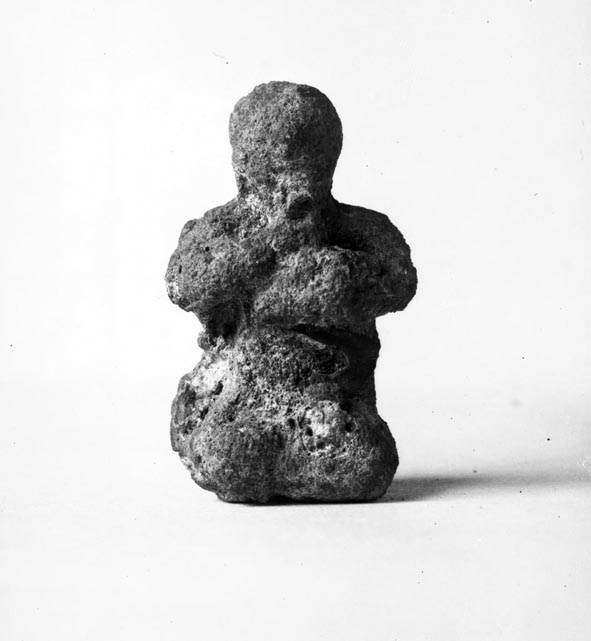
Вигляд чоловічка з Чорної могили у нерозчищеному вигляді (Архів фотовідділу ДІМ, негатив №12278, 1934 р.)
Little man from the Chorna Mohyla before the cleaning (Archive of the Photo Department of the State Historical Museum, negative Nr. 12278, 1934)

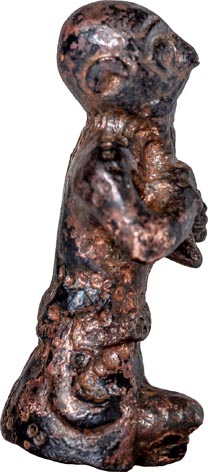
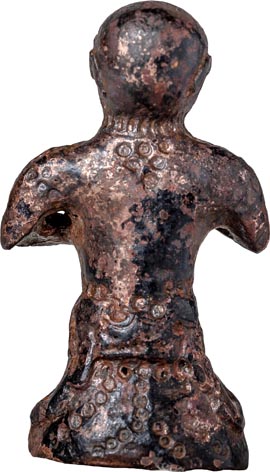
Чоловічок з Чорної могили
Little man from the Chorna Mohyla
16.01.2023
Випуск 21. “Стою я, відваги пам’ятник…”:
“евакуйована” стела з Херсонського краєзнавчого музею
У жовтні 2022 року російська окупаційна влада оголосила про “евакуацію” Херсонського обласного краєзнавчого музею. Росіяни розграбували археологічну й історичну експозиції, викравши різночасові археологічні знахідки, колекцію нумізматики, історичну зброю. І хоч більша частина археологічної колекції музею, яка містилася у фондосховищі, збереглася, деякі знакові і впізнаванні предмети звідти зникли.
Серед поцуплених росіянами артефактів — унікальна стела Леокса (початок V ст. до н. е.), знайдена під час розкопок на некрополі Ольвії і передана до Херсонського музею ще у 1895 році. Сучасне місцезнаходження цього музейного предмета, після вивезення його росіянами, невідоме.
Стела виготовлена з прямокутної мармурової плити, на двох сторонах якої — рельєфні зображення, а на бічних гранях нанесено написи. На одній стороні зображено оголеного воїна, який спирається правою рукою на спис, а ліву тримає на талії. На іншій стороні — профільне зображення фігури у скіфському костюмі — короткому каптані, що щільно облягає тіло, і вузьких штанях, із звисаючим з лівої сторони при поясі сагайдаком та луком. Верхня і нижня частини плити втрачено, тому зображення голів і нижньої частини ніг обидвох фігур відсутні. Якщо трактовка оголеної фігури сумнівів не викликає (це і є власне Леокс), то щодо іншої фігури дослідники й досі не дійшли згоди. В ній вбачають скіфа / грека / елінізованого варвара, або, навіть, амазонку.
Реконструкція і переклад написів на бічних гранях такі: на одній “Стою я, відваги пам’ятник, й кажу, що за місто загинув далеко, й лежить Леокс, син Мельпагора”, на іншій “Пам’ятником я є Леокса, сина Мельпагора”.
Якщо ототожнення фігури у скіфському костюмі із амазонкою вірне, то це одне з найперших рельєфних зображень жінки-воїтельниці в античному мистецтві. А цей сюжет є сам по собі достатньо цікавим. Образ жінки-воїтельниці був популярним серед сюжетів чорно- та червонофігурних посудин, які використовували, зокрема, і під час симпозію. Образ, який сприймався як чудовий жарт, травестійний образ світу, де все догори дригом, став для античних греків реальним після контактів зі скіфами в Північному Причорномор’ї.
Із втратою стели Леокса українська і світова культурна спадщина втратила один із шедеврів античної скульптури. Крадіжка предмета, сюжетне навантаження якого, вперше за довгий час його існування, співзвучне з сучасними подіями, підкреслює варварську суть російського агресора.
Сергій Нємцев,
молодший науковий співробітник Національного історико-археологічного заповідника Ольвія НАН України
Release 21. “I stand, a monument to courage...”:
“Evacuated” stele from the Kherson Local History Museum
In October 2022, the Russian occupation authorities announced the “evacuation” of the Kherson Regional Museum of Local History . The Russians looted the archaeological and historical expositions, having stolen archaeological finds from different periods, a numismatics collection, and historical weapons. Although most of the archaeological collection was kept in the Museum storage and thus preserved, some iconic and recognizable items disappeared.
Among the artifacts pulled off by the Russians is the unique Leox stele (the early 5th century BC), found during excavations at the Olbia necropolis and transferred to the Kherson Museum in 1895. The current location of this museum item, after its removal by the Russians, is unknown.
The stele is made of a rectangular marble slab with relief images on its two sides and inscriptions on the side faces. On one side, a naked warrior is depicted, resting his right hand on a spear and holding his left hand on his waist. On the other side is a profile image of a figure in Scythian costume — a short caftan that fits tightly around the body and narrow trousers, with a quiver and a bow hanging from the left side at the waist. The upper and lower parts of the slab were lost. The images of the heads and lower legs of both figures are missing. If the interpretation of the naked figure does not raise doubts (it is Leox), the researchers have still not reached an agreement about the other figure. They consider it a Scythian / Greek / Hellenized barbarian or even an Amazon.
The reconstruction and translation of the inscriptions on the side faces are as follows: on one side, it is written, “I stand, a monument to courage, and say that Leox, son of Melpagoras, died defending the city and lies far away”, on the other side — “I am the monument to Leox, son of Melpagoras”.
Suppose the identification of the figure in the Scythian costume with the Amazon is correct. In that case, it will be one of the earliest relief images of a female warrior in ancient art. This scene is quite interesting. The image of a female warrior was a typical scene on black- and red-figure dishware, which was used, in particular, during the symposia. The image, which was perceived as a great joke, a travesty image of a world where everything is upside down, became real for the ancient Greeks after contact with the Scythians in the Northern Black Sea region.
With the loss of the Leox stele, Ukrainian and world cultural heritage lost one of the masterpieces of ancient sculpture. The theft of an object featuring the scene, consonant with current events for the first time in its long existence, emphasizes the Russian aggressor's barbaric nature.
Serhii Nemtsev,
junior researcher of the Olbia National Historical and Archaeological Preserve of the National Academy of Sciences of Ukraine
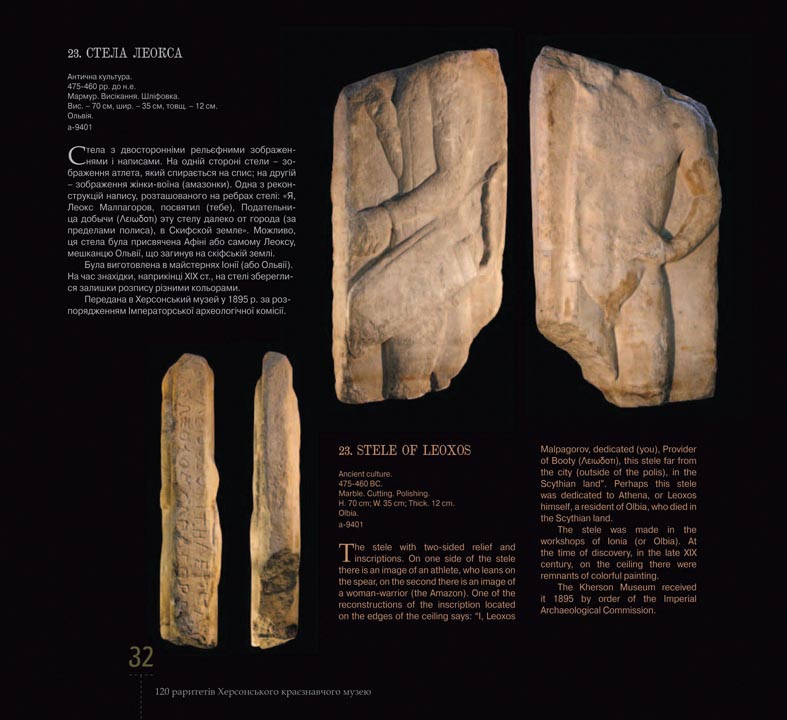


21.01.2023
Випуск 22. Михайлівський Золотоверхий собор: вкрадене, понівечене, привласнене
Михайлівський собор у Києві збудовано на честь Архистратига Михаїла у 1108—1113 роках за часів правління князя Святополка Ізяславича. Первинно це був шестистовпний тринавний хрестокупольний храм із золотим куполом, за що отримав назву Золотоверхий. Стіни собору прикрашали золочені мозаїки і фрески. Тут зберігали мощі святої великомучениці Варвари, привезені 1108 року до Києва дружиною князя Святополка Ізяславича, дочкою візантійського імператора Олексія І Комніна Варварою. Святополк збудував Михайлівський собор в ім’я свого хрестильного патрона. Одночасно Архистратиг Михаїл був покровителем святого воїнства, тож можливо, будівництво храму також пов’язане із перемогою князя над половцями.
Вважається, що сам монастир, де пізніше постав золотоверхий храм, заснував батько Святополка князь Ізяслав ще у 1050-х рр. Один з найбільших у давньому Києві, монастир на честь Архистратига Михаїла був княжим й протягом ХІІ ст. слугував місцем поховання київських князів.
Під час монгольського погрому 1240 р. обитель поруйнували й пограбували. Залишилася згадка про те, що монголи здерли і вивезли золото з покрівлі собору. Тривалий час потому практично все Верхнє місто Києва було пусткою, утім на територіях монастирів життя тривало. З кінця ХІV ст. місто починає відроджуватися, а монастирське життя активізується.
Одним із перших про мозаїки Михайлівського Золотоверхого собору без уточнення сюжетів згадує Еріх Лясота у своїх щоденникових записах 1594 р. Мозаїчні сюжети описав архідиякон Павло Алепський у 1654 р.
Золочений верх собору відновлено 1655 р. за сприяння гетьмана Богдана Хмельницького. Оздоби собору кількаразово поновлювали, а більшість фресок ХІІ ст. відкрили у 1888 р. під час капітального ремонту храму, яким керував київський архітектор, художник та мистецтвознавець Адріян Прахов.
У 1918 р., коли російські більшовики обстрілювали Київ, екстер’єри Михайлівського собору постраждали. На щастя тоді імперські варвари не пошкодили інтер’єрів храму.
Однак, після остаточного встановлення радянської влади в Україні, більшовицькі посадовці не лише домоглися припинення релігійного життя, а й призвели до фізичного знищення архітектурного ансамблю обителі. Так 1922 року тоталітарна влада ліквідувала монастир й пристосувала пам'ятки історії та культури для потреб різних установ. Після перенесення столиці підрадянської України з Харкова до Києва 1934 року радянські можновладці вирішили знести низку будівель (у тому числі Михайлівський Золотоверхий собор) для розбудови урядового центру.
У постанові Політбюро ЦК КП(б)У від 18 лютого 1934 року вказано: «Взяти за основу нового будівництва центральних установ [у Києві] район Софійського майдану і Михайлівського монастиря з тим, щоб зараз розпочати розробку проектів». А в протоколі засідання того ж Політбюро від 27 березня 1934 р. конкретизовано: «Відповідно до постанови від 18 лютого про нове будівництво центральних установ в районі Софійської площі і Михайлівського монастиря запропонувати Всеукраїнському Центральному виконавчому комітету видати постанову (без опублікування в пресі) про знесення Михайлівського монастиря».
Чимало діячів культури і науки висловилися про недоцільність цього рішення й неприпустимість знищення унікального історико-культурного об'єкту. На що нарком Володимир Затонський відповів: «Вчені любителі мотлоху всіляко домагаються збереження собору в цілісності. <…> повідомляю, що питання про знесення <…> вирішене. Може йтися лише про зняття мозаїк і фресок. Чим довше будуть зволікати, тим менше часу залишиться для цієї операції. <…> Винні будуть самі лахмітники» (більше про це читайте в матеріалах виставки «Наказано не знати» uinp.gov.ua).
До обміру та демонтажу мозаїк та фресок князівської доби залучили сили Київського художнього інституту. Втім роботами зі зняття фресок керували російські фахівці — з червня до середини вересня 1934 р. проф. Дмітрій Кіплік з Ленінградської Академії мистецтв, а з жовтня 1934 р. — реставратор Павєл Юкін. Демонтаж мозаїк з кінця червня до серпеня 1934 р. здійснив керівник мозаїчної майстерні ленінградської Академії мистецтв проф. Владімір Фролов. Обміри, закріплення і зняття мозаїк та фресок завершили 1935 року. Значна частина монументального оздоблення храму (перенесена на нові основи) поповнила колекцію Лаврського заповідника — Всеукраїнського музейного городка.
Імперська радянська влада знищила вибухівкою Михайлівський Золотоверхий собор 14 серпня 1937 р. Протягом 1935—1937 рр. знесли й майже усі історичні будівлі Михайлівського монастиря, а також розташовану неподалік Василівську (Трисвятительську) церкву (нині там знаходиться будівля Міністерства закордонних справ України).
Навесні 1937 року в Державному Українському музеї у Києві (тепер — Національний художній музей України), відкрили виставку пам’яток мистецтва Київської Русі. Зокрема там експонували мозаїки, фрески та два стародавні шиферні рельєфи з Михайлівського Золотоверхого собору. Однак директора Українського музею Пимона Рудякова того ж року звинуватили в українському буржуазному націоналізмі та репресували, а тогочасну експозицію музею розформували. Частину експонатів передали до Софійського собору, що на той час уже був музеєм, а частину мозаїк та фресок разом з одним сланцевим різьбленим рельєфом відправили до Москви на тимчасову виставку, організовану Державною Третьяковською галерею, звідки росіяни їх уже не повернули.
У часи Другої світової війни майже усі фрески та кілька мозаїчних фрагментів з Михайлівського Золотоверхого монастиря, що зберігалися у Києві, вивезли до Німеччини. Після реституції 1945—1946 рр. частину експонатів радянська влада розпорошила по кількох музеях СРСР, насамперед — Новгорода і Ленінграда. У процесі транспортування деякі з них загинули, а збережені пам’ятки монументального мистецтва отримали значні пошкодження.
Повні списки мозаїк та фресок Михайлівського собору оприлюднили Юрій Коренюк та Сергій Кот (Коренюк, Ю., Кот, С. 2007. Мозаїки та фрески Михайлівського Золотоверхого собору в Києві. Сучасний стан мистецької спадщини. Пам’ятки України, 4, 1, с. І—ХХХVIII).
Наприкінці 1990-х рр. Михайлівський собор відтворили у барокових архітектурних формах. Відроджений храм освячено 2000 р.
Попри те, що частину унікальних мозаїк і фресок збережено в Україні, а на початку 2000-х рр. кілька пам'яток вдалося вивільнити з російського полону й повернути до Києва, низку творів монументального мистецтва доби Київської Русі росіяни й не збираються повертати законному власникові. Сьогодні країна-агресор продовжує хизуватися українською спадщиною князівської доби, безсоромно видаючи її за своє коріння, зокрема у Третьяковській галереї фрески, мозаїки й сланцеву плиту з Михайлівського монастиря демонструють у постійній експозиції “Дрєвнєрусскоє іскусство. Домонгольскій пєріод” (зала 56).
Наталя Хамайко,
молодший науковий співробітник відділу Наукові фонди Інституту археології України та співробітниця Ляйбніц-Інституту історії та культури Центральної та Східної Європи (ГВЦО)
Анна Яненко,
кандидатка історичних наук, заступниця начальника науково-дослідного відділу історії та археології Національного заповідника “Києво-Печерська лавра”, членкиня Правління ВГО “Спілка археологів України”
Release 22. St. Michael's Golden-Domed Cathedral: stolen, mutilated, appropriated
St. Michael's Cathedral in Kyiv was built in honor of Archangel Michael in 1108—1113 during the reign of Prince Svyatopolk Izyaslavych. Initially, it was a six-pillar three-nave cross-domed temple with a golden dome, which is why it was called Golden-Domed. Gilded mosaics and frescoes decorated the walls of the cathedral. The relics of the Holy Great Martyr Barbara lay there. Barbara, the wife of Prince Svyatopolk Izyaslavych, daughter of the Byzantine emperor Alexios I Comnenus, brought the relics to Kyiv in 1108. Svyatopolk built St. Michael's Cathedral in the name of his baptismal patron. At the same time, Archangel Michael was the holy army's patron, so the temple construction may also be connected with the victory of the prince over the Polovtsy.
It is believed that Svyatopolk’s father, Prince Izyaslav, founded the monastery, where the golden-domed church was later erected, in the 1050s. One of the largest in ancient Kyiv, the monastery in honor of Archangel Michael was a princely monastery. During the 12th century, it served as a burial place for the Kyiv princes.
During the Mongols’ invasion in 1240, they destroyed and looted the monastery. There is a mention that the Mongols stripped and removed the gold from the cathedral's roof. For a long time later, almost the entire Upper City of Kyiv was a wasteland. However, life continued on the territories of the monasteries. From the late 14th century, the city begins to revive, and monastic life intensifies.
Erich Lyasota was one of the first to mention the mosaics of St. Michael's Cathedral in his diary in 1594. Archdeacon Pavlo of Aleppo described the mosaic sсenes in 1654.
Hetman Bohdan Khmelnytskyi renovated the cathedral's gilded top in 1655. The decorations of the cathedral were restored several times, and most of the frescoes of the 12th century were opened in 1888 during the major repair of the temple under the guidance of Adrian Prakhov, the Kyiv architect, painter, and art critic.
In 1918, when the Russian Bolsheviks shelled Kyiv, the exteriors of St. Michael's Cathedral were damaged. Fortunately, the imperial barbarians did not damage the church's interior.
However, after the final establishment of Soviet power in Ukraine, Bolshevik officials managed to end religious life and achieved the physical destruction of the monastery's architectural ensemble. Thus, in 1922, the totalitarian authorities liquidated the monastery and adapted the historical and cultural monuments to the needs of various institutions. After the transfer of the capital of Soviet Ukraine from Kharkiv to Kyiv in 1934, the Soviet authorities decided to demolish several buildings (including St. Michael's Gold-Domed Cathedral) to build a government center.
In the resolution of the Politburo of the Central Committee of the CP(b)U dated February 18, 1934, it was stated the following: “To plan the new construction of central institutions [in Kyiv] the area of Sophia Maidan and St. Michael’s Monastery and start the development of projects”. The protocol of the Politburo meeting dated March 27, 1934, stated: “According to the resolution of February 18 on the new construction of central institutions in the area of Sophia Square and St. Michael’s Monastery, it is proposed to the All-Ukrainian Central Executive Committee to issue a resolution (without publication in the press) on the demolition of St. Michael’s monastery”.
Many figures of culture and science considered the decision to destroy a unique historical and cultural property impractically and unreasonable. Volodymyr Zatonskyi, People's Commissar, replied to them: “Scientific lovers of junk are trying in every possible way to preserve the integrity of the cathedral. <…> I inform you that the decision to demolish <…> has been approved. It can only be about removing mosaics and frescoes. The longer they delay, the less time will remain for this operation. <…> The ragpickers themselves will be to blame” (You can find more information in the materials of the exhibition “Ordered not to know” at the link uinp.gov.ua).
The staff of the Kyiv Art Institute was involved in measuring and dismantling the mosaics and frescoes of the princely era. However, the work on removing frescoes was managed by Russian specialists - from June to mid-September 1934 by prof. Dmitry Kiplik from the Leningrad Academy of Arts, and since October 1934 by restorer Pavel Yukin. Prof. Vladimir Frolov, the head of the Leningrad Academy of Arts mosaic workshop, dismantled the mosaics from the end of June to August 1934. Measurements, fixation and removal of mosaics and frescoes were completed in 1935. A significant part of the monumental decoration of the temple (transferred to a new basis) was added to the collection of the Lavra Preserve — the All-Ukrainian Museum Town.
The Imperial Soviet authorities destroyed St. Michael's Golden-Domed Cathedral with explosives on August 14, 1937. During 1935—1937, almost all the historical buildings of St. Michael's Monastery were demolished, as well as the nearby St. Basil’s (Three Saints) Church (now the building of the Ministry of Foreign Affairs of Ukraine is located there).
In the spring of 1937, the State Ukrainian Museum in Kyiv (now the National Art Museum of Ukraine) opened an exhibition of art monuments of Kyivan Rus. In particular, mosaics, frescoes and two ancient slate reliefs from St. Michael’s Golden-Domed Cathedral were displayed there. However, in the same year, Pymon Rudyakov, the director of the Ukrainian Museum, was accused of Ukrainian bourgeois nationalism and repressed. The museum's exhibition at that time was dismantled. Part of the exhibits was transferred to St. Sophia Cathedral, which was already a museum at that time. Part of the mosaics and frescoes, together with one slate carved relief, was sent to Moscow for a temporary exhibition organized by the State Tretyakov Gallery. The Russians never returned them.
During the Second World War, almost all the frescoes and several mosaic fragments from St. Michael’s Monastery, which were kept in Kyiv, were taken to Germany. After the restitution of 1945—1946, Soviet authorities distributed some of the exhibits in several museums of the USSR, primarily in Novgorod and Leningrad. In the process of transportation, some of them perished, and the preserved monuments of monumental art were significantly damaged.
Yurii Korenyuk and Serhiy Kot published the complete lists of mosaics and frescoes of St. Michael’s Cathedral (Yurii Korenyuk, Serhiy Kot. 2007. Mosaics and frescoes of St. Michael's Golden-Domed Cathedral in Kyiv. Current state of conservation of artistic heritage. Ukrainian artworks, 4, 1, s. I—XXVIII)
At the end of the 1990s, St. Michael's Cathedral was reconstructed in Baroque architectural forms. The revived temple was consecrated in 2000.
In the early 2000s, several monuments were freed from Russian captivity and transferred back to Kyiv. Even though some of the unique mosaics and frescoes have been preserved in Ukraine, the Russians are not going to return several works of monumental art from the time of Kyivan Rus to their rightful owner. Today, the aggressor country continues to flaunt the Ukrainian heritage of the princely era, shamelessly passing it off as its roots. In particular, frescoes, mosaics and a slate slab from St. Michael’s Monastery are displayed in the permanent exhibition on the “Ancient Rus Art. Pre-Mongol period” (hall 56) in the Tretyakov Gallery.
Natalya Khamayko,
junior researcher of the Research Funds Department of the Institute of Archeology of Ukraine and employee of the Leibnitz Institute of History and Culture of Central and Eastern Europe
Anna Yanenko,
PhD in history, deputy head of the research division of history and archeology of the National Preserve “Kyiv-Pechersk Lavra”, member of the Board of the Ukrainian Association of Archaeologists
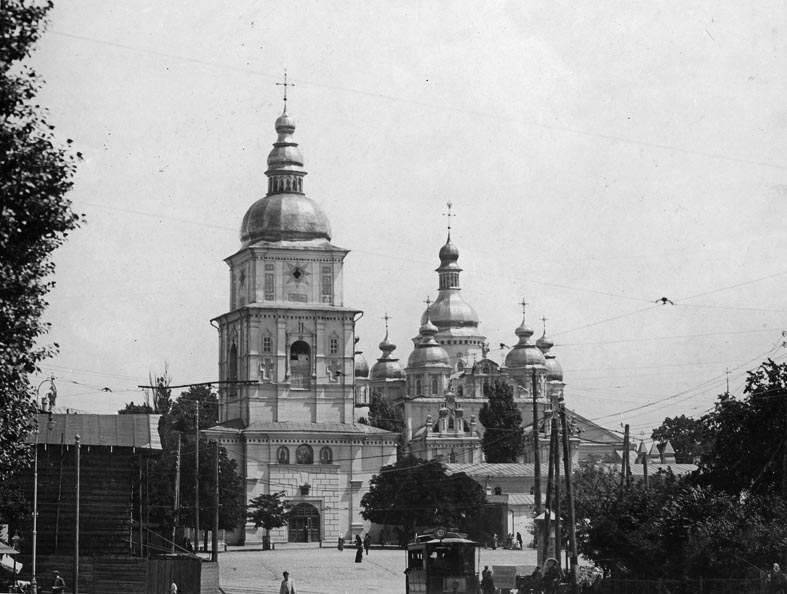
Михайлівський монастир у Києві. Фото початку ХХ ст., з колекції Національного заповідника «Києво-Печерська лавра», інв. № КПЛ-Ф-4242
St. Michael's Monastery in Kyiv. Photo of the early 20th century from the Collection of the National Preserve “Kyiv-Pechersk Lavra”, inventory Nr. KPL-F-4242
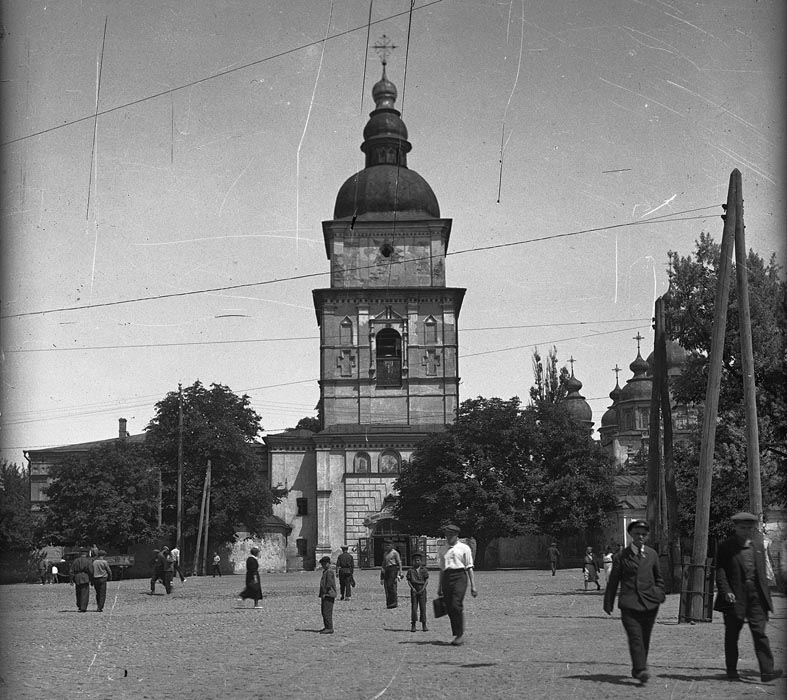
Вигляд на Михайлівський монастир у Києві. Фотографічний знімок 1920-х — початку 1930‑х рр., з колекції Національного заповідника «Києво-Печерська лавра», інв. № КПЛ-Н-3360
View of St. Michael's Monastery in Kyiv. Photo of the 1920s — early 1930s from the Collection of the National Preserve “Kyiv-Pechersk Lavra”, inventory Nr. KPL-N-3360
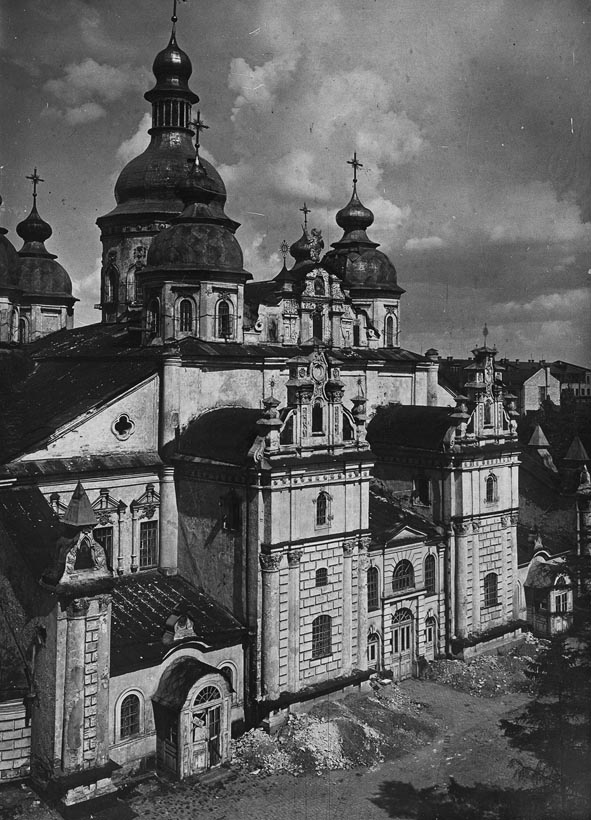
Михайлівський Золотоверхий собор у Києві. Фото першої половини 1930-х рр., з колекції Національного заповідника «Києво-Печерська лавра», інв. № КПЛ-Ф-4308
St. Michael's Golden-Domed Cathedral in Kyiv. Photo of the first half of the 1930s from the Collection of the National Preserve “Kyiv-Pechersk Lavra”, inventory Nr. KPL-F-4308
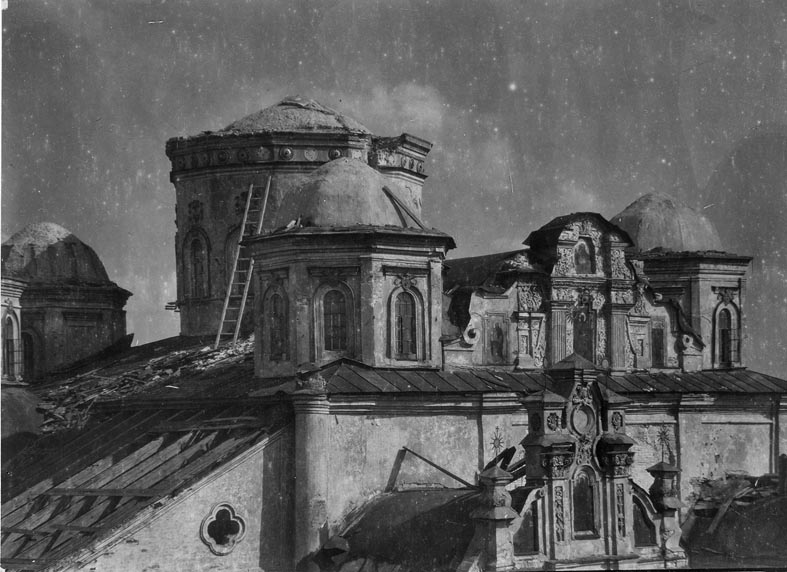
Руйнування Михайлівського Золотоверхого собору. Фото 1930-х рр., з колекції Національного заповідника «Києво-Печерська лавра», інв. № КПЛ-Ф-4344
Destruction of St. Michael's Cathedral. Photo of the 1930s from the Collection of the National Preserve “Kyiv-Pechersk Lavra”, inventory Nr. KPL-F-4344
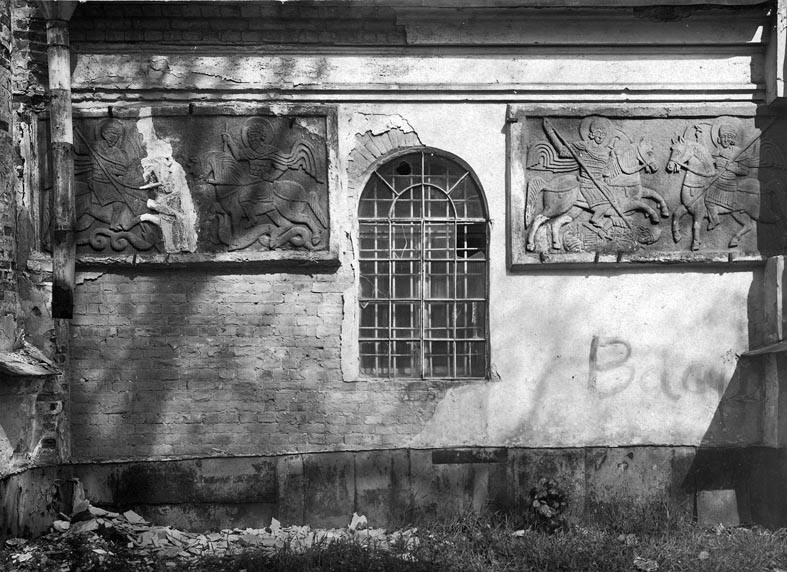
Сланцеві плити з рельєфами часів Київської Русі, вмонтовані на фасаді Михайлівського Золотоверхого собору. Фото 1930-х рр., з колекції Національного заповідника «Києво-Печерська лавра», інв. № КПЛ-Ф-4426
Carved slate slabs from the time of Kyivan Rus, mounted on the facade of St. Michael’s Golden-Domed Cathedral. Photo of the 1930s from the Collection of the National Preserve “Kyiv-Pechersk Lavra”, inventory Nr. KPL-F-4426
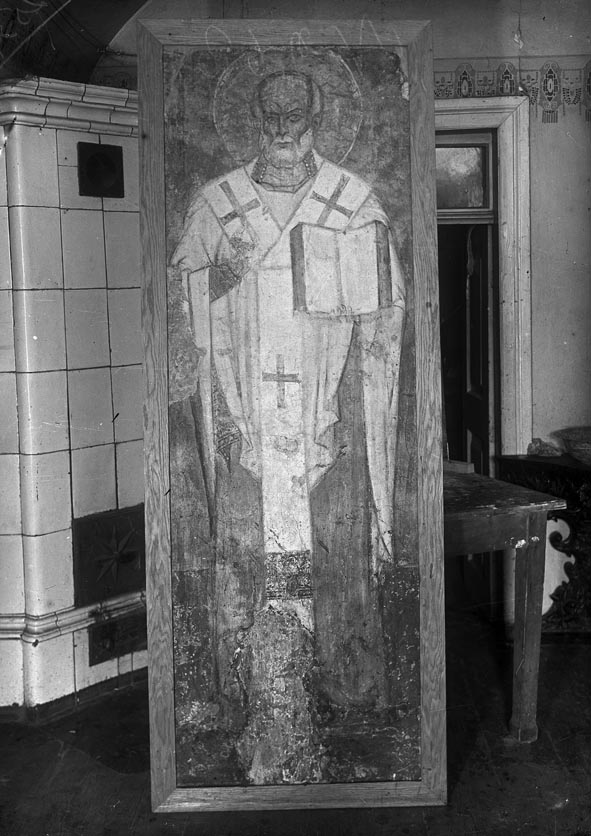
Фреска «Святитель Миколай» початку ХІІ ст. з Михайлівського Золотоверхого собору у Києві. Фотографічний знімок 1930-х рр., з колекції Національного заповідника «Києво-Печерська лавра», інв. № КПЛ-Н-1629
“Saint Nicholas” fresco of the early 12th century from St. Michael's Cathedral in Kyiv. Photo of the 1930s from the Collection of the National Preserve “Kyiv-Pechersk Lavra”, inventory Nr. KPL-N-1629
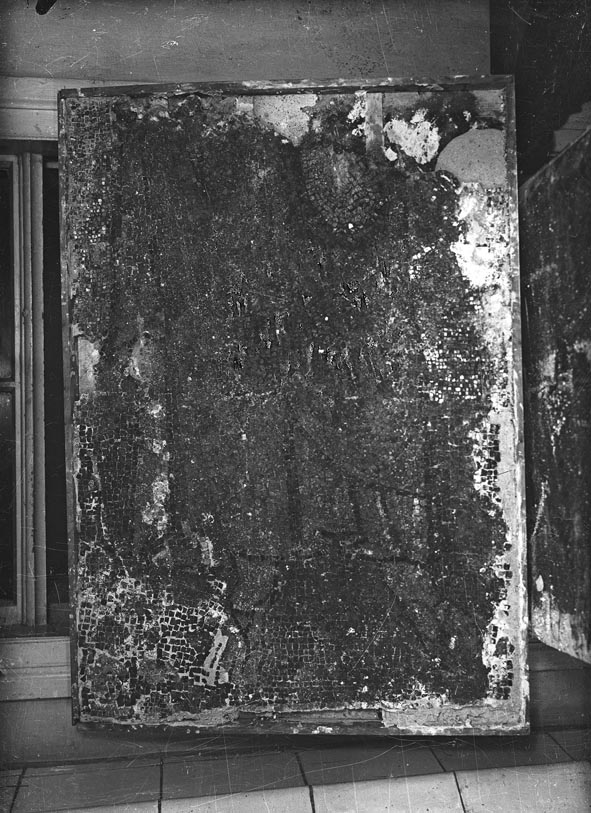
Фрагмент мозаїки «Невідомий апостол» з Михайлівського собору в Києві. Фотографічний знімок 1930-х рр., з колекції Національного заповідника «Києво-Печерська лавра», інв. № КПЛ-Н-2017
Fragment of the "Unknown Apostle" mosaic from St. Michael's Cathedral in Kyiv. Photo of the 1930s from the Collection of the National Preserve “Kyiv-Pechersk Lavra”, inventory Nr. KPL-N-2017
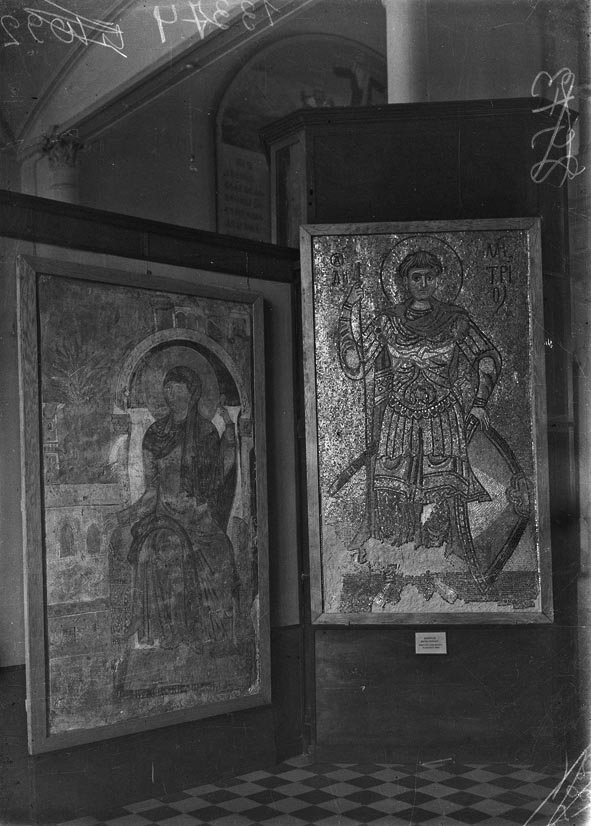
Фреска та мозаїчне зображення Димитрія Солунського з Михайлівського Золотоверхого собору в експозиції Всеукраїнського музейного городка в інтер’єрі Благовіщенської церкви Києво-Печерської лаври. Фотографічний знімок середини 1930-х рр., з колекції Національного заповідника «Києво-Печерська лавра», інв. № КПЛ-Н-3056
Fresco and mosaic image of Demetrius of Thessalonica from St. Michael's Golden-Domed Cathedral in the exposition of the All-Ukrainian Museum Town in the interior of the Annunciation Church of the Kyiv-Pechersk Lavra. Photo of the mid-1930s from the Collection of the National Preserve “Kyiv-Pechersk Lavra”, inventory Nr. KPL-N-3056
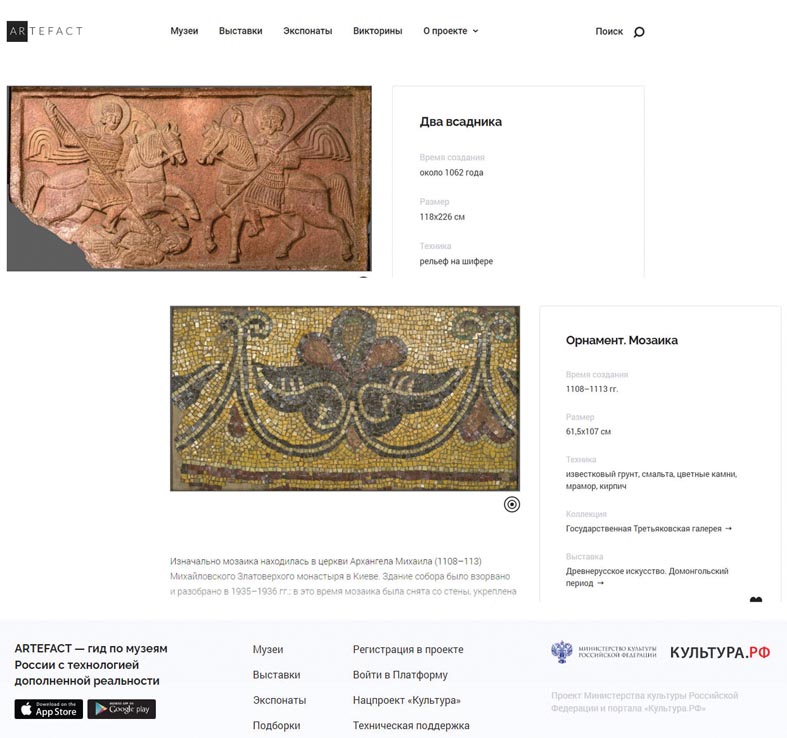



Мозаїки і фрески Михайлівського Золотоверхого собору, представлені на російському ресурсі «ARTEFACT» у розділі «Давньоруське мистецтво. Домонгольський період». Ці пам’ятки монументального мистецтва доби Київської Русі поцуплені росіянами до Третьяковської галереї у Москві
Mosaics and frescoes of St. Michael's Cathedral, presented on the Russian resource “ARTEFACT” in the “Ancient Rus art. Pre-Mongol period” section. The Russians brought these monuments of monumental art of the time of Kyivan Rus to the Tretyakov Gallery in Moscow
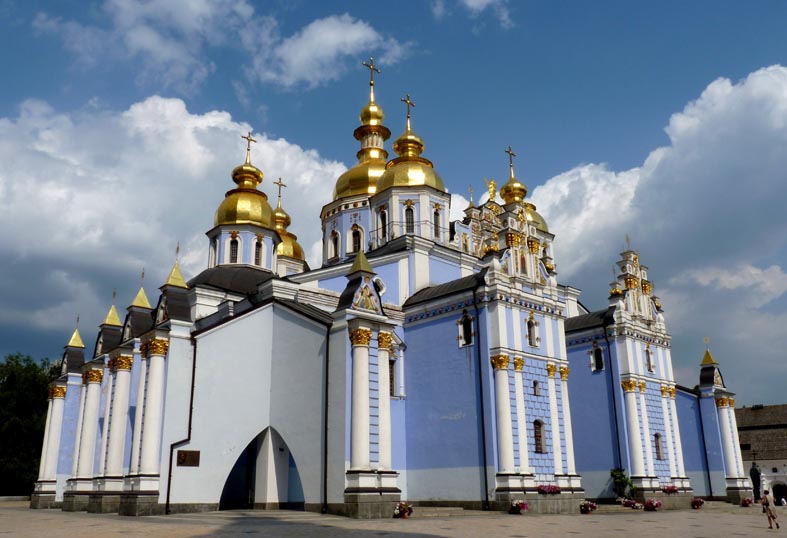
Михайлівський Золотоверхий собор. 2013 р.
St. Michael's Golden-Domed Cathedral. 2013
Джерело | Source: commons.wikimedia.org
23.01.2023
ГАЛЕРЕЯ "Я З УКРАЇНИ. ПОВЕРНІТЬ МЕНЕ ДОДОМУ!"
GALLERY "I'M FROM UKRAINE AND I WANNA GO HOME!"
Проєкт здійснено за підтримки Стабілізаційного фонду культури й освіти Федерального міністерства закордонних справ Німеччини та Goethe-Institut. goethe.de
The project is funded by the Stabilisation Fund for Culture and Education of the German Federal Foreign Office and the Goethe-Institut. goethe.de









